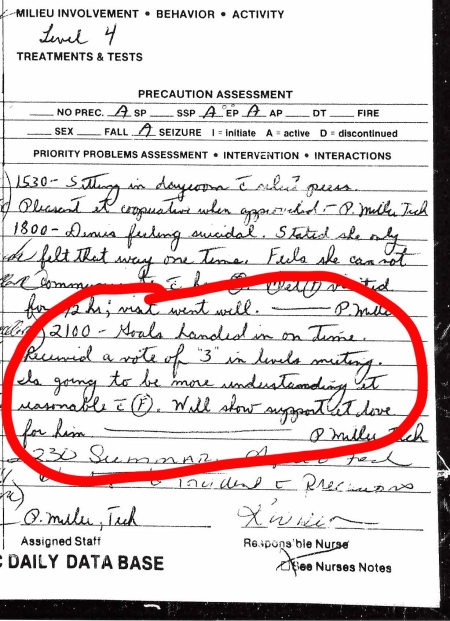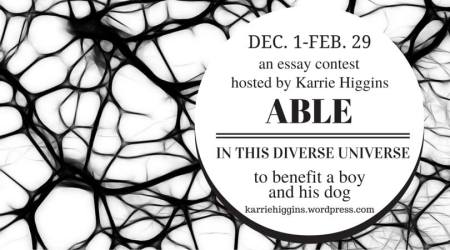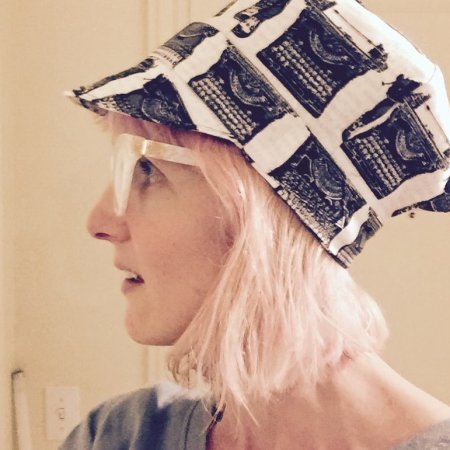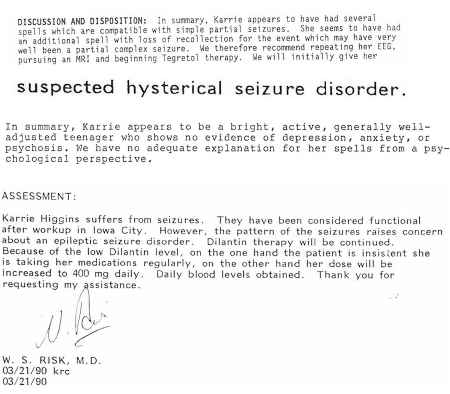If you are looking for more writing from me, check out my Substack, which has been growing steadily over the past several months. I look forward to seeing you there!
Category: Uncategorized
how to get United States military (and sometimes VA) records for an ancestor / family member
People know me as a researcher who pokes around in special collections & archives whenever I can, and so I get a lot of questions on finding documents that aren’t readily available.
The question I get asked the most:
How do I get my (dad’s, grandpa’s, brother’s, mom’s) military records?
The process depends on a few things:
Is the family member deceased?
Are you defined as “next of kin?”
How long ago did they serve?
Which records do you need?
If your family member is deceased, they separated from service LESS than 62 years ago, and you are next-of-kin (daughter, son, father, mother, sister, brother etc), then you need to fill out this form:
You can learn a lot more about the process at the National Personnel Records Center, which is part of the National Archives. It looks like right now they are behind due to COVID, but they have a skeleton crew in place for emergency requests.
You will need to include proof of death, which can be as simple as an obit. I actually used obits every time I needed a record, which both proved the family member had died, and that I was next-of-kin, since I was named in the obit.
If your relative separated from service 62 years ago or longer, the record is now “archival” and you do not have to be next-of-kin. The process is similar, but you will need the instructions on this page.
Sometimes, friends ask me how I got my father’s, uncles, and brother’s VA records, which are not the same as personnel files. These are medical records of treatment in the VA and are protected by HIPAA and other laws. These records are much harder to obtain, for obvious reasons.
For these records, you need Form 10-5345.
I was able to get VA records for a few reasons:
1. For my brother’s, I was next-of-kin, and because my (half)brother had died in mysterious circumstances while facing trial, and I was in the middle of obtaining a genetic diagnosis, I proved sufficient urgent reason to release them. It didn’t come without a bit of struggle, though! I actually had a nerve-wracking phone call with the VA General Counsel, during which he drilled me as to how I held the same standing as another half-sibling who had been listed as next-of-kin in the medical records. Obviously, I satisfied his questions.
2. For my father’s records, it was simple: he died, and my mother had power of attorney. She simply signed my request on Form 10-5345, and they were released.
3. For my uncle, I faced a bit of a battle. I requested them on behalf of my father, so he wouldn’t die not knowing what happened to his (half)brother. It’s a long story, but my uncle was institutionalized most of his adult life, and the family always believed something had happened to him in the Navy. His personnel records had been sealed since 1959, and I secured their release with no issue. His VA records, I was at first denied. However, my father was in a similar situation as I had been with my half-brother. I simply pulled out the letter from General Counsel explaining why I should receive my brother’s VA records, and I told the VA it would be arbitrary and capricious to grant me a half-brother’s VA records under very similar circumstances, but deny my father the same thing. I won! (If I hadn’t won, it turned out my aunt stood ready to sign the form, as she was his conservator, but I didn’t need it.)
If you are next-of-kin, you can also request medal replicas, usually for free.
I hope this helps in your genealogical, memoir, and/or historical research.
a cure for your pain or the biggest fraud since Madoff?
Diagoras, who is called the atheist, being at Samothrace, one of his friends showed him several pictures of people who had endured very dangerous storms; “See,” says he, “you who deny a providence, how many have been saved by their prayers to the Gods.” “Ay,” says Diagoras, “I see those who were saved, but where are those painted who were shipwrecked?”
–Cicero, On the Nature of the Gods
The day after the 2016 election, I was perched on an examination table at the National Institutes of Health Clinical Center for my first appointment in a syringomyelia study. I had mailed the MRI CD showing a silvery cavity from C5-T1 within weeks of my syringomyelia diagnosis, alarmed I might need surgery I could never afford. The study seemed like a good way to get top-notch care for free with the added bonus of contributing to science.
I signed the informed consent for surgical risks: paralysis, loss of sensation, infection, hydrocephalus, repeated surgery–and wondered how in the hell I would answer if the doc said I needed brain and spinal cord surgery thousands of miles from home.
Instead, when I finally saw the study docs and discussed a second syrinx discovered in my thoracic spine, he asked me point-blank, “How awful is your life?”
It sounds terrible typed out like that, but I swear it wasn’t. I got his meaning right away: What’s this thing doing to my quality of life? Is it worth opening up my skull and spinal cord?
“I’m a pretty adaptable person,” I said. “Life is different, but it’s not awful.” I thought about how I used to walk without a mobility aid, how much I missed activities that were off-limits now, the burning electric pain, the weakness in my hands. “It’s not bad. Just different.”
“Then it’s probably not time to operate.”
It wasn’t the sole basis of his decision and I’m leaving a lot out, but the point is: I agreed.
I did not and do not want surgery. I have read the statistics on Chiari-Syringomyelia surgery, and they aren’t great. Some people recover and go on to live free of the pain and functional losses. Others wind up going through the whole shebang a second or third time. Some people’s spinal cords wind up like Swiss cheese:
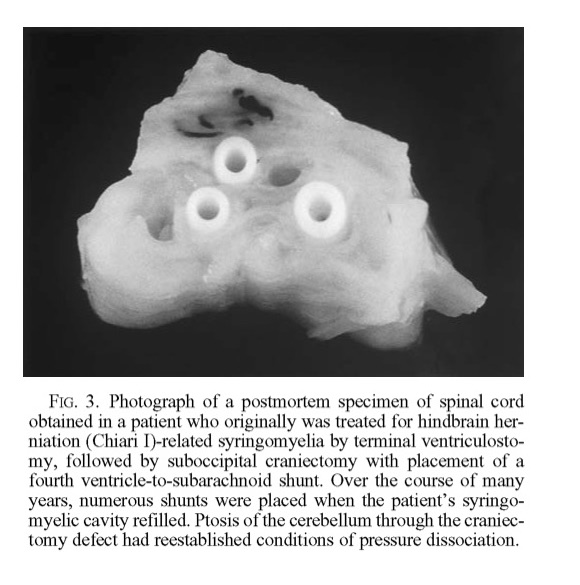
If surgery helps, that’s great. If I can avoid surgery, even better.
That’s just me. I can’t speak for anyone else.
Back in my syringomyelia patient groups, though, total strangers said my doctors didn’t know what the hell they were talking about.
“Post your MRIs,” they said, and I did.
“Oh yeah, tethered cord. Definitely. And craniocervical instability.” I had no idea what they were looking at.
“Your doctors are gaslighting you.”
But I didn’t feel gaslit, at least not about surgery. I had felt that way at the doctor before, but not this time.
I knew better than to argue with a patient support group, though. A few months prior, I got booted out of a local Chiari group because I didn’t want to follow up with their fave rockstar East Coast neurosurgeon who had operated on virtually all of them. I didn’t want to see him primarily because he had operated on virtually all of them. It seemed a little strange to me how the group labeled every other neurosurgeon incompetent. Most neurosurgeons know nothing about Chiari, went the common refrain. Only this doctor can help you.
It’s true Chiari-Syringomyelia isn’t as widely known as it should be, but it’s also true there are numerous quietly competent neurosurgeons out there who can decompress like rockstars, too.
I never imagined with all my skepticism that years later, I would send my imaging to a different superstar neurosurgeon, believing he was one of only 3 or 4 people on earth who could help me.
___
I wish I could remember why or how I finally learned what craniocervical instability is, but to be honest, I think it was Instagram. I had just gotten my Ehlers Danlos Syndrome diagnosis and followed a lot of people with EDS hashtags. It seemed like everyone (not really, of course) was sporting neck braces and flying to New York, Spain, or Maryland to a short list of unicorn neurosurgeons. Only these doctors understand CCI, they all said. Since some of my symptoms weren’t explained by EDS or Chiari-Syringomyelia alone, I decided to check it out.
I chose a neurosurgeon who accepted DICOM files online, filled out his questionnaire, and uploaded my upright MRIs and rotational CT scans.
But here’s the thing: When I got my report back, it didn’t even sound like it was about me. The person on those pages sounded like they were dying. And even though my measurements were not extreme, the recommendation certainly was: fusion all the way down to T1.
Something like this:
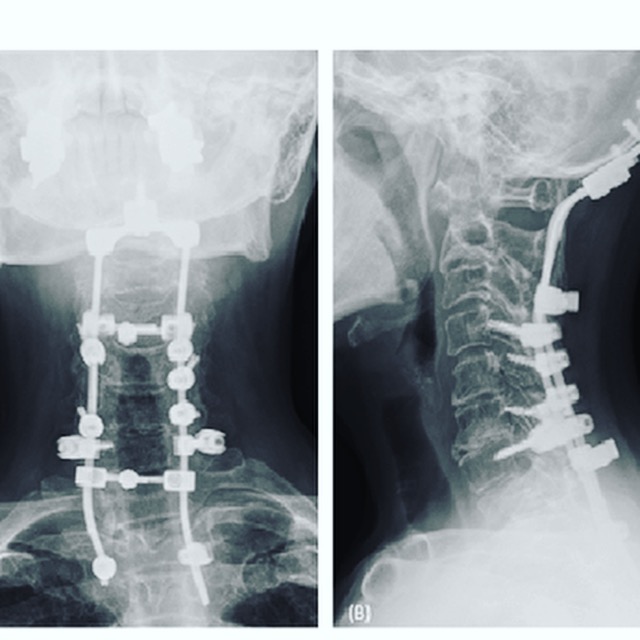
I was terrified. When I contacted the neurosurgeon office to ask how it works if you decide to get surgery, they replied, “We can get you here as soon as next week.”
Next week?
I’ve been hanging around neurology offices long enough to know that “next week” is not normal. It set off every internal alarm. Plus, he wanted cash payment, no insurance.
I contacted my geneticist, got a referral to a local neurosurgeon, and here is how it went:
I loved that doctor. He told it like it was, but he was deeply kind, too. Never once did I feel he blew me off. In fact, he watched me so intensely he noticed few things nobody else had–and got me referrals.
Sometimes a “no” is not gaslighting. Sometimes a “no” saves your life.
Fusion surgery is indeed disabling. Losing range of motion is hard enough, but for someone with EDS, fusing one segment of your already-unstable spine means the next segment picks up the torque forces … and becomes unstable. Next thing you know, you need surgery again.
Thank god I was too broke for rockstar surgeon guy because what if I had the cash, hopped on a plane, and got all that hardware in my spine for … nothing?
And in fact, fast forward a few years, and my unexplained symptoms have explanations now — none of them CCI.
When I tell this story, people get mad. I get it. Plenty of people really do need CCI surgery and I am in no way denying it. At the same time, though, patient groups can make you think a treatment is more successful than it is — or that a doctor is more “rockstar” than they really are.
___
Survivorship Bias

During World War II, planes that survived battle got examined for damage to determine the best spots to place armor.
Abraham Wald objected. Mechanics only saw planes that made it back. What about the planes that got shot down? Look at that damage, and you’ll find the weak spots. That’s where your armor goes.
Survivorship bias: when you don’t see what’s fatal because you never see the fatalities.
Chiari & CCI groups don’t hear from people who settled lawsuits and signed NDAs. They don’t hear from patients who died.
If such cases get mentioned, groups explain them away: Surgeons who take on the riskiest cases are going to have more negative outcomes.
On the surface, it sounds reasonable, but if you go digging, you find stories like then-4-year-old Katie Bryant , who developed an infection and syrinx after neurosurgery she did not need:
“I have good news and I have good news,” the blue-jean clad Bolognese gushed in his Long Island office, sharing Pringles with Katie and her twin brother Brodie.
Katie’s operation, Bolognese reported, was a roaring success. The Bryants heaved another sigh of relief when he said Brodie’s MRI had no sign of Chiari.
Then, Bolognese said something that chills them to this day.
“I think we should do the same [tethered cord] surgery on Brodie so he won’t develop Chiari later on in life,” Bolognese said.
“My husband and I looked at each other in shock, and thought ‘Is he kidding?'” Bryant recalled. “I knew right then and there we had made a terrible mistake.”
Tethered cord, CCI & Chiari-Syringomyelia surgery often go together and Dr. Bolognese is one of the most famous of the “rockstar” surgeons.
You will find patients like Jennifer Ronca, abandoned on the operating table under general anesthesia while her neurosurgeon took off on vacation. Imagine waking up braced for pain and finding out the surgeon never showed up.
The hospital — and many people I’ve encountered in patient groups — contend that case got blown out of proportion. It’s just a sensationalistic, overblown story about normal human error.
That’s what NorthShore Hospital argued, too.
“I cried again,” Ronca told The News when she learned the hospital got off without a fine. “The Health Department never called me to hear the facts from me. It’s just another betrayal.”
Ronca said since the ordeal, she has suffered recurrent nightmares and pain that plunged her into a deep depression, for which she was hospitalized in October.
“I’ve had a lot of issues trying to come to terms with what they did to me. The Health Department just assumed there was no injury,” she said.
And if you start looking for the lawsuits, you will find far, far worse: people left paralyzed or dead, accusations of human experimentation (some of these surgeries and techniques are not standard of care) and more.
If you focus only on the good stories, you miss the risks — and the damage.
I am not out to tell anyone what surgery they need or don’t need. I won’t tell you which neurosurgeon to see. I won’t tell you who to trust. But I can share with you some documents I received from a public records request about one of the most famous surgeons, Dr. Bolognese (not the one I consulted), whose name appears on every list and has been promoted by the EDS Society:
https://www.dropbox.com/s/l8x5jelirr30tol/BologneseNYDEPTHealthReadableText.pdf?dl=0
A quote from that document^:
“This program may represent one of the biggest frauds in the history of modern neurosurgery, of “‘Madoff’-like proportions.”
Remember what my local neurosurgeon said: I’d call it a bank transfer.
Read for yourself and decide. I can’t tell you what to think and I won’t. I have no personal experience with this particular doctor and no vendetta. His name comes up a lot in CCI circles and there just happens to be a lot of press out there about him. I want people to know the information is out there. All you have to do is look.
And there are plenty of neurosurgeons — maybe even a local or semi-local one if you’re lucky — who can help you. It’s not true you have to choose from the unicorn list. You have options. (Adding a note here: I understand the picture may be different outside the U.S., especially with nationalized healthcare systems.)
Here is my advice:
If you decide to pursue CCI surgery, get a second opinion. Heck, get a third. If possible, get at least one consult at a research hospital. No matter what: Do not rush to go under the knife for anyone who won’t take insurance. If a surgeon doesn’t take insurance, think of it as a red flag — maybe nothing is amiss, but maybe something is. File public information requests for complaints. Search court databases for malpractice suits and read the cases (oh my god, the cases). Information is power.
Your neck & spine are the only ones you’re ever going to get. Be cautious. Be wary. Inform yourself.
Note: Later, I will update this post with a Dropbox folder with more information. I want to include some of the lawsuits, but even though they are technically “public,” I don’t think the patients imagined a day where someone would retrieve the cases and blast them on the Internet. Redactions are in order. I’m working out some technical issues and will upload then or perhaps do a second piece.
The truth is the most important thing
“If we have truth, it cannot be harmed by investigation. If we have not truth, it ought to be harmed.” -J. Reuben Clark
In my opinion (And I ‘know’ I’m right!)
The Book of Mormon can best shed its light
at four-fifty-one degrees Fahrenheit
–poem written by Mark Hofmann in prison
___
Eight years ago, I was digging around in an archive of the Mark Hofmann forgery & bombing case in a library in Salt Lake City, when I found a letter he wrote to his mother dated April 29, 1979. I recognized it immediately as one that had been quoted by Allen D. Roberts in Dialogue: A Journal of Mormon Thought:
As a college undergraduate, Mark wrote a theme in the form of a letter to his mother. In it, he protested what he saw as Church duplicity and secrecy, particularly surrounding its history. Writing with the arrogance and absolutism commonly associated with youth, he suggested an obviously felt chasm between what Church members really think and how they participate in the Church. He insisted that the Church could withstand the exposures of history, that honesty was best for individuals and organizations. It is telling that he did not express his own religious beliefs.
On 29 April 1979, the date on that letter, Mark Hofmann had already tried his hand at forging. He was familiar with both traditional and highly critical approaches to Mormon history. He had delved into many “mysteries” and, through his systematic reading in special collections, was delving into more. He wrote to his mother, “My conviction is that the truth is the most important thing. Our idea of reality of should be consistent with it.”
As a writer who had done a deep dive trying to understand Hofmann — learning to make ink, to forge (for the book–not real life), to age documents, even undergoing hypnosis and taking a lie detector because he had taken one (and passed)– that line had haunted me: The truth is the most important thing.
And it has haunted scholars, too: Is this Hofmann’s motive? Did he believe he was on a mission for truth?
Allen D. Roberts, in the same Dialogue essay:
The question of whether Hofmann created history-challenging documents for financial gain or whether his agenda included the undermining of Mormonism through its historical Achilles heel deserves close scrutiny. This is especially true since the Hofmann documents have had great impact on how many perceive Mormonism and their own lives in relation to it.
It is the intent of this paper to explore the question of motive in the forgery of early Mormon holographs. At the onset, I want to make it clear that I accept Hofmann’s confessions, together with the extensive forensic evidence presented in the preliminary hearing of April and May, 1986, along with the research that Linda Sillitoe and I have done, as documentation that all the key documents dealt by Hofmann, as well as numerous others, are forgeries.
Hofmann’s forged Americana, including the “Oath of a Free Man,” fit as neatly into American history as his early documents did into Mormon history (Interviews, Exhibit Q ) . None contained revisionist content, and many were highly profitable. Why, then, since Hofmann could make money from either testimonial or controversial Mormon documents, did he produce documents of a revisionistic nature — which were actually impossible to sell to some of his best customers?
Hofmann, after all, forged many documents that were true — not factually true (fake documents are inherently anti-fact), but true in a capital T sense. Take his biggest forgery: The Salamander Letter. In it, he portrayed Joseph Smith as a money-digging magician–facts long suppressed by the Church of Jesus Christ of Latter-Day Saints.
That’s right: Nothing Hofmann “exposed” was new. Fawn Brodie got excommunicated by the LDS Church in 1946 — forty years before Hofmann murdered Kathy Sheets and Steven Christensen with pipe bombs to cover up his forgery schemes — for writing No Man Knows My History, in which the truth about Joseph Smith as a money-digging con artist magician was laid bare.
Open secrets.
Hofmann had the chops to be a scholar like Brodie. Instead, he planted evidence to prove what he “knew” to be true. “I believe the documents I created could have been part of Mormon history,” he said. “In effect, I guess the question I asked myself in deciding on a forgery, one of the questions was, ‘What could have been?’ In a way, he was hacking the Mormon testimony: A burning in the bosom should be ignited by faith, not forensics. What if your testimony rests on the authenticity of a letter?
As for my deep dive: I became obsessed by the idea of forgeries that were “true.” I wanted to forge my brother’s confession for his crimes, but unlike Hofmann, I would be honest about it.
I learned to make ink, forge handwriting, and age documents, all from Hofmann’s confession. I got handwriting exemplars from my brother’s Army records, VA records, and high school yearbook. I bought period-correct greeting cards. Once, I burned one of my elementary school stories, collected the carbon, and used it for ink: one of Hofmann’s processes. The forgery process formed a kind of meta-commentary on what it’s like to survive a crime for which there is no evidentiary proof, no criminalistics, only your word — something others have to take on faith. Maybe even something they know is true, but they suppress.
But back to Hofmann’s letter: When I finally got access to the full text in that library archive, something didn’t feel right. At first I was impressed by his eloquence and maturity, the way this young man engaged his mother in an in-depth discussion on institutional honesty. The more times I read it, though, the more it set off all my alarms as a college composition teacher: something in the voice & syntax didn’t sound like Hofmann. I had no evidence, just a gut feeling. I typed some of the text into Google, but no source material came up–not yet.
Later that same year, I got my proof. Here is a letter I wrote to a Mormon scholar at the time (edited for length):
I believe I have discovered a case of plagiarism by Mark Hofmann that has not yet been noted in any scholarship.
During research for a book, I visited Special Collections in the Marriott Library … I found the full text of a letter written by Mark Hofmann to his mother, dated April 29, 1979, in which he makes the case for personal and institutional honesty within the Mormon Church. Like others who have read this letter, I found it fascinating both in terms of the glaring contradiction between Hofmann’s beliefs expressed in the letter and his actions as a forger and murderer.
The content of the letter creates the impression that Mark Hofmann may have had a larger agenda with his Mormon document forgeries—as though he were crusading for “truth.”
I was struck by the letter’s eloquence, but I also noted how it did not seem to be his voice. As a writing teacher, I am finely tuned to shifts in voice that signal plagiarism. I told my husband that if Hofmann had turned this in for an assignment in my Composition class, I would have immediately suspected plagiarism. Since other scholars seemed to accept it as his genuine composition, however, I tried to wrestle with its implications in the context of his crimes. I, too, wondered what it meant in terms of any agenda he might have had.
Fast forward to September 2013. I was listening to the Mormon Matters podcast episode about the Ordain Women movement, and at the bottom of one of the pages, I noticed a link to a collection of essays by Frances Lee Menlove entitled The Challenge of Honesty and edited by Dan Wotherspoon.
I cannot explain how, but I just knew Hofmann had plagiarized that letter from one or more of those essays.
And I was correct.
See the attached text of Hofmann’s letter with my underlining where I have discovered outright copying or paraphrasing of Menlove without attribution, all from the first essay in Wotherspoon’s collection, entitled “The Challenge of Honesty.”
Frances Menlove published “The Challenge of Honesty” in the Spring 1966 issue of Dialogue. Mark Hofmann wrote his letter in 1979. We know Hofmann read issues of Dialogue from 1966 because he cites other articles from 1966 issues of Dialogue within the very same letter. [Side note: Later I discovered further plagiarism from other sources published in Dialogue.]
The letter is essentially a patchwork of plagiarized text from Menlove’s essay. Interestingly, Mark Hofmann gives credit to other sources within the letter, but not to Menlove. As a college writing teacher, I can assure you that this is a very common technique students use to hide plagiarism: citing supporting evidence for an entirely stolen argument. After all, the good argument is the hard part.
While a small footnote to the Hofmann saga, the find is significant, in a way, because so many people believe Hofmann was waging some kind of “truth” crusade against the church, and documents like that letter have added fuel to the fire. They sort of puff up that mythical image. And yet, here Hofmann was, unable to muster his own original words for what honesty means.I suppose a conspiracy theorist-type thinker might respond by saying, “Well, he still found those words valuable enough to steal.” To me, however, stealing those words is a very different thing than actually composing them. He quite literally had no words on the subject of honesty. It is almost as if he was planting this “evidence” of his mythical self way back in the day before he upped the ante, forging his own motives or something.
There is something very … what’s the right word here? poetic? … about catching Hofmann in something by digging around in special collections, too. I mean, that was his stomping ground for his schemes.
To my knowledge, no scholars have uncovered this plagiarism as of yet. In the cases where the letter has been cited or analyzed, no mention of plagiarism has been made:
In Dialogue: A Journal of Mormon Thought, Allen D. Roberts, one of the co-authors of Salamander, described this same letter … it seems clear to me that Allen Roberts took this letter to be an original composition by Mark Hofmann …
In the book Salamander by Linda Sillitoe and Allen Roberts, the letter is also mentioned, on pages 229-230 of the paperback 2nd edition. On page 230, Sillitoe and Roberts write:
On paper, Hofmann’s plea for honesty was eloquent, though not, in itself, factual. In a highly rational format, he was confronting his mother on a deeply emotional subject. He spoke of a dilemma—a person who lived in two worlds because doing otherwise was neither possible nor acceptable. He proved his point by not mailing the letter. He kept it.
The “non-factual” aspect referenced in the above paragraph is a false story Hofmann tells in the letter about meeting with Church Historian Leonard Arrington. The letter itself, however, is taken as Mark Hofmann’s own writing (an “eloquent” “plea”).
Given that no Internet existed at the time for easy access to back issues and plagiarism-checking, and that Menlove’s essay would have appeared some 13 years before Hofmann wrote his letter and 20 years before scholars would have even been analyzing Hofmann’s writings, it is understandable that this plagiarism may have gone unnoticed. I just happened to have read Hofmann’s documents in a very compressed timeframe, comparatively.
So what did it mean that Hofmann plagiarized this letter to his mother–that a document widely believed to reveal his “motive” wasn’t even his own words? Was I correct that he intended to plant this letter to “forge” a motive? After all, he never even mailed it.
The late Linda Sillitoe, co-author of the book Salamander, might have said Hofmann scholars are asking the wrong question. In a talk entitled “Salamander: A Homespun Tragedy,” she dissected “a rift between the opinions of those who consciously or unconsciously believe that the forgeries are, in fact, more significant than the homicides” and those so disgusted by the bombings that the forgeries are neither interesting nor relevant.
“I often wonder,” she said, “whether that rift is caused by a sense that religious belief, or history, or ideology, is more important than individual lives? Or is it that murder is a messy, not-nice business, while forgeries are cleaner, rational and intellectual?”
Is truth the most important thing?
Which truth?
The 1979 letter is less a statement about Hofmann, and more one about us: a Rorschach of sorts. Why are we laboring so hard to ascribe motivation to the forgeries, when this man committed brutal murders using pipe bombs to cover them up? Nobody is saying it’s worthless or wrong to wonder about a motive for the forgeries, just that it says something about us when we center it.
By this time, I had been writing letters to Hofmann for a few years, often penned in his own iron gall recipe. I talked to him about my project with my brother, about inks, about magic. I wrote a letter to him about his plagiarism, too–not asking him why, not asking him what it meant. I just wanted him to know that I knew.
“Aren’t you afraid to send it?” a friend asked. “I mean, he tried to put a hit on investigators from prison.”
“No,” I said. “I think he maybe even wanted to get caught.” It wasn’t just that I wanted him to know that I knew; I wanted him to know I was the one who caught him, that I was just as good at digging around in archives as he had been at the height of his forging.
And the truth is, some part of me still believed him that he panicked when his forgeries were about to be found out, that he wasn’t a cold-blooded killer by nature. It took a stopwatch at the crime scene & a recording of his Board of Pardons hearing to make me see the truth:
For a long time, I bought Mark Hofmann’s explanation about the bombings: that he cracked. That he wasn’t a violent, murderous person by nature–that he just lost it when he thought he’d be exposed as a forger.
I think I needed to believe him.
He blew up his own car with a third pipe bomb, shattered his kneecap, and claimed it was a suicide attempt. Was this repentance?
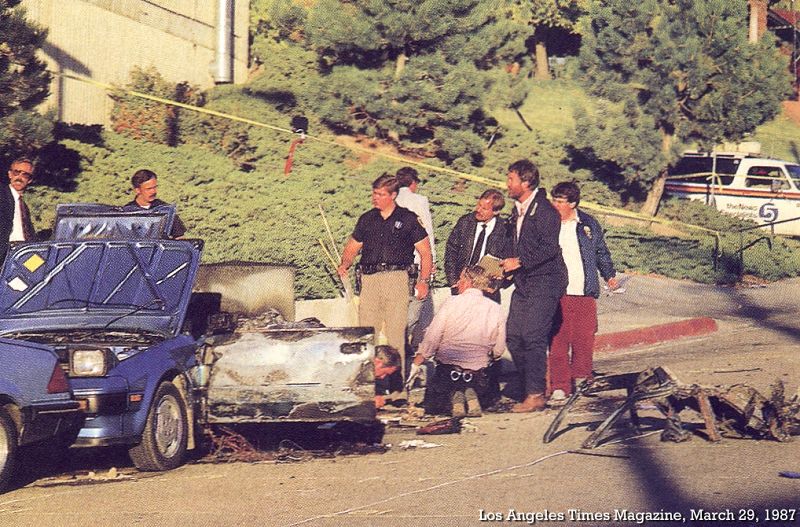
But I had lingering doubts, too. I went to the Judge Building to retrace his steps on October 15, 1985, the morning he planted a bomb that killed Steven Christensen–purchaser of the Salamander Letter on January 6, 1984 for $40,000.

I kept a notebook of decisions Hofmann made at every step.
Decision #1 Entering the Judge Building. Under his left arm, he cradled the booby-trapped package.
Of course, Hofmann disabled the mercury switch for his own safety, ice-picking a hole in one side and taping one wire outside, cutting off the circuit. When he delivered the package to Christensen’s door, he unstuck the outer wire, threaded it back into the hole, and completed the switch.
Decision #2 I press the call button. I am not ringing an elevator; I am ringing the doorbell to a time machine. In the preliminary hearing, witness Bruce Passey said it took 3 to 4 minutes from the time Hofmann walked in to the time the elevator dinged.
Set a timer to 4 minutes: it’s a long time to not change your mind.
Decision #3 A young law clerk slices his hand through the closing doors, as if slitting an envelope seal. At first, I feel like he is intruding on my private correspondence with Hofmann. I wanted to do this alone. Then I realize: he is my Bruce Passey. That is the difference between secrets and history: in history, there is always a witness, always corroboration; otherwise, how does it become history?
“What floor do you want?” He says.
I start to say 6, and I correct myself. Hofmann pressed 5 on that morning. Then, when everyone exited and he had the car to himself, he pressed 6.
“Five,” I say. “Thanks.”
I feel a shiver when he presses 3. That was the same floor Bruce Passey chose on October 15, 1985.
Decision #4 Law clerk out of sight, I press the call button for 6th floor.
Decision #5 The ride takes 50 seconds, during which I do not change my mind.
Decision #6 On the 6th floor, I exit the elevator and turn right, toward suite 609–or what used to be suite 609 in 1985. The doors have changed numbers now.
Decision #7 If today were October 15, 1985, and I were Mark Hofmann, I would be watching insurance agent Janet McDermott from suite 610 as she knelt and almost picked up the box labeled To: Steve Christensen in black magic marker.
“What kind of an expression was on this person’s face?” Prosecutors asked her at the preliminary hearing.
“Noncommittal expression. They weren’t angry at me; they weren’t smiling at me. There was no recognition.”
No recognition. Hofmann knew if she touched that bomb, she would be blown to bits, and he said nothing—did nothing.
Decision #8 Walk away. Leave the bomb for someone to find.
So many moments to turn back. So many times he could have spared Steven Christensen’s life.
And the other bomb? That one killed Kathy Sheets, unlucky wife of Hofmann’s real target, in her own driveway. It had a flaw in the mercury switch. Hofmann knew it, and he left it to fate. It didn’t even have to go off for his plot to succeed: all he needed was someone to find that bomb, throw the cops off course in the investigation of the Christensen murder. From Hofmann’s Board of Pardons hearing:
Transcript:
Hofmann: At the time, I rather, well, as strange as it sounds, it was almost a game as far as, uh, I figured there was a 50% chance it would go off, a 50% chance that it wouldn’t.
Q: It seems to me that a man who created the kinds of documents you create, well, you have a knack for things technical. It seems to me that a man with that sort of technical know-how could ensure that detonator had not gone off, and you could have served your purpose without killing Mrs. Sheets. Was that on option?
Hofmann: It was certainly an option. At the time I don’t think I considered that. Like I said, it was almost a game as to whether it would or wouldn’t.
Hofmann: What I had hoped would happen is that nobody would die by that bomb.
Q: But you knew that it was possible that anyone might die by that bomb, that a child walking by the garage might die by that bomb.
Hofmann: My thoughts at the time when I made that bomb, my thoughts were it didn’t matter if it was Mr. Sheets, a child, a dog, you know, whoever.
A child, a dog, you know, whoever.
The truth is the most important thing. Our idea of reality should be consistent with it.
Looking back now, I wonder if when Hofmann wrote that letter in 1979, he not only planted the evidence for his own motive, but for the complicity of people who wanted to find it.
Lena Dunham & the fetishization of #hypermobility CW: CSA, abuse, medical trauma
CW: CSA, abuse, medical trauma
In a recent profile in The Cut, Lena Dunham characterized her mixed connective tissue order as making her “flexible” and “the reason she is good at sex.” (She has also mentioned Ehlers Danlos Syndrome previously, though not in The Cut profile. People can have both.)
There are so many problems here it is hard to begin.
First, hypermobility and flexibility are not the same thing, and conflating them harms people with CTD diagnoses and those in diagnostic limbo. It might seem like splitting hairs, but in reality, it can delay diagnosis for years or decades. Hypermobility means joints move easily beyond normal range of motion, often leading to partial dislocations called subluxations, or full dislocations, when the joints must be reduced back into place. Not all people with CTDs experience dislocations, but many do.
Flexibility is in the muscles, not the joints.
As Murray Meetze writes on Uniquely Striped:
As hypermobility goes up, flexibility can often go down. As is the case for me, muscles can tighten while attempting to stabilize hypermobile joints. Many with EDS, including myself, have extremely tight hamstrings, even in childhood, as the hamstrings try to protect the hypermobile spine and joints. Can EDS patients be extremely flexible? Absolutely. But, flexibility is not what doctors should be assessing when EDS is up for diagnostic consideration.
An example of hypermobility:

Notice that doesn’t look like “flexibility.” In fact, I am stiff!
In my case, my muscles stiffened up so much over the years that I didn’t realize my subluxations and dislocations even were hypermobility. I thought you had to twist into a pretzel like performers in Cirque de Solei to get a diagnosis. In fact, during my first visit at NIH for a Chiari-Syringomyelia study (a known comorbidity to EDS), I was asked, point-blank, “Are you hypermobile?”
I did not yet fully understand what it meant. I started to tell them about some of my joints (with documented dislocations going back to birth all through childhood & still today), but I feared they would “make me show them how bendy I was” and since I “wasn’t flexible,” they would laugh at me. It added another two years to my diagnostic wait!
It turns out I score 6 on Beighton (the test used to score hypermobility) now, but a 9 if you had tested me years ago. Some of that change is aging; some is stiffening from syringomyelia and muscle tightness to hold my joints together.
Some folks with CTD are super flexible; some are tight. It is different from hypermobility and not part of the criteria. And yet, many doctors think I am flexible and are surprised how stiff I am. It makes them question my diagnosis, even though an expert geneticist at a dedicated connective tissue clinic gave it to me.
And by the way, connective tissue disorders mean a lot more than hypermobility. For me, it has caused craniocervical instability which will eventually require surgery fusing my cervical spine; an aortic aneurysm and congenital heart abnormalities, including an atrial septal defect; severe pain; loss of function of many joints after so many dislocations; Chiari-Syringomyelia; my deafness that requires hearing aids (hypermobility affects joints in the ears, too!); mast cell activation disorder; unrelenting fatigue; migraines & other headaches, facial pain, TMJ, urinary tract issues; severe digestion problems; eye problems; a lifetime of painful dental issues + a high, arched palate … and the list goes on.
Connective tissue affects every system in the body, so boiling it down to “I’m flexible” erases the real experience of a CTD.
So that is one thing.
The fetishization is far worse. Many of us with hypermobility have dealt with leering & inappropriate comments from medical professionals, strangers on social media, and even intimate partners–as well as abuse that is both because of our hypermobility and covered up by it.
Don’t forget that Dr. Larry Nassar abused U.S. Women’s Gymnastics team members primarily by using Ehlers Danlos Syndrome as an excuse: “One gymnast, Melody Posthuma Van der Veen, claims that he told her she might have EDS because he was able to ‘put his whole hand’ inside of her, the Huffington Post reported in a tweet.”
Lena Dunham seems unaware of the harm she perpetuates with her “makes me good at sex” comment. Perhaps it is her privilege in having access to the best doctors, the best care, and even a huge platform. Most of us do not live like that. Perhaps she really believes it makes her good at sex. I don’t know. For me, it causes pain with intimacy: I can dislocate & sublux in my sleep, let alone during sex. I am not alone.
When I was a child, my doctors knew I was being abused. My father was under active investigation, which is documented in my medical records, meaning: doctors definitely knew. They diagnosed me with PTSD and were highly suspicious of sexual abuse. My parents would shift from refusing to believe my diagnoses–calling them “psychosomatic”–to using them to cover up injuries.
Meanwhile, I caught on at a young age to medical appointments being forensic investigations in disguise. If I talked about the abuse, I had no shot at epilepsy care. To neurologists, if you have abuse trauma, your seizures must be psychosomatic. Never mind that epileptic & disabled children face much higher rates of abuse. It can be both.
I knew if I talked too much about my pain, I also could be denied my epilepsy meds, as the doctors had long since decided I couldn’t have epilepsy and dislocating joints and pain, etc. (Now we know they are all, in fact, connected.)
If I didn’t talk about the pain, I wouldn’t get care for it, but I might have a shot at keeping my epilepsy meds. But then: no care for the pain!
Sometimes, even I wasn’t sure which injuries & pain were abuse and which were my disabilities.
Which is why Lena’s comments are so dangerous. Some medical professionals prey on this confusion to build careers as forensic experts. One doctor, Michael Holick, works feverishly to diagnose children with EDS to get parents off the hook for abuse charges.
The problem? Dr. Holick never (or rarely) examines the children in person; hypermobility is common in children so diagnosis of EDS usually isn’t made until later; and his theory about bone fractures does not fit well with EDS. While it is absolutely true that childhood EDS injuries could be mistaken for abuse, Dr. Holick seeks & finds EDS in almost every case, with no examination. He also seems to forget, again, that disabled children face higher rates of abuse. It can be both–and often is.
Many disabilities are fetishized and have been throughout history. There is even a word for an able-bodied person who fetishizes disabled bodies: a “devotee.” When I read Lena’s comments, I wondered: Had she ever even cracked open a disability studies text, or read disabled voices who are talking about these issues? She barges in with her huge platform, becoming “the face” of these illnesses, without (it seems) taking time to respect disabled activists, artists, and writers who have been doing the work for disability justice.
For BIPOC people with CTDs, the fetishization and conflation with flexibility can inflict even longer diagnostic delays due to medical racism, as well as greater danger of abuse & assault.
Lena Dunham might have been joking, and there is certainly nothing wrong with using humor to cope with illness, but some jokes are harmful and have real & lasting consequences. I hope she will use her platform more responsibility in the future, but I don’t have much hope.
The Bottle City of God
originally published in The Cincinnati Review, 11.1 (2014), winner of the Schiff Award for Prose (2013)
My first summer in Zion, the Mormons deliver a latter-day miracle.
A grasshopper plague is encroaching on a town somewhere out there in the vast Utah emptiness, on the other side of the Great Salt Lake: two thousand grasshopper eggs to the square foot, little exoskeletons bursting into being from thin air, like popcorn kernels on a hot burner.
Local news Channel 4 bears witness: Every ten years, the grasshoppers come. Like clock work.
As an outsider, a Gentile, I have made this reporter my hierophant. The Mormons have their Prophet, Seer, and Revelator, and I have a newsman. I never watched local news before moving here.
The plague is supposed to happen.
Backyards are popcorn machines, pop, pop, pop.
Insecticide has failed us.
The seagulls — the same birds that saved Mormon pioneers from the grasshopper plague of 1848 — have forsaken us. But not all of us. One lone believer prayed for a miracle, and seagulls swooped in to devour the pestilence. “It was my faith,” she says. “The seagulls came because of my LDS faith.”
LIVE FROM GRANTSVILLE, UTAH: God has not forsaken us in these latter days. We are still his people, the peculiar people.
But what if the miracle is the other way around? What if the miracle is the grasshoppers?
“I want hard times,” Brigham Young proclaimed, “so that every person that does not wish to stay, for the sake of his religion, will leave.”
The plague is supposed to happen.
___
Zion is not a city. It is a terrestrial docking station for the heavenly Zion when it descends at End of Times. I used to imagine it hovering like the mother ship in Close Encounters of the Third Kind, a glittering, saucer-shaped metropolis in the clouds, skyscrapers sprouting out the top, twinkling lights arranged around a center iris. When Zion appeared, the golden Angel Moroni statue atop the Salt Lake Temple would come to life, blow his trumpet, and herald the apocalypse. The temple spires would light like a runway control tower, signaling to God: This is the place.
I committed the classic Gentile mistake: ascribing too much power to God and not enough to humanity. Zion does not wait passively like a lightning rod. It is not a candle in the window for Heavenly Father. It is a writ of extraordinary relief, a direct appeal to the highest authority: Appear in our jurisdiction. Heavenly Zion “can come only to a place that is completely ready for it,” Mormon scholar Hugh Nibley writes in Approaching Zion. “When Zion descends to earth, it must be met by a Zion that is already here.” The world does not end because we are bad; it ends because we are good.
Latter-day in the Church of Jesus-Christ of Latter-day Saints means last days. Mormons must concentrate at all times on the end, as Zion does. It is why they stockpile macaroni and cheese, Cheerios, powdered butter and milk, soup, water, toothpaste, candy, shampoo, deodorant, gasoline, generators, flashlights, batteries, and bullets. Their minds and hearts must be microcosms of the City of God.
Like attracts like.
One Mormon becomes an object of fascination on CNN when he shows off his underground bunker blasted into a mountain slope, stocked with canned food, firearms, and gold for the apocalypse — not because he fears it, but because he wants it. He does not pray, “Spare us.” He prays, “Give me advance notice.” He is leaning air stairs against the stars.
Since moving to Salt Lake City, my husband and I have started our own stockpile in a spare room: twenty-five pound buckets of oats, butane canisters, a portable stove, gallons of water, batteries, flashlights. We started it because the city is overdue for a catastrophic quake along the Wasatch Fault, and when the fault ruptures, the east benches will drop off the mountains, tilting the valley floor like a pitcher, pouring out the Great Salt Lake.
“Americans hate the Mormons,” I say to my husband after a news segment about the fault. When we first arrived here, Facebook friends regularly posted polygamy jokes on my wall. One called the Angel Moroni the Angel MORON-i. “Nobody will save us.”
Not long after that, my husband purchases an AR-15 and locks it in a gun safe. In a backroom closet, he stacks ammo boxes like bricks.
Can a city, by its very design, make you long for the apocalypse?
___
The Mormons have a saying: As long as you can see the temple, you are never lost. They mean this literally. On Salt Lake Temple, the Big Dipper carved into the west tower is in perfect alignment under Polaris, the North Star. As Polaris sits at the center of the clock dial of the stars, the temple sits at the center of Zion. The temple is meridian zero: the point from which all streets radiate, a spiritual and navigational compass. Almost every downtown address expresses latitude and longitude in relation to it: 200 S 500 E translates to two blocks south and five blocks east of the temple.
As long as you live in Zion, you know how far you have strayed from Heavenly Father — and how to get back to him. In this sense, as Nibley describes in the Meaning of the Temple, the temple is the “knot that ties heaven to earth, the knot that ties all horizontal distance together, and all up and down, the meeting point of the heavens and the earth.”
In the temple, man climbs back to the presence of God through the endowment: washing and anointing; a ritual drama of the creation and the garden of Eden; learning the signs, keys, and tokens to reach Heavenly Father in the afterlife, and finally, passing through a veil into the Celestial Room, symbolizing the presence of God. It is the fall of Adam in reverse. It is atonement.
“Notice what atonement means,” writes Nibley: “reversal of the degradative process, a returning to its former state, being integrated or united again — ‘at one.’ What results when particles break down? They separate. Decay is always from heavier to lighter particles. But ‘atonement’ brings particles back together again. Bringing anything back to its original state is at-one-ment.”
Atonement is the opposite of entropy, the opposite of the natural order of things, the Second Law of Thermodynamics, which dictates that things fall apart.
The temple, then, is an anti-entropy machine.
This is also why Joseph Smith — he would say God — designed Zion to be so compact and dense: one square mile, a maximum of twenty thousand residents; ten-acre blocks with twenty half-acre lots each; eight people per lot. “When the square is thus laid off and supplied,” he declared, “lay off another in the same way, and so fill up the world in the last days” — a divine urban-growth boundary. He knew if Mormons strayed off the plat, they would wander off God’s map and onto man’s. Zion would dissolve. The center could not hold.
___
In Salt Lake City, vandals mount insurrections on the crosswalk poles:
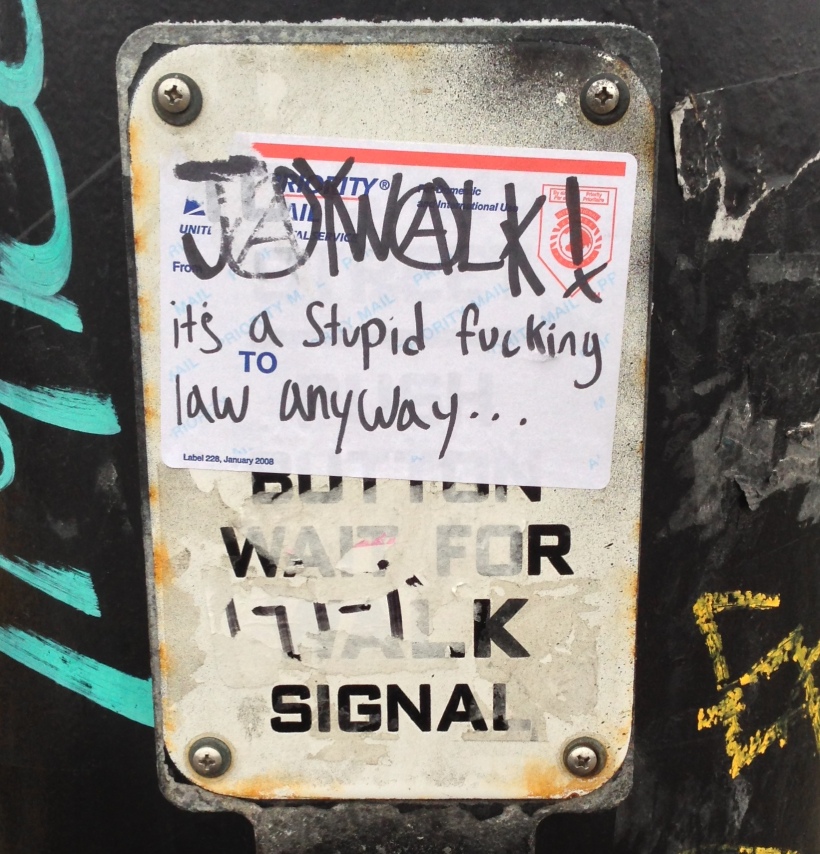
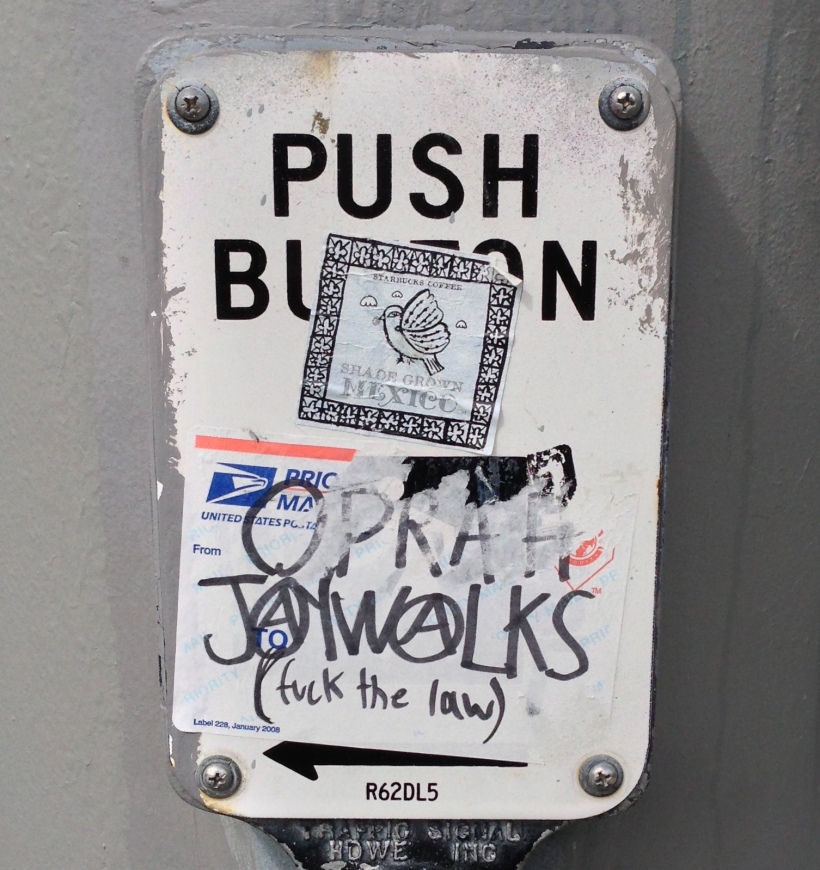
JⒶWⒶLKS
(fuck the law)
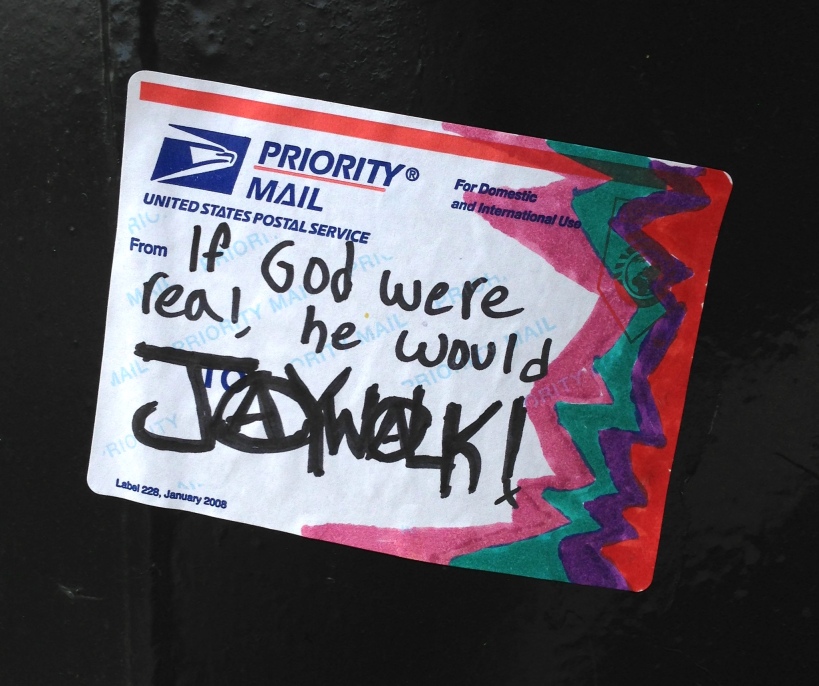
Crosswalks are Zion’s Achilles’ heel, the intersection of what was and what is. When Brigham Young designed the streets 132 feet wide so oxen team drivers could turn around “without resorting to profanity,” he did not know he had exposed Zion to a fatal flaw: “wide, wide forever wide streets,” as Norman Mailer described them, ready-made for cars. The automobile was the anti-temple, a force of entropy destabilizing Zion’s crystalline structure. Zion dissolved, sprawling across the valley. The center could not hold. The population of Salt Lake City today: 189,314. Population of the metro area: 1,126,982. How many of those people can see the temple — actually see it?
“Even the smallest impurity or flaw in anything designed to continue forever would, in the course of an infinite stretching of time, become a thing of infinite mischief,” warns Nibley in What is Zion? And yet, Joseph Smith received the designed of the Zion Plat by divine revelation, and Brigham young was his spiritual heir — a Prophet, Seer, and Revelator, too. How could God telegraph to his chosen people a blueprint tainted with a fatal flaw?
I am, of course, committing my classic Gentile mistake once again: ascribing too much power to God and not enough to humanity. Zion can only come to a place completely ready for it. The streets had free will paved right into them from the start: You can U-turn. You can turn away. People chose cars, not God’s blueprint. Today, Salt Lake City is so car-obsessed that pedestrians risk life and limb to cross downtown streets. The city resorted to installing cups containing hazard flags on the crosswalk poles. Signs implore, “Take one for added visibility.” I refuse to submit to that lie.
At first, when JⒶWⒶLK appears on poles in my neighborhood, the graffiti seems like a force of entropy, too. If God were real, the vandal writes, tipping his hand: He is a nonbeliever, inciting pedestrians to revolt. And yet even he longs for the original Zion, the one designed for God’s people — emphasis on people — not cars.
Maybe, just maybe, the blueprint contains no flaw at all. Maybe this was supposed to happen. “One does not weep for paradise, a place of consummate joy,” writes Nibley, “but only for our memory of paradise.”
How can you atone without falling apart?
___
We are not canaries in the coalmine. Stop driving for the fucking air! — gas station graffiti

In winter, Zion becomes the bottle city of Kandor: entombed inside a fortress of solitude, breathing its own private atmosphere. The same mountains that insulated pioneer Mormons from persecution in 1847 turn traitor, trapping cold, stagnant air in the valley. Warmer air floats over their peaks, sealing the city inside an invisible bell jar. Meteorologists call the phenomenon an inversion because it flips the natural order: cold air near the ground and warm air high above. Heaven and earth trade places.
Here in the Bottle City, soot and particulates from power plants, automobiles, oil refineries, incinerators, and wood-burning stoves build up like exhaust in a locked garage, thickening into smog so dense it leaves a film on my teeth and hair, so caustic it sears my tonsils and throat. It tastes like a dirty penny. It gloms on to my vocal cords, corroding them until I sound like an old menthol smoker. Sometimes I cannot speak at all. My nostrils burn. My snot thickens into acidic goo.
Under the bell jar, the city is airless, windless, a kind of vacuum. Sound ceases. Winter birds hop along tree branches, beaks opening and closing, but I hear no song. Children scream and giggle, but the sound reaches me as though I am underwater. Barking dogs sometimes break through, but as in a dubbed film, their muzzle movements do not synch with the sounds. You would think smog could carry sound, that all those heavy metals would transmit it as clear as a telephone wire, but it does not.
The Utah Division of Air Quality calls the particulates PM2.5, meaning 2.5 micrometers in width, roughly 1/30th the width of a human hair, tiny enough to penetrate into the deepest lung tissue. Most of them are secondary aerosols: NOx from automobile combustion reacting with ammonia and other volatile organic compounds. NOx stands for nitrogen oxides: x as in algebra. Add to these molecules the intense UV radiation at Zion’s elevation of 4,300 feet, and a photochemical process gets sparked that cannot be stopped. The process is mathematical, predictable, exquisitely ordered: intelligent design. Even air-quality scientists call the chemicals species, as though they are living things, with volition and will and minds. When I walk through the smog, I am not just walking through toxic air; I am walking into a cloud computer, a sentient force.
NOx is unstable, as are all volatile organic compounds. Unstable atoms seek stability, order, an end to entropy: this is why they pair up, marry, give birth to new particulates. A microcosmic Bing Bang is happening right before our eyes. The smog is primordial soup, the stuff of new life: an inversion of the normal order of things, an insurrection against the Second Law of Thermodynamics.
Meteorologists blame the earth for the air: the strange topography of Zion, the mountains in all cardinal directions. Locals blame the air for the air. They call it bad air, as though it perpetrates evil. Never pollution, only bad air. “If it was the cars,” they say, “the air would be like this all the time, but it only happens in winter.”
They are wrong. In summer, we are a bottle city, too. Air stagnates then as it does in winter, except somehow Zion stays sealed inside with no lid to hold it. The sun beams down as omnipotent as a nuke, breaking apart molecules, accelerating reactions between NOx and volatile organic compounds to generate ozone.
Even with no temperature inversion, we are still breathing inverted air: stratosphere becomes troposphere. The same ozone that saves us from radiation high above kills us down below, rapid-aging our lungs. We cannot breathe the same air as God. And once the cycle begins, it perpetuates until molecules have no more atoms to give, ticking down like a doomsday clock.
They can blame the mountains and the air. I blame the temple.
The temple is yanking heaven down to earth by its knot, pulling it into the bottle like a model ship. The anti-entropy factory is working. It is holding air together on earth as it is in heaven. Unstable atoms fall apart; atonement brings them back together again.
I breathe the inversion in; I breathe it out — and just by entering my lungs, the air has changed composition once again. Simply by breathing, I am complicit in the cloud computer. I am co-creator of the intelligent design. I am quickening the apocalypse.
I am atoning.
On Facebook, my fears come true:

Oh NO!!! “GOD’S” — country — RUINED by “GOD’S” PEOPLE?!” LOL!!!
Maybe it will wipe out all the Mormons.
Oh just pray it away.
We will die here, I think. Superman is not coming. Americans hate the Mormons.
Then I catch myself thinking, Good. We are still the peculiar people. The chosen people.
We.
When I first moved to Utah, I mistook the Bingham Canyon Mine for a volcanic crater. Later, I thought it might be a desert plateau because the rust-colored marbling around the crater walls reminded me of the painted hills in the eastern Oregon desert. Then I thought it was a rock quarry. Then a meteor impact site. Then a nuclear crater from the days of atomic blasts in the American West, even though I know the mushroom clouds bloomed over Nevada, not Utah, where Downwinders breathed the radioactive clouds that blew across state lines. When I learned it was the world’s largest open-pit copper mine, I refused to believe it. Nobody digs a mine pit in plain sight of a major metropolitan area.
Nobody, that is, except the enemy. On October 26, 1862, Colonel Connor planted the Fort Douglas flag on a hill overlooking Salt Lake City, signaling the United State government’s resolve to end the “Mormon problem” once and for all. To the feds — already embroiled in the Civil War — securing the provisional State of Deseret represented not only a strategic maneuver, but also a slap across Brigham Young’s face. To them — with his fifty wives and Danite henchmen slitting apostate throats in the dark — Brigham Young may as well have been the devil. Colonel Connor knew the self-proclaimed peculiar people could not survive the encroachment of Babylon, so he hatched a plot to lure Gentiles to Deseret. “You strike gold,” said Fort Douglas Military Museum Director Robert Voyles in the Salt Lake Tribune, describing Connor’s thinking, “how fast can you get gentiles?”
And even though Utah never spawned a California-scale gold rush, it did yield copper and silver — enough to make some Gentiles rich — as well as coal and uranium. Now 8,000 to 11,000 abandoned mines and 17,000 unguarded tunnels haunt this landscape. Since 1983, ten people have died falling into shafts, and twenty-six more have been injured. Stay out and stay alive, the Utah Bureau of Land Management admonishes, and though I know it is a public safety campaign, I get the sense something lurks beneath that warning, a double entendre.
Perhaps this is why mining particulates are called fugitive dust.
But here is the thing: Brigham Young not only let the mine happen; he helped it happen. He lobbied for the Transcontinental Railroad to meet at the Golden Spike. The railroad would bring Mormons into Zion, but it would bring Gentiles, too, and Gentiles would not defend Zion’s crystalline structure. Gentiles would be a force of entropy. He had to know the railroad would also speed trade, which of course included the mines. “If we were to go to San Francisco and dig up chunks of gold or find it here in the valley it would ruin us,” he said. He knew.
In 1974, Kennecott constructed the Garfield smelter tower 1, 215 feet tall, equivalent to three LDS World Headquarters office buildings stacked one atop the other: a modern-day Babel.

For 84 days, cement trucks worked around the clock, echoes of ox teams hauling granite from Little Cottonwood Canyon to build the Salt Lake Temple. To this day, the Garfield smelter remains the tallest man-made structure in Utah, designed to reach high enough in the sky to spit out pollution where it can blow away on the wind and meet the standards of the Clean Air Act. It is taller than the Las Vegas Stratosphere. Taller than the Seattle Space Needle.
With new efficiencies and cleaner emissions, the smelter no longer needs to stretch so high into the sky, but Kennecott has no plans to tear it down. It has become a kind of beacon for boaters on the Great Salt Lake and drivers on Interstate 80.
As long as you can see the smelter tower, you are never lost.
From a perch on the second story of a downtown parking lot, I can make out the walls of the Bingham Canyon crater, not the massive open pit where Kennecott shovels 450,000 short tons of earth every day. I squint, trying to make out the 320-ton capacity Komatsu trucks. With tires 12 ½ feet tall and bodies 29 feet wide and 51 feet long, they ought to be visible here, 27 miles to the northeast, like little remote-control trucks in a sandbox.
I can blame Brigham Young, but my people — the Gentiles — absconded with the land. What is the atonement for that?
Fugitive dust penetrates the deepest pockets of the lungs, lodging forever in the alveoli. I breathe in the mine dust, and within my wet flesh it becomes mud, which I exhale as water. It evaporates in the Zion sun and returns to the air. I transmute it. But I can never breathe it all the way out. It is part of me now. I am the fugitive dust. The fugitive dust is me.
After we shake hands, Bowen, Air Monitoring Manager at the Hawthorne Station, steps back as I photograph the two research sheds. I am surprised by how primitive they look, like meat lockers air-dropped in a snow bank. Were it not for the Hawthorne School playground just a few feet to the west, I might mistake the bare-bones setup for an Arctic research station.
The Division of Air Quality chose this location because of the school’s wide-open playground, but it has an added benefit: Children are most susceptible to asthma, so if scientists monitor the air where they play, they can protect the littlest lungs. The city contains better and worse pockets of pollution, so in this moment, I am sharing the same pocket as our little canaries in the coalmine. The canaries are nowhere to be seen; outdoor recess is canceled on red-alert air days. We are into Day Ten of the Mother of all Inversions, and I am struggling to inhale enough oxygen through my honeycomb charcoal-filter mask.
“You mentioned you’re a writer,” Bowen says. “You a reporter?”
“No,” I say, pulling down my mask so he can hear my raspy voice. “I’m a creative writer.” I don’t feel like explaining creative nonfiction, so I stop there.
“Good,” he says. “I mean — ” He steps closer, leans in, and knits his fingers together. — “we have to log all our interactions with reporters.”
We stand side by side, watching the wind-speed and direction instruments spin, slowly, as though underwater. It is hard to believe there is any wind at all.
“Want to take a tour?” He points to the two shed-like structures.
I walk with him, listening to the station buzz like a fly too close to my ear. I did not expect it to make so much noise. I did not expect it to be electric. I always pictured giant HEPA filters hung up on flagpoles, passive and silent. Then I realize: That I can hear it at all means it must be buzzing ten times louder on the other side of its smog muffler.
I follow Bowen up the stairs, feeling the vibrations of the humming trailers, and wonder how much electricity is required to keep this station running. Electricity contributes to inversion air because of the power-plant emissions.
On the way up, I glance at a playground slide, its red, blue, and yellow as brilliant as a Superman costume against the brownish-gray sludge in the air. “Do the kids pester you in the lab?” I ask.

“No,” Bowen says, shrugging, already at the top of the stairs. “They pretty much ignore us.” He looks resigned, maybe a little sad.
“If I were a little kid at this school,” I tell him, “I would bug you every recess.”
He shrugs again, and I glance at the slide one more time.
The kids are steeping in it.
On the roof, I can peep into the backyards of several houses behind the school. I wonder if those people have any idea what these air-dropped meat lockers do — if they realize that when they log into the Utah Air Quality site that the reading is literally their air.
When Bowen opens one of the machines and removes a stack of filters, I am shocked at how tiny they are, like stacks of tiddlywinks or poker chips.

He shuffles them in his palm, and I imagine all those bright red and blue plastic rings piling up in a landfill. As the filters degrade, the particulate disperse into the soil. Ashes to ashes, dust to dust. When desert winds kick up Utah’s parched earth, are they stirring pollution right back into the air?
“Do you keep them?” I ask, gesturing to the filters. “I mean, when they’re used?”
“We throw them away,” he says.
“No recycling?”
“No.”
Of course, even if they recycled them, where would the particulates go? Clean them out of the honeycombs and dump them in the dump. Either way, we are burying the problem.
I think about the charcoal mask I am wearing, and how I will throw it in the garbage when its nooks and crannies are crammed full. I think about the carbon and zeolite HEPA filter I stuffed in the trash bin this morning after installing a fresh one. We are burying the air in the earth.
Is air monitoring sustainable? Is protecting our lungs sustainable? Is breathing sustainable?
And then I remember: My filters work by adsorbing particulates — not simply absorbing, but adsorbing, too — meaning the filter and molecules are attracted: like to like.
Bury those filters, I think. Let them fill up a landfill. Let like attract like. Let Zion do it to itself.
By the time Utah doctors implore Governor Herbert to declare a public-health emergency because of the bad air, it is already too late for me. Sometimes my lungs feel like helium balloons, and no matter how hard I exhale, I cannot force out the air. I gasp and gasp until I am certain my lungs will pop. People always think of breathing as inhaling, but the body does not inhale because it needs air; it inhales because of too much carbon dioxide in the blood. In this sense, breathing means expelling poison. I cannot expel this poison.
The asthma doctor confirms it, pointing to my pulmonary function report and declaring, “You had trapped air in your lungs.”
“A mini-inversion,” I say, my voice barely a whisper. The pollution has damaged my vocal cords, too.
“Exactly,” he says. “Particulates and all.”
I consider this for a moment, how I am a microcosm of Zion now. What does that mean for a Gentile?
He seems to sense my confusion. “What you have is called extrinsic asthma,” he says, “meaning it does not come from within you. It is not part of you. It was triggered by something external.”
I want to tell him he is wrong, that my asthma is intrinsic. I want to tell him about the cloud computer, the intelligent design, the atonement. I want to tell him about the temple, how it is yanking heaven down to Earth. How some of us cannot breathe the atmosphere in Kandor, and that is intrinsic. I want to confess about the mine, how I have been looking at ads for the Daybreak housing development at the base of it, even though — because I know — the fugitive dust will be worse there. How like attracts like.
Instead, I nod and tell him I will inhale a steroid medication through an aerochamber and wear my honeycomb mask. I tell him I will buy a new HEPA filter. I tell him I will beat this, even though I know I have already succumbed.
I am the fugitive dust. The fugitive dust is me.
“What if I leave?” I ask.
“You might get better. You might not.”
“If I don’t get better, does that mean it was intrinsic?”
“How wonderful would it be if all you had to do was leave?”
Get out.
Family and friends, witnessing the Mother of all Inversions on national television, urge me — beseech me — to move out of Utah, to move back home, to move anywhere but here. “We have clean air in Minnesota,” an old high-school friend posts on my Facebook wall. “We have clean air in Iowa,” my family back home writes. “Come home.”
Get out.
I tell them my husband and I are searching out-of-state job boards. I tell them we are apartment hunting. I tell them we are making plans.
I tell them I am running a HEPA air purifier twenty-four hours a day.
I tell them I am inhaling my asthma meds, staying indoors on red-air days, and taking my vitamins. That I am eating dark chocolate daily, as Utah doctors recommend, that the antioxidants will shield me.
I do not tell them this: that I suspect they want to save me from conversion, not inversions.
I do not tell them my sickness is intrinsic, that it is part of me.
I do not tell them about atonement.
I do not tell them that the sicker the air makes me, the more I want to stay.
In the thick, blue air of an inversion, I venture out for the first time in weeks. A man shuffles past me on the sidewalk, cradling a transistor radio. He adjusts the antenna and tucks his chin to whisper into the speaker: “Joseph Smith, yes, I can hear you now. The signal is clearer because of the air.”
___
Anna March, disability exploitation, and AWP
CW: mentions of abuse, CSA, suicide
Last week, Melissa Chadburn and Carolyn Kellogg published a disturbing expose in the Los Angeles Times about literary grifter Anna March.
Or is it Nancy Lott?
Or Delaney Anderson?
Or Nancy Kruse?
So many writers — mostly marginalized — are tweeting stories about how Anna did them wrong: bullied them into editing for her magazine; bailed on payments; canceled retreats with no notice; threatened them.
Other writers are blaming Anna’s victims, calling them “fame hungry” or “lazy.” They are wrong.
The blame lies 100% with Anna March.
And yet, there is a reason Anna March targeted marginalized writers, mostly writers of color. And there is a reason Anna March — a white, able-bodied woman — got away with it for years. Anna’s cons never could have succeeded without the very injustices she claimed to be fighting as a pink-haired Feminist Killjoy.
I want to share a perspective that’s been left out of the narrative, but has been on my mind since Anna March first came onto my radar in September 2014: how she built her entire career on exploiting her then-boyfriend’s disability.
And how you all celebrated her for it while staying silent in the face of disability discrimination.
___
November 2014, two months after adding Anna March on Facebook.
I have just published a viral essay — Strange Flowers. (CW: CSA) My writing has never gotten this kind of attention. I am overwhelmed by friend requests, emails from strangers about childhood abuse stories, and accusations that I made it all up.
Like this comment on The Manifest-Station (since removed), attempting to discredit me by way of discrediting my medical experiences:
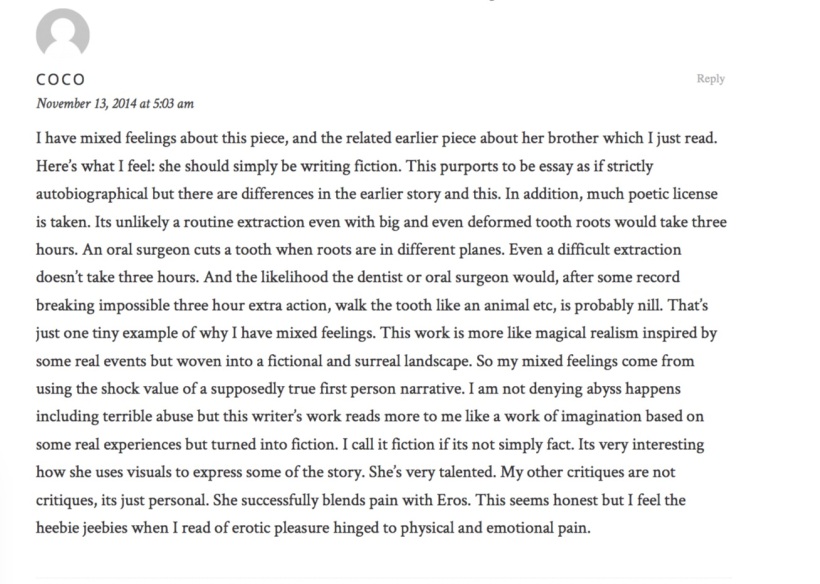
Even years before #MeToo, Coco knows it’s not a good look to attack the facts of my abuse story. Instead, she homes in on my dental extraction. It could not have taken that long. The dentist could not have been so weird. It’s easy to discredit disabled people this way because the machinery is already in place: doctors also don’t believe us. They gaslight us, abuse us, and disregard our experiences in favor of whatever some outdated medical textbook written by a white, cis man says.
Just for laughs, I recently asked my mother — who drove me to the extraction and waited in the lobby — if she remembered the weird elephant tooth:
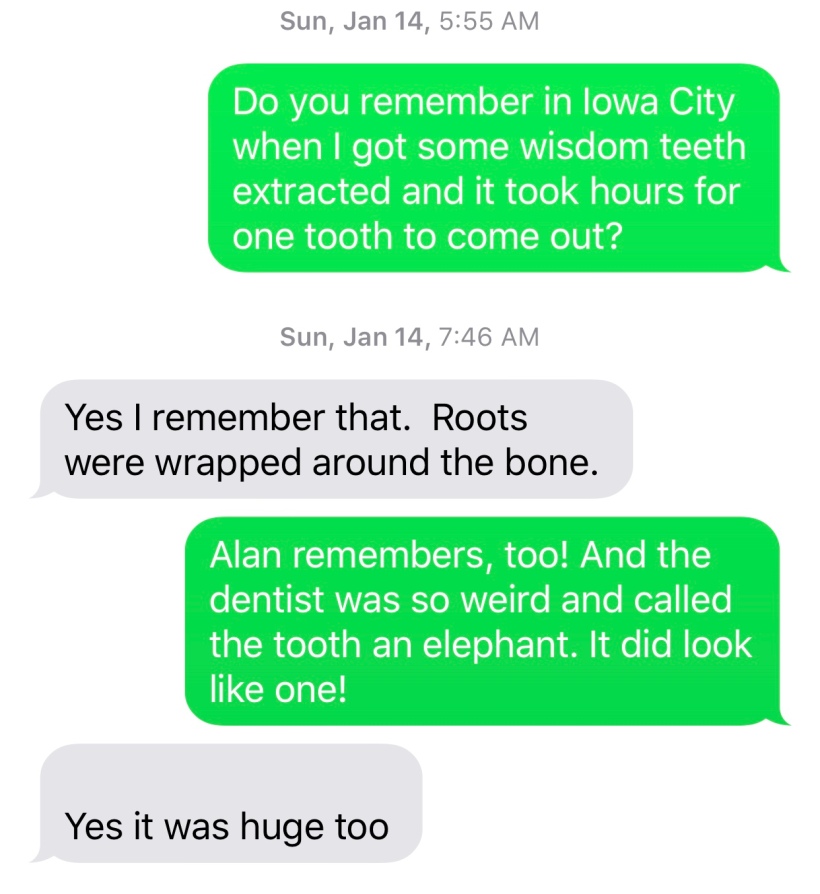
Yes, that extraction really happened, and it took so long for two reasons: I went to a discount college town dentist, not an oral surgeon, and my genetic connective tissue disorder (not yet diagnosed at the time) makes dental work excruciatingly complicated.
I could show you records of other extractions, too — all many hours long. But I won’t. Because I don’t owe you anything.
But Coco also goes after my physical pain, too, calling it “honest” but wrong.
Here is the thing: I don’t remember a day without pain. I have Chiari-Syringomyelia and Ehlers Danlos Syndrome, amongst other conditions. I live in pain every day of my life, and that pain — plus my epilepsy — formed the basis for why I was an easy target for childhood sexual abuse. Epilepsy, a developmental disability, carries a 90% risk. I also have learning disabilities, am part deaf, have central auditory processing disorder and am bipolar.
For me, there is no eros without pain. Sex hurts. Like anything else in my life: it hurts.
Coco wants to disembody my sexual experiences–remove the pain, remove the trauma. But the trauma is inextricably linked to the pain, and the pain to the trauma.
Combine those issues with complicated grief + mania (I was manic when some of the events in Strange Flowers went down) and you get that “surreal landscape” that put Coco at dis-ease.
___
Then the agents start contacting me. They like the surreal landscape and the magic. They like my voice. “I’ve never read anything like this,” an agent says.
Except, they don’t want me to be disabled — only to write like I’m disabled.
An agent wants to know if I “still have seizures” and he is worried about my mental illness.
“I don’t want to work with someone who might commit suicide,” he says.
He wants my neurodivergent, disabled narrative, except can it come without a disabled body attached?
He is just like Coco.
___
Enter Anna March.
I seek advice in a Facebook group for women-identified writers, and Anna March comments that this agent is just concerned, maybe a little paternalistic. Anna is a new Facebook friend. We met through her New York Times Modern Love piece a few months ago, about which I have mixed feelings because, in it, she erases her boyfriend’s disability:
Here’s the thing about Adam and me. Despite all appearances, with him being disabled, I actually consider myself to be the less “able” person in the relationship. People may assume that Adam is dependent on me, but I think it’s the other way around: He’s the stronger one, and I rely more on him.
Right down to the quotation marks around “able,” Anna simultaneously erases Adam’s disability and wants it to be the center of their love story: Look at me, she says. I love a man in a wheelchair!
But also: My boyfriend isn’t disabled at all!
Even the illustrations are erasure:
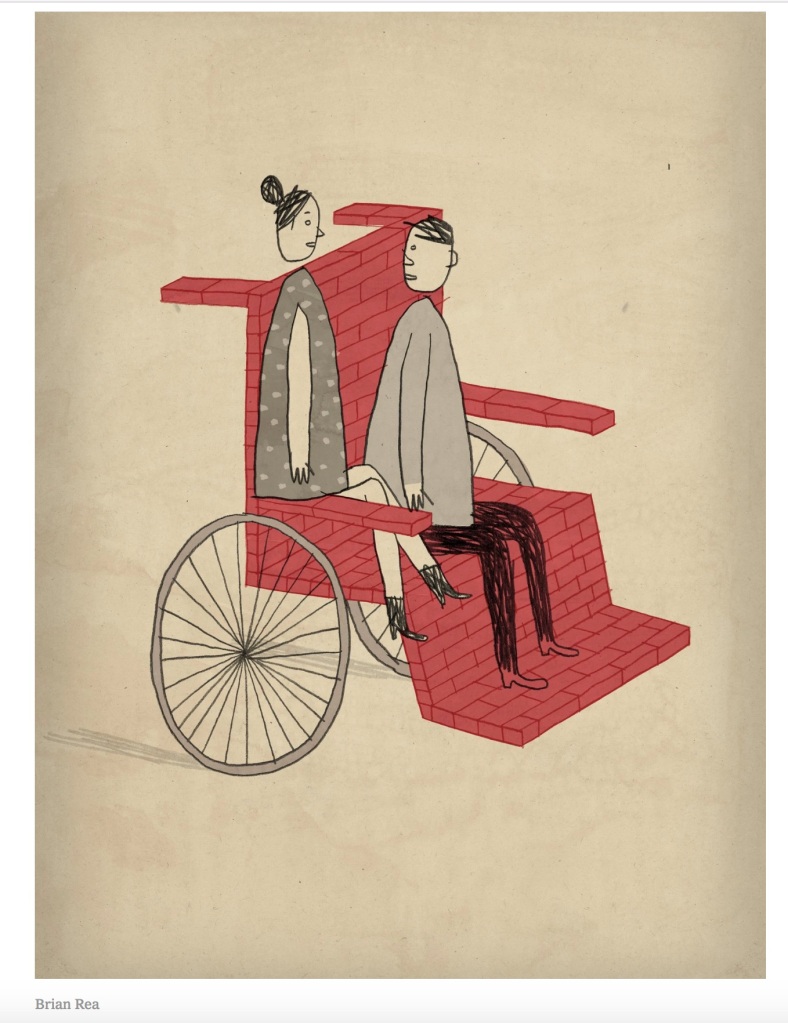
Anna literally occupies his wheelchair. Except it’s not an actual wheelchair. It’s made of bricks, a symbol of their new, 3-story cottage:
One evening after the contractors left, Adam, trying to help, picked up a heavy box of discarded bathroom tiles and other trash and headed for the pile outside. As he rolled toward our mudroom, the box slipped off his lap, sending dozens of filthy tiles crashing to the floor along with someone’s leftover Big Gulp cup, which splashed soda over freshly painted walls.
I didn’t know whether to scream, cry or run away. Instead, I said: “Leave me alone! I don’t need your help.”
Adam disappeared, and I cleaned up alone, crying.
“I can’t do this,” I whispered as I swept and scrubbed. Not this house or this man.
Abled readers probably do not pick up on it, but this is abusive. You can’t buy an inaccessible house and get mad when your disabled boyfriend experiences … access barriers. In fact, disabled people face a much higher risk of domestic violence in part because abled partners can wield access like a weapon.
“You would never do that,” I say to my husband. “When I drop things or make messes, you always offer to clean it up and tell me it’s no big deal.”
Anna takes it one step further: She steals Adam’s disability — his spinal cord injury — for herself, as metaphor:
That’s why people who think Adam would be lost without me have it backward. After his world fell apart at 16, he rebuilt it, year after year, and now he is a fortress. My world was also blasted apart when I was a child, but I’m just getting a handle on it now. In many ways, it’s as if I’m trying to escape from a crushed minivan of my own and having to remind myself, just as he once did, that I’m O.K., that I’m alive.
I have scoliosis, cervical instability, and a spinal cord injury (in my case, caused by a birth defect in collusion with a genetic connective tissue disorder), and every single day, I grind my teeth as people use my Jenga Tower spine as a metaphor for cowardice and even evil:
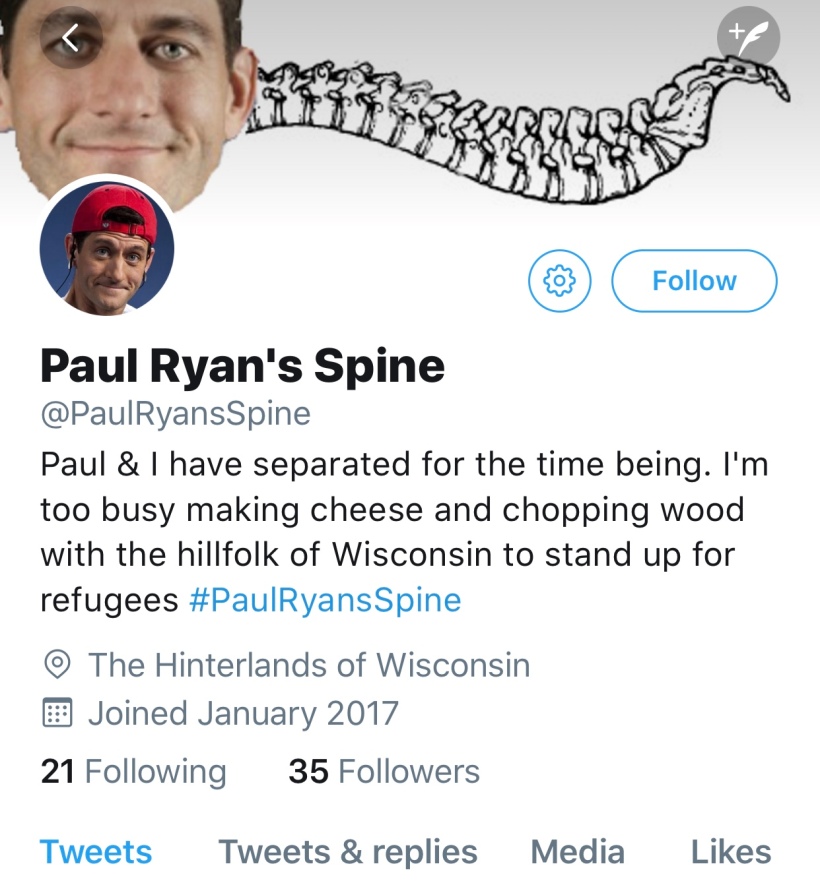
Even Alt_NIH:

I am a patient at NIH because of my spine. Imagine seeing that on a Twitter feed run by — who? Doctors there?

I have trouble standing upright. I am not a metaphor for Paul Ryan or Mitch McConnell.
And Adam’s body is not a metaphor for Anna’s trauma or her “messes,” as she alludes to her shady past.
And besides, some of us carry both physical disabilities and psychological trauma: using one as a metaphor for the other erases our complex experience. My abuse — my childhood “crushed mini-van” to use Anna’s metaphor — was because of my disabilities.
Anna ends the piece by essentializing Adam as “Prince Charming in a Wheelchair,” listed along with “a yard full of trash” as the elements of her life.
When it’s convenient, poof! He’s disabled again.
And she was praised for this. She got into the New York Times for this. While I am called a liar about my childhood trauma because of my disabilities.
See the problem yet?
___
Anna messages me privately to ask who the agent is, and I spill the beans. Anna seems to know her way around the lit world, and she seems to genuinely care about my writing. I’m confused and overwhelmed. I don’t know what else to do.
She writes back:

She couldn’t know who the agent is. The agent told me that he normally doesn’t rep writing like mine, but he fell in love with my voice – had never seen anything like it – and he couldn’t help but ask if I had representation.
If he didn’t normally rep my kind of writing (and he really didn’t; I checked out his clients), how would Anna know?
I ask a trusted former grad school mentor instead. He says, “Your disabilities are not the agent’s business.” Run.
This sounds like good advice, and I take it.
___
Looking back almost four years later, I see what I didn’t then: Anna wanted to look connected. Maybe she was even fishing, but mostly, I think she wanted to look omniscient. So connected she knew everybody and everything.
___
2016.
I am boycotting the AWP conference in Los Angeles after they rejected every single disability panel.
Imagine you are me: Your “social justice” MFA alma mater is sponsoring a conference that systematically shut out disabled writers, and all your colleagues are gaslighting you about it.
“I don’t know how to make them accept your panel,” a friend says. As if all my anger were just sour grapes?
I had hoofed all over Salt Lake City to get this writer’s books into stores, and she couldn’t speak up to get my foot in the door at AWP: I won’t ever forget it.
“I don’t know what to do with that much anger,” another says.
Now imagine this:
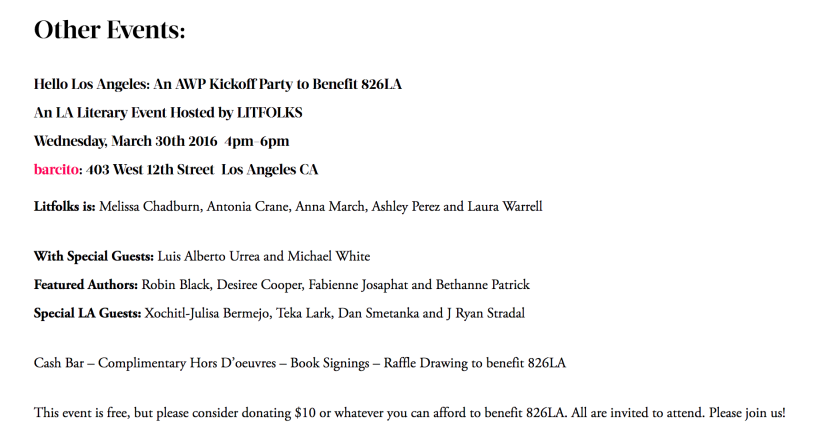
Your friends are all there, in Los Angeles, partying with a woman who exploited her boyfriend’s disability to get famous — LOOK AT ME, I LOVE A GUY IN A WHEELCHAIR — and not a single one of them has spoken up for disability inclusion.
___
The year before — when all the disability panels got rejected — I filed a Department of Justice complaint against AWP, and I got a right to sue letter in January 2016:
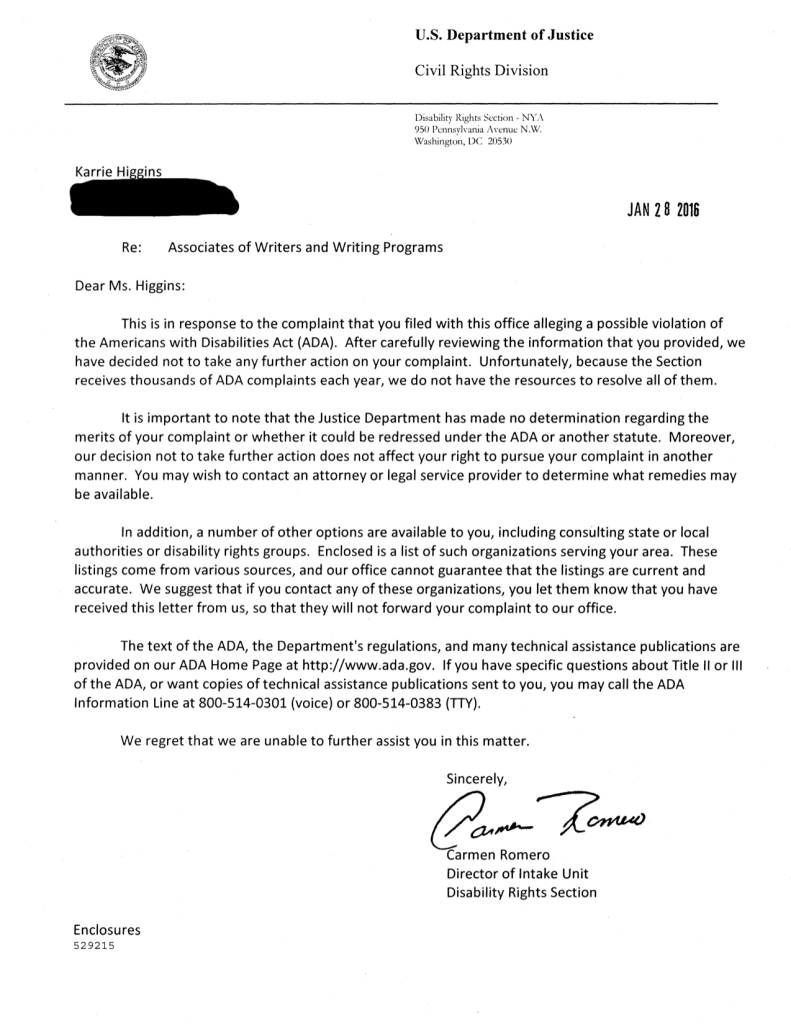
On Facebook, abled writers tell me I should have sued.
I say: With what money? Why can’t you protest and speak up? Why don’t you do the work, too?
They don’t. But they party with Anna March.
___
2017.
AWP is in D.C. I will be at NIH at the same time, lying in the MRI tube for hours right up the street from where all my friends are partying.
I get interviewed in ROAR and have a great experience with my interviewer, Ashley Perez.
Anna is good to me about the interview. I have no complaints.
But then Anna starts asking for writing. Message after message, even offering a column and payment.
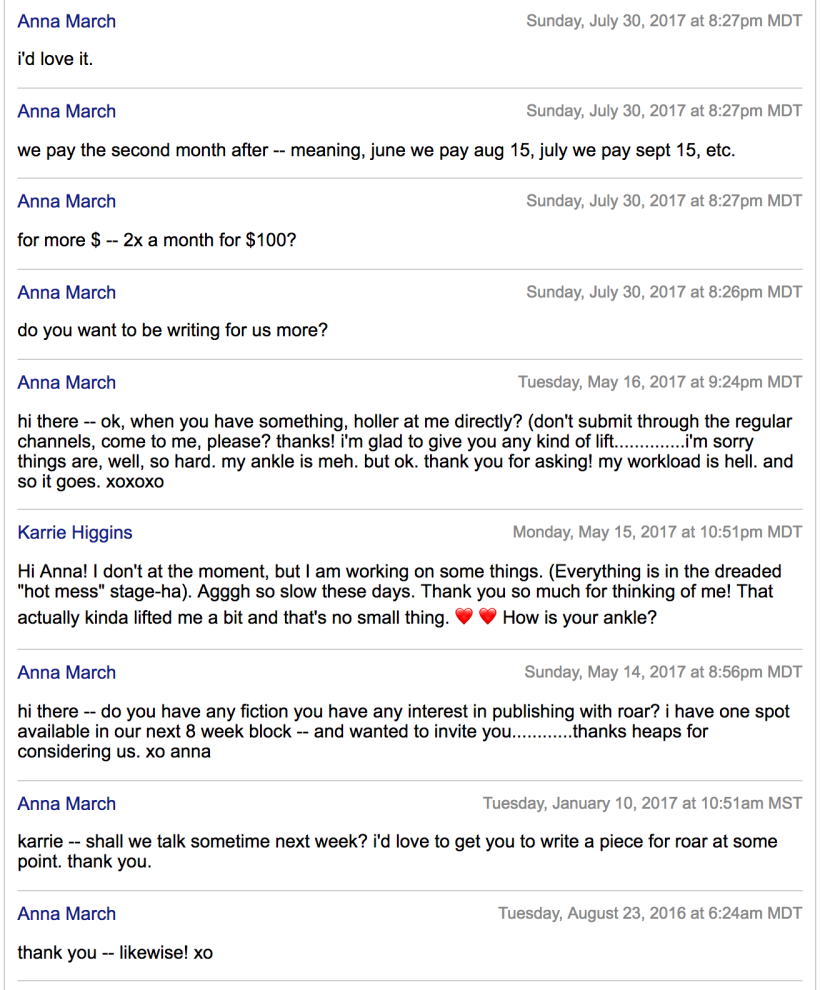
By the end of May, I know this is not a real offer. I’ve heard some things but kept quiet because more marginalized friends are afraid of what Anna might do.
Then, after an exchange about inaccessible retreats, she sends me this:
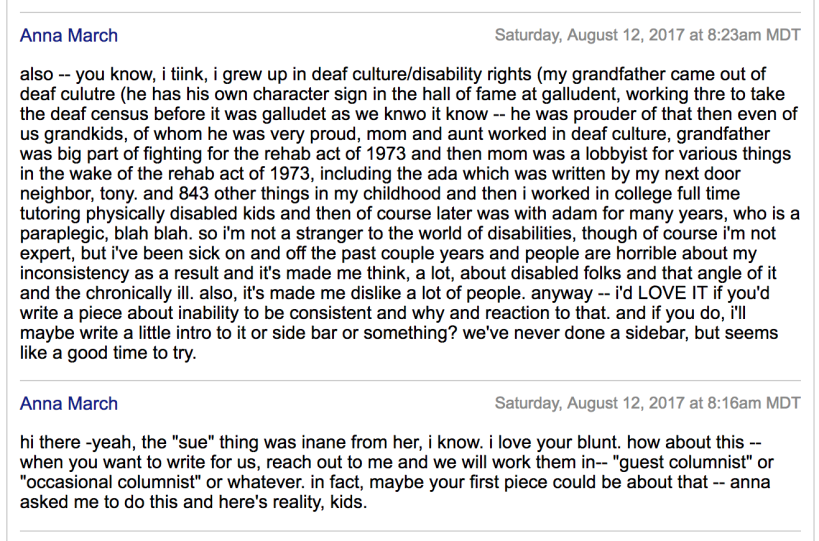
She is cloaking herself in disability as cover for her cons:
so i’m not a stranger to the world of disabilities, though of course i’m not expert, but i’ve been sick on and off the past couple years and people are horrible about my inconsistency as a result and it’s made me think, a lot, about disabled folks and that angle of it and the chronically ill. also, it’s made me dislike a lot of people.
The thing is, chronically ill people do feel awful about our inconsistency and lack of productivity. We hate backing out of events & letting down colleagues and friends. I want to be sympathetic, except I know too much about her now, and I sense a pre-emptive excuse.
I sense she wants to use me, get me on her side using disability. Look how she lays down her Gallaudet street cred (is it even true?) and even mentions Adam again — by then, long since broken up. Maybe she thinks a white disabled woman coming to her defense will drown out allegations from women of color. I can’t know what she’s thinking, but something feels wrong.
The worst part? In the wake of the LA Times expose, writers are tweeting “red flags” for scammers, including — you guessed it — someone talking too much about their chronic illness. Because Anna did it.
Chronically ill people already face stigma when we talk about our illnesses. Now we will look like cons. Because Anna stole that space from us–just like she stole that space in Modern Love for a physically disabled writer to tell a love story.
___
2018.
I have two panels at AWP in Tampa, but I can’t fly because of blood clots. AWP says Skype will net “bad reviews.” My panel lead wants me to stay quiet for fear of retribution. (Oh, how many of us stay quiet for fear of retribution.) I back out.
When I finally leak AWP’s email to DisDeafUprising on Twitter, abled writers don’t care. Again.
One able-bodied writer calls it “shenanigans,” as if violating my civil rights were just like dropping a water balloon or shooting a spitwad.
But then AWP Executive Director David Fenza gets canned, and I feel hope.
I take to Twitter, eager to see writers who have gaslighted me for years finally getting it. They don’t.
Nobody cares.
Anna March says, “I want people to think and understand about what they’re saying about ability and disability when they say that someone who’s able-bodied is somehow doing something noble by dating someone with a disability.”
But that is exactly what she banked her entire career on.
By July, the LA Times unmasks Anna March.
By August, Anna March has a panel for the 2019 AWP.
The topic? Endings in End Times: How to craft final notes that imply light and dark, open and closed, emotional and intellectual complexity? We discuss struggles and strategies for endings that feel satisfying for readers, and yet true to the work, the moment, ourselves.
Meanwhile, there is a panel that lists disability along with murder and natural disasters as “traumas.” My backbone is not your forest fire, I keep repeating to myself. My backbone is not your forest fire.
I want to be true to this moment. How does the story end? Will you finally include disabled writers, or are you always going to party with the people who use us?
two years later: I am trying to get as honest as I can
CW: CSA, bodies, medical details, autopsy
Two years ago today, I received two life-changing emails within minutes of each other:
- The Poweshiek County Sheriff had finally — after three years of legal battles — surrendered a CD of my brother Greg’s taped police phone call to my attorney.
- The National Institutes of Health accepted me into the syringomyelia study.
The Democratic National Convention was on television. Trump was months from taking the presidency.
These things are connected.
If you’ve read my work, you know I got one phrase from my brother’s taped phone call permanently inked into my left forearm.
I am trying to get as honest as I can.
I got it in Deseret Alphabet: the alphabet of the Mormons, of Utah, of testimony. When I got that tattoo, all I had was the police transcript of that phone call–no audio. Deseret Alphabet was my way of making my brother speak his confession.
Speak it from my skin, through my skin: living vellum.

Deseret Alphabet is phonetic. Translating my brother’s words into it felt like cosmic CPR, giving him the breath of life again.
Translate: verb
1. express the sense of (words or text) in another language.
2. move from one place or condition to another.
Deseret Alphabet is not a foreign language; it is English represented by unfamiliar symbols. I was interested in definition #2: move from one condition to another. I wanted to make the transcript of his incriminating telephone call speak. I wanted to turn it into testimony.
Even though I am not Mormon, I also needed the language to be of this place, Utah, because I truly believe I had to come here, I needed to come here, that it was some kind of destiny. This is the place that set me free.
I almost became Mormon, like one of my brothers, but instead, I forged my own path, my own relationship to the faith.
I am trying to get as honest as I can felt like something I could work with, something I could use to save my brother’s soul.
___
Before I got that tattoo, I wrote I am trying to be as honest as I can on a scroll in bone black ink so thick it felt like ancient vertebrae sticking up from a burial site: a skeleton for my brother who lost his in the cremation retort.
Bone black ink I made from my tooth: Eve donating a bone to her brother.
I went to the Salt Flats — salt crystals like fossils — and re-enacted Ezekiel in the Valley of the Dry Bones.
So I prophesied as I was commanded: and as I prophesied, there was a noise, and behold a shaking, and the bones came together, bone to his bone.
And when I beheld, lo, the sinews and the flesh came up upon them, and the skin covered them above: but there was no breath in them.
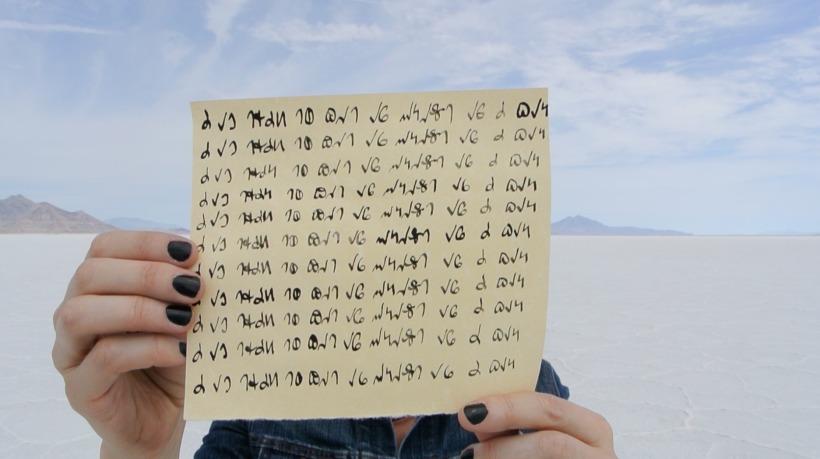
There, I ate the scroll, ate his words. Let the word become flesh. Let my brother be resurrected.
But it wasn’t enough.
___
February 2015, forensic anthropology facility:
I am standing in a clearing surrounded by bodies under chicken wire cages, like the aftermath of a mass suicide. It’s a body farm, where forensic anthropologists examine decomposing bodies in hopes of gleaning knowledge to solve murders and identify victims. I came to study forensic art, specifically sculpting on skulls to reconstruct soft tissues that have long since decayed. I have no hope of working as a police artist; I want to understand resurrection as a physical process, something a human being can do, even when God refuses. I want to be my own Ezekiel–put the flesh back on the bones.
I step backward, almost stumble over one of the cages, and steady myself, leaning so close to the chicken wire I can poke a finger through and swab the buccal edge of a molar. The dead man looks just like my brother.
“This one still has hair,” a student says, peering over my shoulder. Everyone gathers around us. For a forensic artist, it’s an exciting find, the kind of detail that could identify a John or Jane Doe.
The dead man’s neck twists away from me, his jaw gaping, as if screaming from the torment of worms. The cage is the only thing between us. It has always been the only thing between us. My brother could never show me who he really was because of the specter of a cage; I could never see who he really was for the same reason. I never wanted him in prison.
I touch my left hand to my right shoulder, where my Salt Lake Temple doorknob tattoo just finished healing. In a couple of days, I get a rose on the opposite shoulder, just like my brother’s. I’m not getting it in memory of him, but to steal the memory of him getting it. I’ve been stealing his memories: talking to his childhood and high school friends, searching for photos, watching vintage Pontiac GTO ads, mastering the Parachute Landing Fall.
Memories have epigenetic mechanisms, meaning: Every time I steal one of my brother’s memories, I make myself more related to him, genetically.
“We speculate,” wrote Jeremy Jay and David Sweatt in Nature Neuroscience, “that the new understanding of the role of neuro-epigenetic molecular mechanisms in memory formation can answer the long-standing question in neuroscience of why neurons can’t divide.” Neurons, “can’t have their cake and eat it, too.” They can either use methylation to preserve a singular memory, or they can use it to preserve cell-wide identity–a lung cell is not a kidney cell because methylation blots out different genes–but they cannot use it for both.
I am co-opting the machinery of memory for the purpose of reproduction. I am giving birth to my brother from my brain, like Athena popping out of Zeus’ skull. I am letting neurons have their cake and eat it, too.
If I donate my body here, I think, my face up close to the chicken wire cage, with all my brother’s epigenetic memories intact, with my rose tattoo intact, I could take my brother’s place in the cage. I could serve his time, save his soul. Maybe even fool God.
___
And here is how word becomes flesh: I made myself a body like my brother’s. The holes in my spinal cord, my syringomyelia, were never discovered until I got those tattoos. My brother had a spine like this: rods of titanium to hold it together after his vertebrae got crushed.

When I saw the holes on my MRI, same vertebrae:

I did not think: this could destroy me. I thought: this could save him. I was forging my body into his. The resurrection spell was working.
___
Three years ago, I wrote the Linn County Medical Examiner to ask if my brother’s tissue & blood samples had been preserved. I wanted his genome and epigenome sequenced. I knew I couldn’t afford it; I figured I would find a way somehow, someday. I asked if there were photographs. It was before I got the crime scene photos and saw the body for myself. I needed to see his body.
I asked about the remote midline scar referenced in the autopsy report — a scar I now know came from hernia repair surgery.
Most of all, I wanted to know if the Medical Examiner knew this:
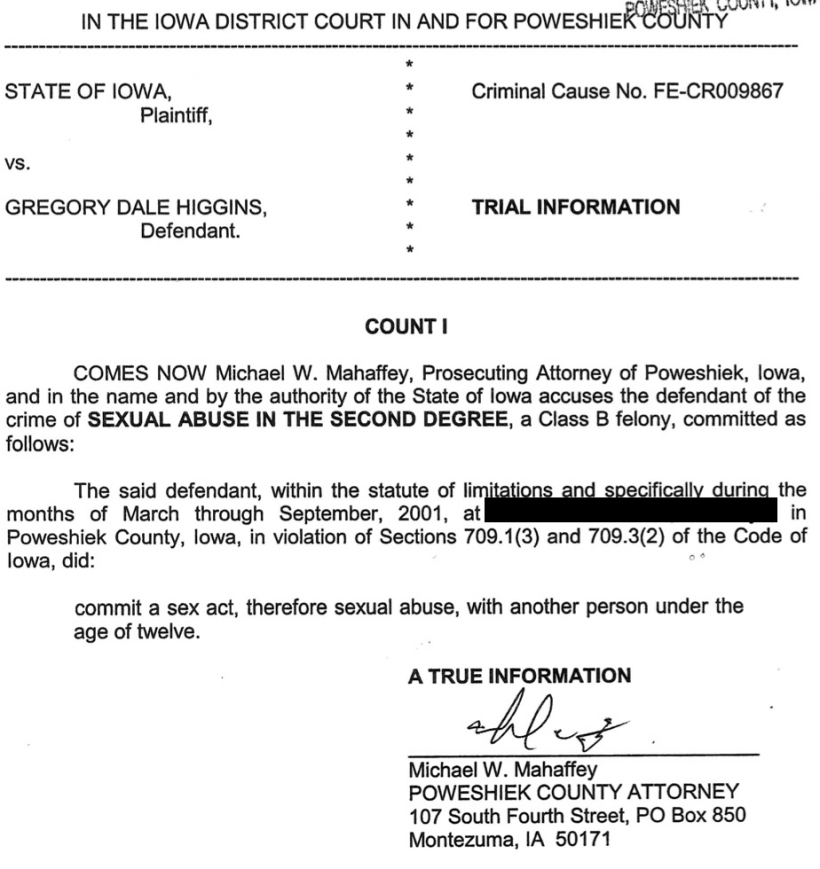
and this, in a message from his ex-wife:
“I can tell you .. that on two different occasions I had found Greg in the same condition, in the same position. Once in our family room. And the other time in our hot tub building outdoors. That time I had to call an ambulance because he was unresponsive. It was in the wintertime, and when they finally got him on the gurney & outside where the air was cold, he started choking, sat straight up & said, “What’s going on?” He refused to let them take him to the hospital & had to sign a statement to that effect. I told him the next day I was going to call his doctor about the medications.
And (this is the first time he had ever “threatened” me) he shook his fist in my face and said “Don’t you dare. If you do, she’ll stop giving me the pain medications.”
“I know what I’m doing.”
and if it would or could change this:
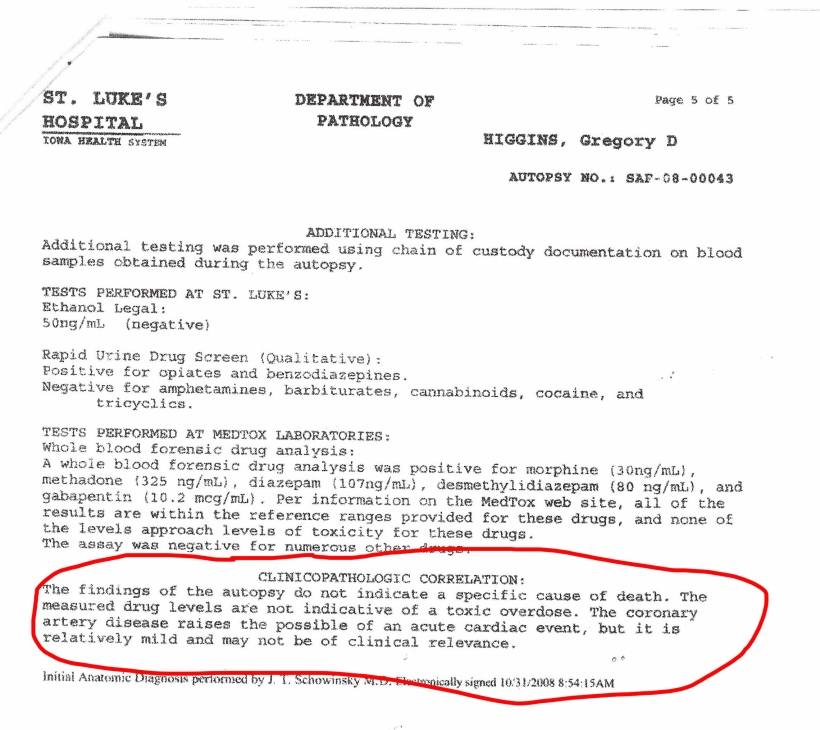
Would you have ruled it suicide?
I hated that inkblot test of an autopsy finding, how you could see whatever you wanted to see, how it enabled the family lies. A heart attack, I was told, when I got the call in 2008, a couple days after his body was found. I never believed it.
The Medical Examiner wrote back:
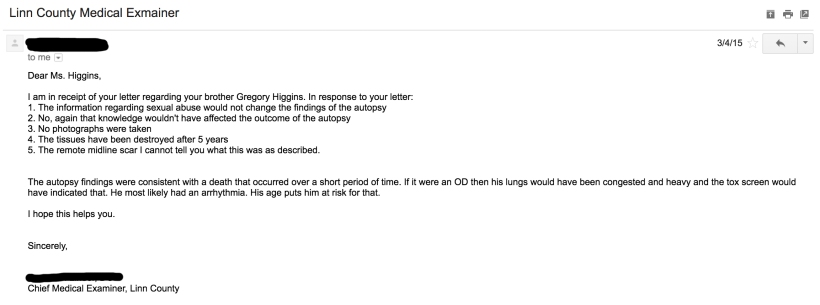
Arrhythmia: an abnormal electrical current surging through the switch-relay of the heart, making it thump thump thump off beat. I read the autopsy report again, my finger tracing down the center of the medical history like a scalpel, hunting for arrhythmia, but I never found it. You can’t diagnose arrhythmia on a dead heart. The Medical Examiner was asking me to take a leap of faith, to believe it was sheer, dumb luck that my brother died three days before standing in court as a jury heard him say on tape to his final victim:
“I want you to get your head squared on straight, but at the same time, I’ll be darned if I’m gonna be humiliated by some court of law.”
The Medical Examiner was asking me to believe that God granted my brother a writ of extraordinary relief. He was asking me to believe in a postmortem diagnosis without a body.
But wasn’t that the same thing I was asking of him?
It took three readings of the Medical Examiner’s email to see it, how he spoke of my brother in the present tense—his age puts him at risk for that—as if my brother were perched on an examination table, still alive, his heart still thump thump thumping.
There is another kind of autopsy, one that does not require a body, only tissue extracted from it: a molecular autopsy, capable of diagnosing genetic susceptibility to arrhythmias in cases of sudden deaths, particularly in the young.
Molecular autopsy saves the survivors: Family can seek testing and pre-emptive treatment.

I think I think I think my brother died so that I may live.
But it was too late: All tissues have been destroyed after 5 years.
My tissues are still here, I thought. I can take my brother’s place on the autopsy table.
I tried to get a genetic test, but I couldn’t afford it. University of Utah owned the patent on the genes.
Utah.
The land of Deseret Alphabet kept the secrets of my heart, my brother’s heart.
But the VA didn’t. When my brother signed up for the Army, he signed his body over to Uncle Sam.
And Uncle Sam signed his medical records over to me:
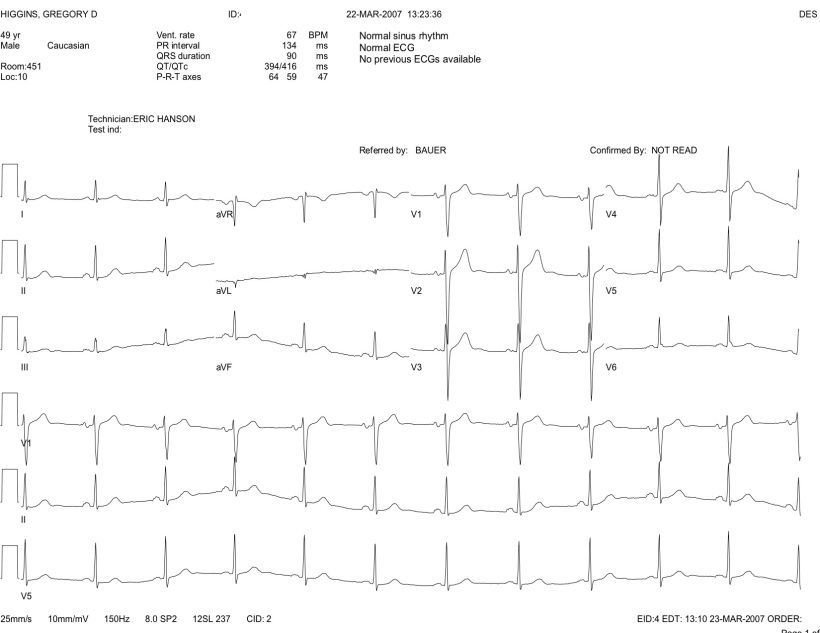
No arrhythmia.
I signed my body over to Uncle Sam, too: National Institutes of Health, a study of my syringomyelia. My term: five years. My marching orders: fly to Bethesda to report for duty on the anniversary of my brother’s autopsy: I was going to get down down down in the same position my brother’s body was found – the fetal position, the police called it – and let them open up the secrets of my neural tube with a needle, like an embryo in a petri dish.
A spinal tap.
I started to think of it as a living autopsy: me taking my brother’s place on the autopsy table.

On the day I was scheduled to fly over Cedar Rapids, the waters of the Cedar River were cresting, predicted to be as as high as the 500-year-flood in 2008. Waters rising, just like they were around my brother as his trial date neared.

In 2008, the same week the river crested and houseboats, untethered, slammed into the railroad bridge, the state filed pecuniary damages in my brother’s case: psychiatric bills for his victim.
My brother saw the river rising around him, and he went down down down
into fetal position floating in those fetid waters like a fetus in the amniotic sea.
After the heart monitor goes _____________________________________________________________________________, and doctors declare you dead, hundreds of genes flicker on like lightbulbs after an electrical blackout, delivering messenger RNA commands for cells to be fruitful, make proteins. Some genes reach peak activity days after a corpse is already cold.
Genes for inflammation, genes for stress, genes for immunity. The body thinks death is an infection it can beat.
Cancer genes go on a rampage–perhaps the reason transplanted livers so often succumb to tumors. What was believed to be recipient rejection might be an organ that still thinks it is dead.
Genes for embryonic development are reborn: the same code that wrote our bodies in the womb, long blotted out by the black ink of CH3–methylation–is revealed again, like original text on a palimpsest.
The DNA double helix unravels, opens our genes, unmasks our original blueprint. We are born again.
A possible reason for these increased abundances is that the postmortem physiological conditions resemble those of earlier developmental stages.
–Tracing the dynamics of gene transcripts after organismal death, Open Biology
the house Greg died in, Google map street view:
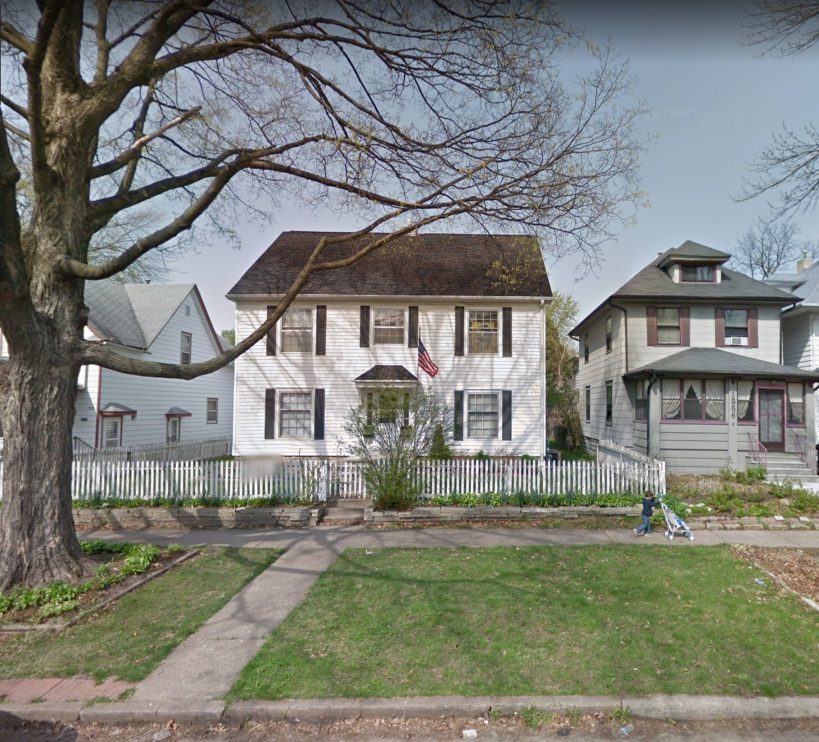
The first time I saw it, I thought they caught his death on camera. The child pushing his own carriage, at the edge of the lawn, front wheels just past the picket fence. They caught my brother’s ghost on camera.
But Google took that photo in 2012, not 2008. That child is alive, somewhere, ten years old maybe. That child is alive.
Death made my brother an innocent again.
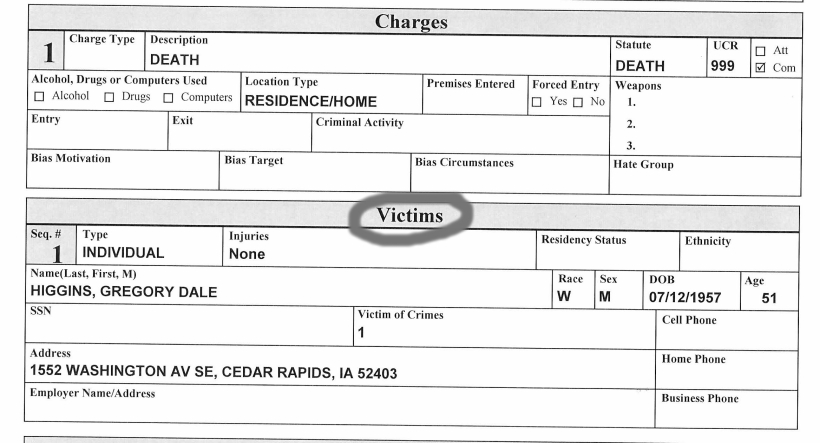
And death will uncoil my DNA, too, release all those forged memories, written in the black ink of methylation. God always wins.
___
NIH never did that lumbar puncture, and they delayed my first visit to November: the anniversary of my brother’s graduation from Jump School. Honors, top of his class, Iron Mike award. “The best of the best,” his Airborne buddy called him.
The morning after Trump won, I was lying in an MRI machine at the NIH Clinical Center in Bethesda, hypnotized by the clang clang clang, like the drumbeats when I marched in the streets my last time in DC. Two weeks after 9-11, anti-war protest, surrounded by riot police in Edward R. Murrow park.
I was fast back then, not like now with my walking cane. My group saw the opportunity, an unlocked door in a building on the perimeter, and we leapt through it like paratroopers out the airplane hatch. Cops chased us through the corridors, but we escaped to the Metro, to freedom.
My brother was alive then. He would have hated me protesting war. Airborne motto: Death From Above. And yet, he stopped abusing that other girl in September 2001.
[Did he stop abusing her because of 9-11? The shock of the war front coming home?]
___
MRI nightmare: President Trump shoving me in the MRI tube like a dead girl in a morgue drawer.
Greg’s best friend and Airborne buddy when I shared I was voting Hillary:

___
When the CD arrived from the attorney and I played it for the first time, I waited for my tattoo line. I wanted to hear my brother be redeemed.
But what he said and how he said it are two different things.
“Honey, I did NOT … come, oh that’s crazy. Oh, my God, oh my God, I’m just sick. I can’t believe this shit. Oh my God. This is just, this is just bizarre. I just can’t believe this. I did not touch you sexually. I, if, if, you took that way, way wrong, my God. My dear, you, I’m trying to get as honest as I can with you, I mean, that’s way wrong. It’s just, tickling you or wrastling you or grabbing you. If that, if that’s what you thought I was doing, then that was just, that’s not right, I mean, I, that was not my intention whatsoever, my God.”
It’s a throwaway line, a nothing line. He rushes over it like it doesn’t matter at all. A lie.
Under that cage on the body farm, I will not be confessing; I will be manipulating, just like him.
And yet, I am translating those words to a new condition: speaking his lie every time a forensic anthropologist examines my decaying body for clues.
Maybe something from my body will solve a crime: my brother and I will get our day in court after all. That’s a kind of honesty.
I am trying to get as honest as I can with you, God.
___
Two weeks ago, I flew home from NIH again. July 12th: my brother’s birthday. It was not lost on me: I spent my brother’s birthday in an airplane, of all things.
Front page, Cedar Rapids Gazette, his last birthday alive on Earth:
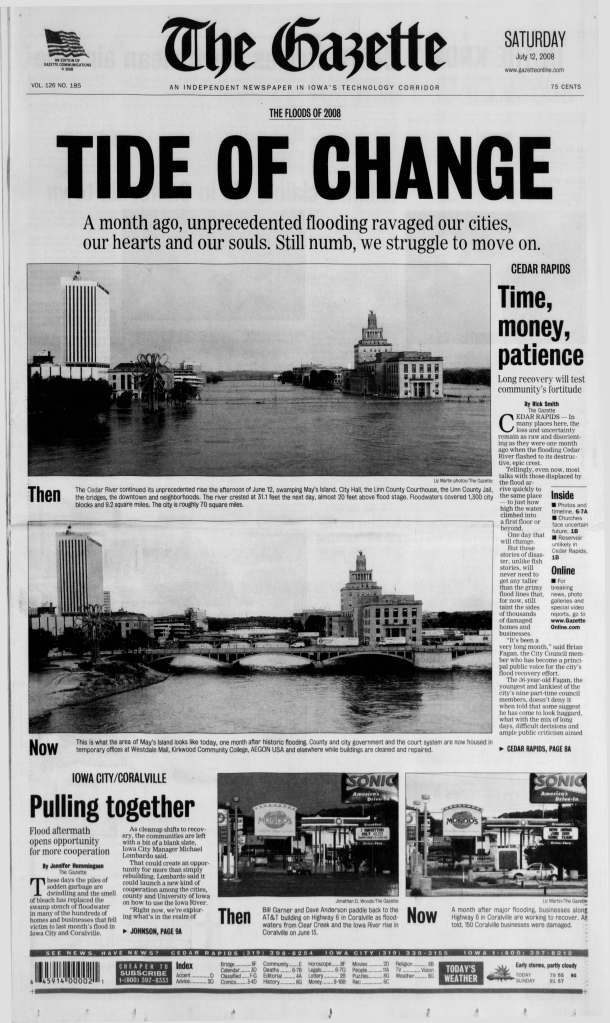
Back then, when the floodwaters retreated, city dump Mt. Trashmore, capped since 2006, was unsealed to entomb 430,000 tons of debris, including one soggy manila file from the basement of the Linn County Courthouse dated January 30, 1979, bearing my brother’s name and disposition: GUILTY. Misdemeanor Conviction, $100 fine.

His first sex crime. His genesis story.
Six years too late, I called the Linn County Clerk’s office to get the record. ”We lost a lot of records in the flood,” they said.
“And a lot of them we didn’t even try to recover.”
Floods –unlike tattoos — really do redeem.
Skeleton Key
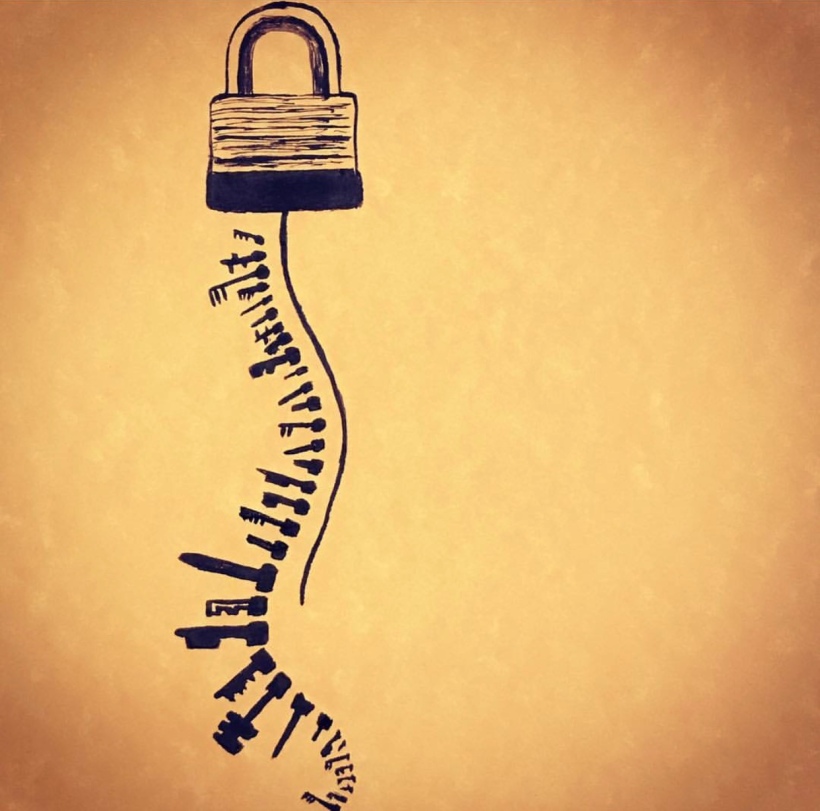
CW: abuse, CSA
My father is dying.
Every week, a new emergency: a stroke, pneumonia, sepsis, C. Diff. His lungs, filled with fluid, crackle through the stethoscope bell. His muscles are wasting. He falls a lot, shreds his skin clean down to bone. When my mother escapes the apartment to run errands, he speed-dials my sister, sometimes crying, sometimes ranting about our half-brother Scott, accusing him of getting a little too close to our mom.
My sister forwards me voicemails. We are building a case for Power of Attorney.
“Scott blew it, as far as I’m concerned,” Dad says in one, his speech slurred like all the times he drunk-dialed me after I went no contact in the mid 90s.
“He can go to hell from now on. I want nothing to do with him, ever … I’ll talk to an attorney. Well, I already–I already talked to one. Got the phone number, and he said, things can be done to expose these people … It’s important I talk to you. I sure wish to talk to you, sweetie. Please. Please call dad. Please, honey.”
click
“Please call. Please. This is your father. I need to talk to you. You and your mother mean the world to me. I love you. Please.”
I froze the first time I played one.
He sounds like my half-brother Greg on the taped police phone call, the one that got him arrested for sexual abuse:
Transcript: man, crying, “I don’t want your mom to hate me. This is my life. This is all I have.”
Five years after Greg’s body was found crouched face-to-carpet in front of his flickering television, I ran a postmortem criminal background check and discovered he died facing trial for Sexual Abuse in the 2nd Degree of a child under twelve: same crime he perpetrated against my sister & me.
I texted my mother.
How old was the victim? She replied.
I texted my sister.
How old was the victim? She replied.
What they meant was: Do we have corroboration?
We were conspiring in time-travel case law: If Greg touched a little girl in 2001, he did it in 1986, too. Future bad acts.
I scanned every page of the court case and emailed a copy to my mother.
“I got called a liar, too,” she said.
She meant by my father, after my sister had come forward in 1989 and my mother kicked Greg out of our lives. Dad always chose Greg.
Greg, his Airborne Paratrooper golden child. Greg, his first and favorite son from his first family, with his first wife.
I wanted to mail my father Greg’s case, certified with return receipt. I wanted that green postal service postcard with his signature on one side & my name and address on the other, like he was signing for me, signing you are mine.
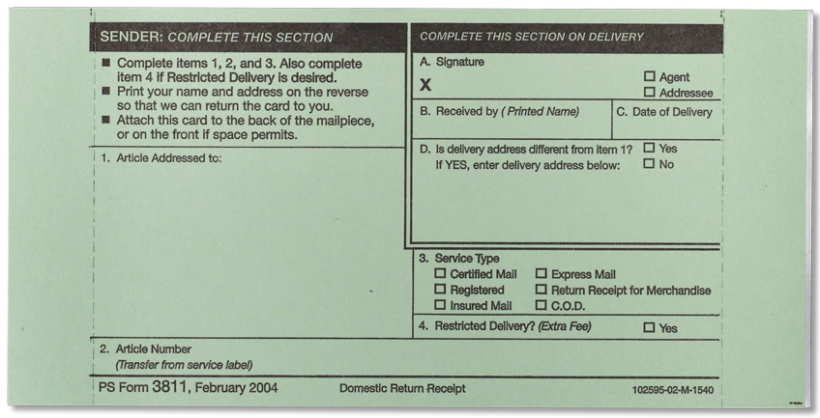
But I did not want to reconnect.
The last image I saw of my father for over twenty years: his half-toothless grin reflected in the rearview mirror of his car as he careened, drunk, down the driveway, laughing after I had screamed, Greg did it to me, too.
___
After my father got sepsis, when nobody thought he would make it through the night, my mother said, “Do you want to talk to him?”
I surprised myself and said yes.
I don’t know if he knew who I was. He asked about my nephew’s guitar and whether he would come play it. Maybe he thought I was my sister. Maybe he thought I was my nephew.
“I love you,” I said.
“I love you, too,” he said.
I was willing to let it all go: the black eyes and bruises he left on me, that time I had a skull fracture and who knows what the ER docs really thought:
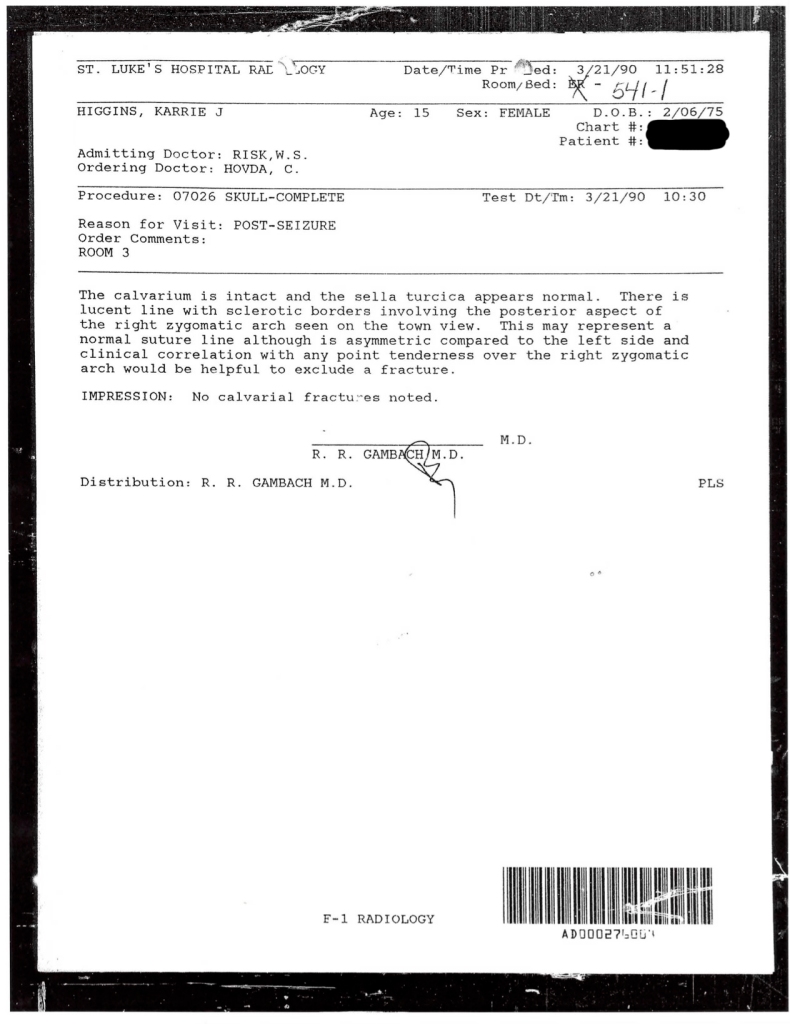
They declared a seizure did it, and maybe it did, but fists landed there, too, and it wasn’t always clear which injuries were abuse and which were my disabilities.
[Didn’t they count on not knowing for sure? Didn’t my father? Didn’t I?]
How he drove drunk with me in the backseat of the old Matador, swerving over the double yellow lines while my body got tossed around on the bubbled plastic seat liners. I used to pretend they were bubble wrap, that they would protect me if we crashed.
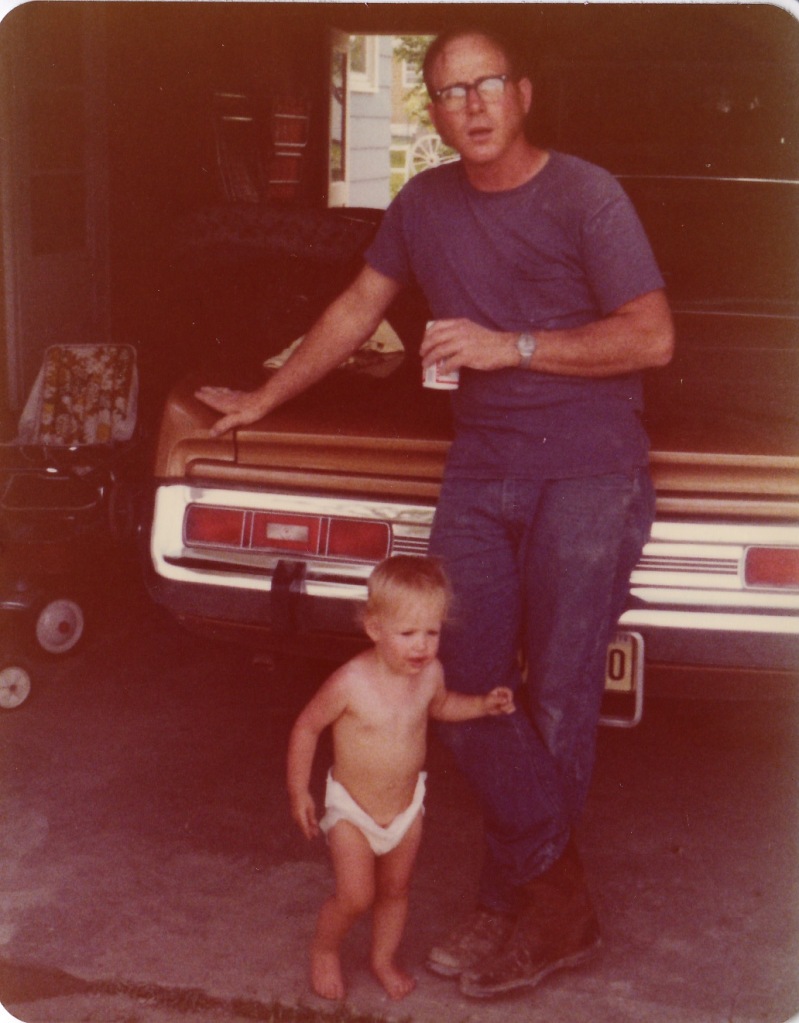
All the times he peeled up my long patchwork skirts to reveal my panties and said, “I bet the boys like that.”
Or said I was draining the family dry because of my medical bills, that I never should have been born.
I was willing to let it all go. He sounded so frail, so weak. He couldn’t hurt me anymore.
___
But he did make it through the night.
And the next night.
And the next.
And a hospital social worker said, “He needs round-the-clock nursing home care.”
“You have to do it,” Scott told my mother, and my sister and I agreed. Our mother is in her seventies with health problems of her own. She can’t help my father up when he falls. She can’t help him in the bath. She can’t lift him into the car.
Finally, she got the paperwork for a Medicaid application. To meet the income caps, she will sacrifice my father’s social security. She will sacrifice his pension. Without that income, she will lose the apartment. Her home. Again.
Years ago, she sold the house after my father left her for his high school sweetheart, the one he’d been seeing since the mid-90s and maybe longer. It went for $75,000, furniture included, and she packed up a truck and moved to a cramped apartment across town, divorce papers drawn and ready to sign.
But they never signed the divorce papers. Instead, he came back, and they signed a lease. Now, they’re bound by poverty: no money to live apart.
___
My father gets wind of the Medicaid application, threatens my mother. “If you put me in a nursing home, I will divorce you.”
My sister and I laugh via text. Can you fucking believe him?
___
Voicemail to my sister:
“You do something like this” — he means the nursing home — “This is not helping anything. I’ve never hurt my wife–your mom–physically, but mentally I guess I did for … I don’t know why now. But I thought I would have time to make it up. I didn’t want that stroke, either. And this other thing that I caught”–he means the C. Diff — “they’ll get rid of it. It will clear. I need to talk to you honey. All right, sweetheart, I hope you take this, call me back.”
___
August 2011, my first time visiting home since 2000. My sister and I pose in front of our favorite childhood roller rink:
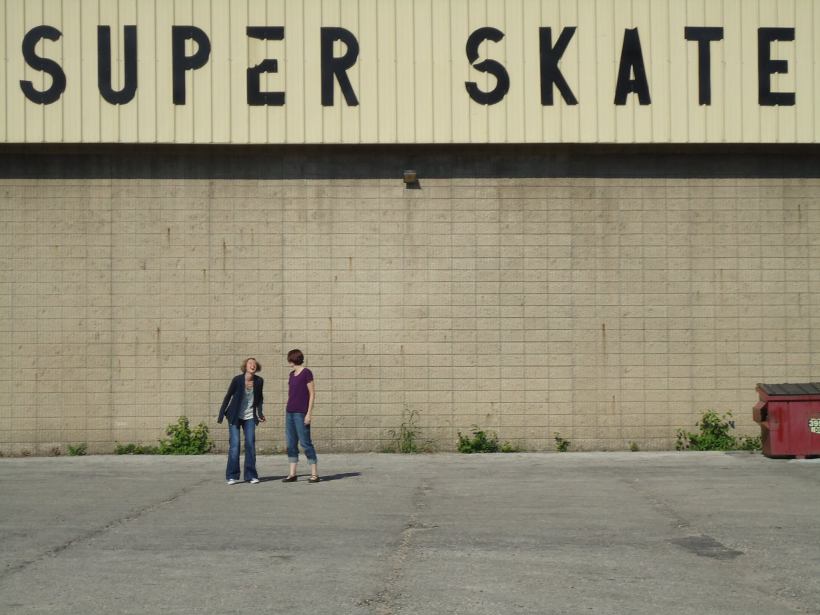
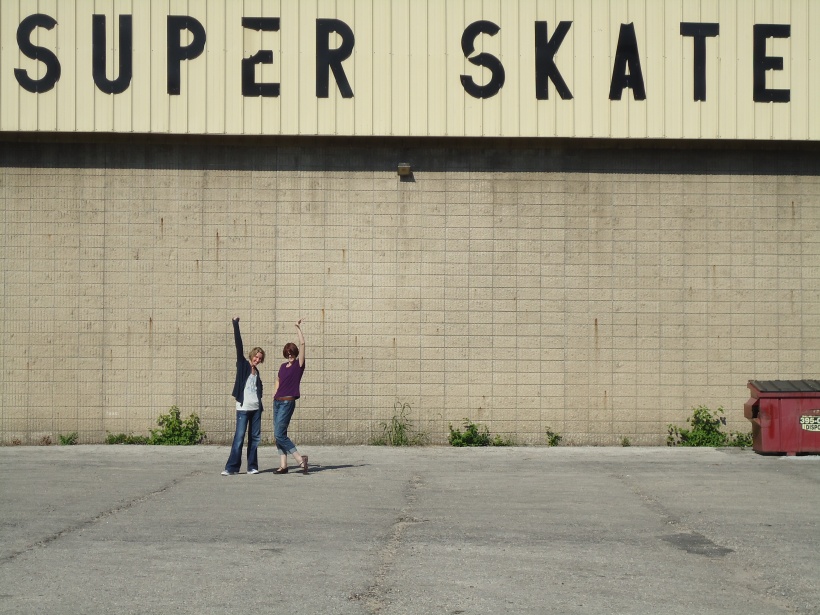
What you don’t see: my father’s van speeding past, me running to my mother (I could still run then) in a panic. “Was that dad? Where is he going?”
My mother, admitting she invited him to my goodbye breakfast before I hit the road back home to Utah.
“I want one last picture of us all together,” she says.
I make her call him, tell him no. We sit in the Super Skate parking lot, staring out the windshield, Mom’s knuckles white on the steering wheel, until his van passes the opposite direction.
I wonder whether she wants the picture or dad does.
Later, he yells at my mother. “What would Karrie’s Grandma think if she knew my own daughter refused to see me?”
My mother yells back. “What would she think about why we don’t have a house?”
___
The night of my father’s stroke, I look at the Super Skate photos. “I should have let him come to breakfast,” I tell my husband. “I should have let mom get her photo.”
I was willing to let it all go.
___
And then we found out about the secret money, inherited from his brother in 2005, not long after the house got sold:
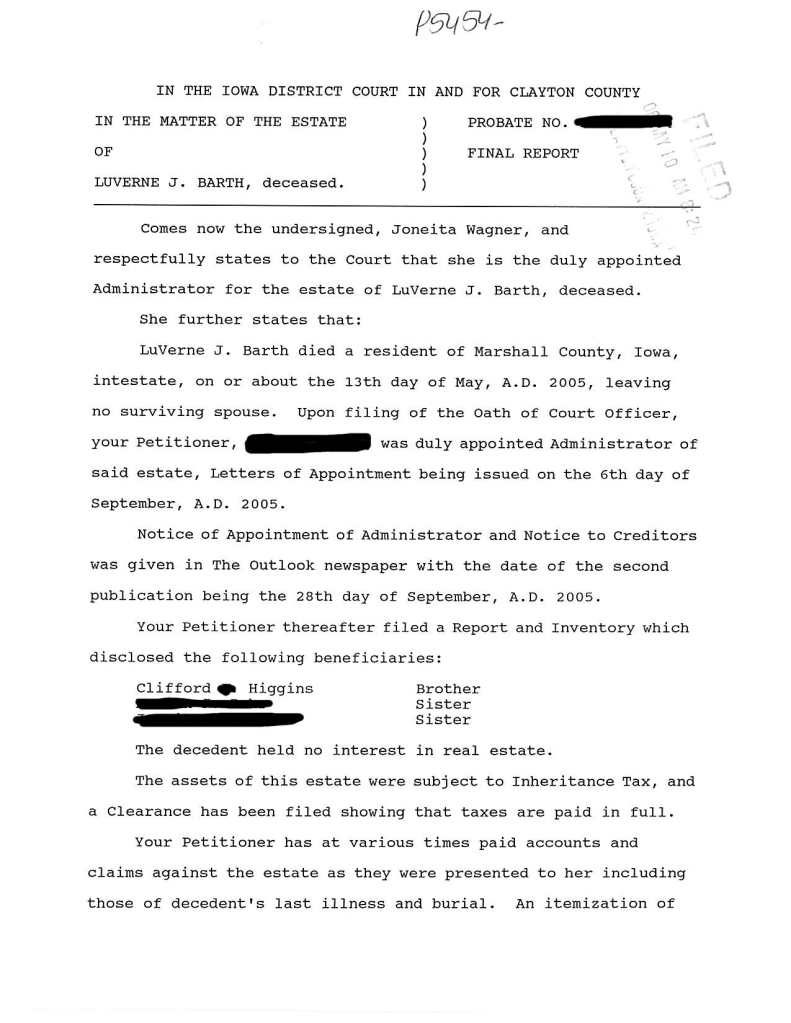
It wasn’t a normal inheritance. My uncle’s guardian — a half sister — invested his money while he was locked up in the Veteran’s Home, let it grow. She created their own birthright.
My aunt leaked the secret without knowing it was a secret. My mother called her about the nursing home and Medicaid application, and my aunt said, “What about the money from our brother?”
Every sibling got three disbursements, enough to buy a house in Cedar Rapids.
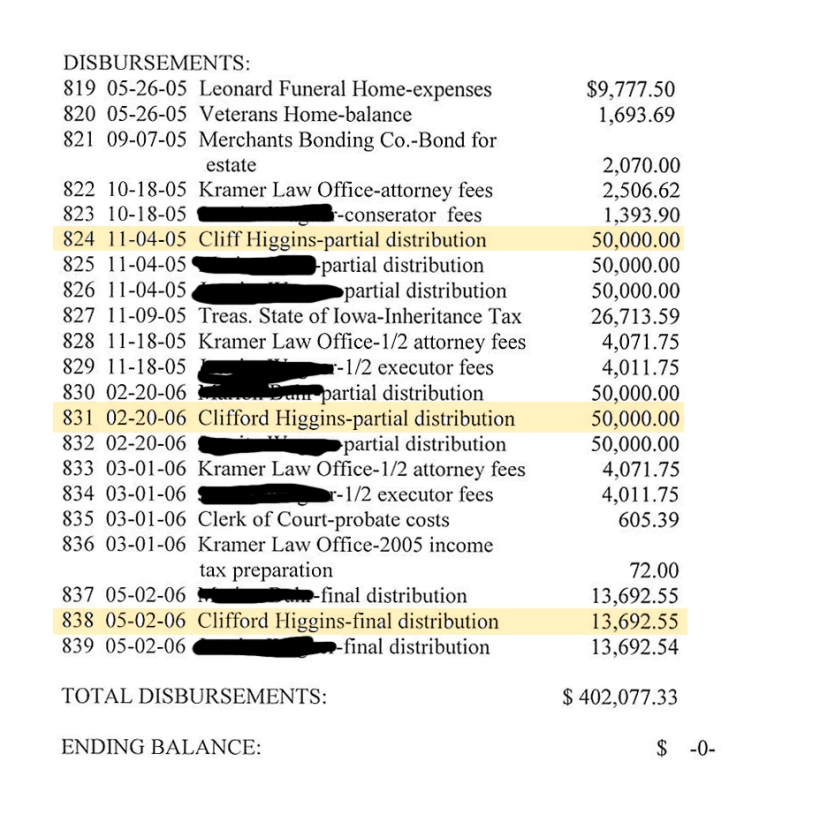
A house.
My mother lives on the edge: barely a few bucks after rent, Medicare supplemental insurance, prescription co-pays, her phone bill. “If we still had the house, we’d be comfortable,” she says. I know she regrets selling it. Back then, it seemed like her only option: get the hell out of that place of bad memories, get a little cash, try to pick up the pieces.
She needs a dental implant. She needs a new car. My father totaled her van three years ago and they never had the money to replace it.
The van. Oh god, the van. He bought her that van, used, when they got back together. He used to show it off all the time like an engagement ring.
“What do you bet he plunged some of that money into the van?” I text my sister.
“And then he wrecked it,” she texts back.
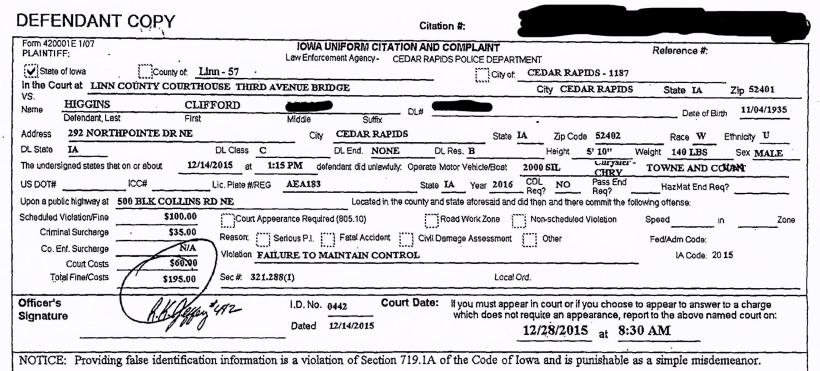
Of course he wrecked it.
___
Here we go again: I email my mother the probate case.
I tell her, “There’s the proof in black & white. He got that money.”
“I will never understand why he did it,” my mother says.
Because he never loved us, I want to say, but I don’t.
__
Ever since I left home, I have had trouble finding a home. I have lived all over: Iowa City, Portland, Salt Lake City, Boulder.
Of all the cities I have ever lived, I loved Salt Lake City the most because of the Mormons. I almost became a Mormon because I thought they know how to fix this.
The first time I visited Temple Square, I broke down in the visitor center in front of a row of miniature houses with television screens in the windows. Families can be together forever, the videos promised.
A pair of sister missionaries approached. I don’t think I understood yet that they were missionaries, even with the name tags. They directed me to the family history computers. I sat down, typed in Greg’s name, and it returned his social security number from the Social Security Death Index.
I could run a background check, I thought. I could learn things about him he never told me in life.
“Write it down,” one of the sister missionaries said, sliding a scrap paper toward me.
I didn’t know I was dialed into Granite Mountain Records Vault.
In 1960, the LDS Church blasted into a cliff in Little Cottonwood Canyon, drilling 700-foot long tunnels 675 feet below the surface and reinforcing them with concrete and steel. Ten-foot-tall steel cabinets line the corridors, relentless drawers like cells in a honeycomb, a card catalog of every human name the Mormons have harvested so far. Volunteers around the globe photograph birth certificates, baptism records, obituaries, marriage certificates — and more — on microfilm, delivering images to the hive, where archivists preserve them in perfect 55-degree temperatures and 35 percent humidity. Entrance tunnels lend the only hint of unnatural activity, like a secret alien laboratory or B-movie beehive.
Nobody except authorized personnel gets past the 14-ton Mosler doors — built to withstand nuclear apocalypse. Once a document goes in, it never comes out. The archive shuns tours and forbids researchers access to the originals. The security of the records trumps all else: The simple swishing of pant legs kicks up enough fugitive denim dust to obliterate a record.
Not even the Salt Lake City temple is so secure. When the Wasatch Fault ruptures, the earthquake will liquefy the clay and sand beneath the temple. It will fall. The LDS world headquarters will fall. The holy city of the saints will crumble, but the vault will live on, cocooned like a time capsule, impervious as an escape pod to the problems of man.
These are the records that allow Mormons to baptize the dead, save the souls of their ancestors, and seal families together for all eternity.
In 1836, the Prophet Elijah appeared to Joseph Smith in the Kirtland temple. He said that the hearts of the children must turn toward the fathers. He meant the ancestors. And so Mormons seal up the records, and seal families. Nobody ever goes astray.
Families can be together forever if the hearts of children turn toward the fathers.
___
In 2008, when Greg died, I got written out of the obituary. One day later, a corrected obit appeared:
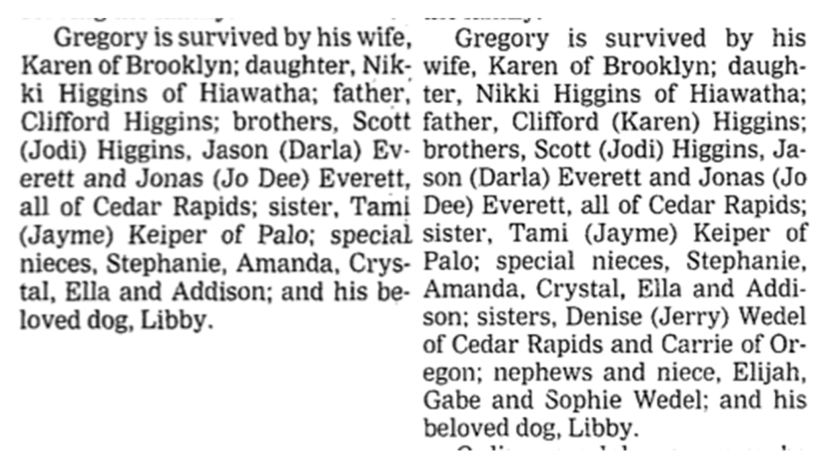
I got written back into the family line, but only kind of. Carrie with a C, not a K. How does your family not know how to spell your name?
I never knew which family member called in the correction until I found out Scott is a Mormon–converted via shotgun if he wanted to marry the love of his life. But even still: converted.
Scott, the peacemaker. Scott, the negotiator of treaties when our family was at war. Scott, the one who will never erase you from the family line.
How do you not know your own brother is Mormon?
Scott broke me into Granite Mountain. Scott wanted us to be together forever.
Is this family?
___
“If Dad spent that money on anyone, he spent it on Greg,” my sister says, but I don’t know.
June 1977, Army infirmary:

“Parents killed in car accident April 1977.” But our father is still alive, and Greg’s mother didn’t die until 2004.
Greg dreamed our father dead.
Like brother like sister.
February 8 1990, two days after 15 candles on my birthday cake and four months until I tried to commit suicide:
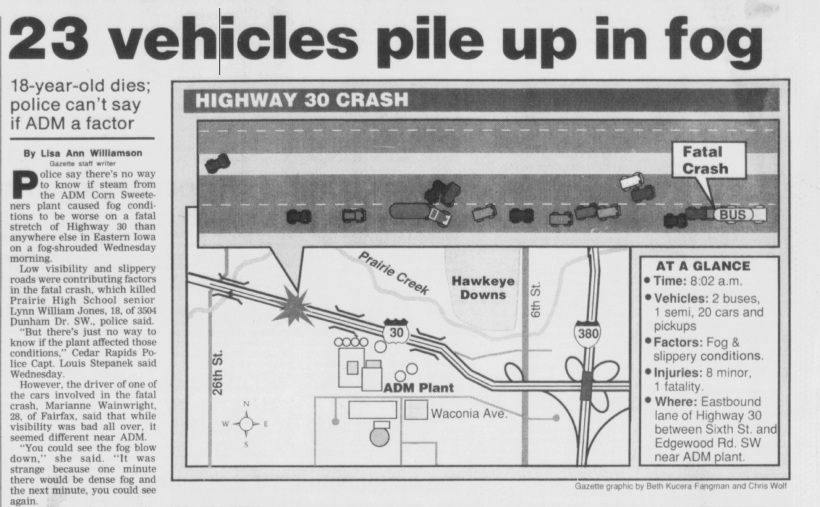

“It’s hard to tell if it’s the fog, but it was different there,” one of the drivers said. He meant on Highway 30 near ADM Corn Sweeteners, same road my father drove every day to work maintenance at the ethanol plant.
One minute: clear skies. The next: fog so thick a school bus driver slowed his bus to a creep. Behind it: 17-year-old Lynn Jones, “the best of the best,” the principal of Prairie High School called him, an Eagle Scout, a swing choir boy, a “quiet leader.” He slammed the brakes too late, slid right under the bus.
The ethanol plant is eating cars.
January 22, 1988:
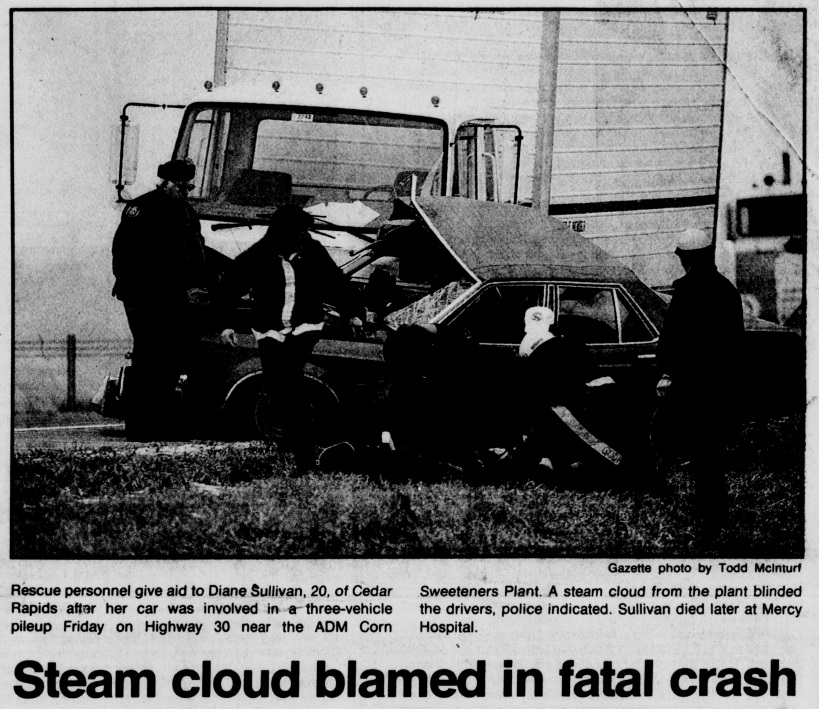
Cedar Rapids Gazette: Friday’s dense steam cloud provided drivers with a terrifying few seconds of driving. The highway simply disappeared.
Maury Burr of the Iowa Department of Transportation: “You drive into them and it’s lights out.”
February 2, 1988:

Sometimes, I imagined Dad’s pickup disappearing into the fog on Highway 30, too. Father killed in a car accident, 1990.
__
After I ran that postmortem background check, I found Greg’s widow on Facebook. I didn’t know if she believed Greg or his victim, but I took a gamble. I wrote, I am Greg’s youngest sister, and he did it to me, too. You are not alone.
We talked on the phone. She said, “Your dad used to come into our home and insult Greg’s mother.”
“I don’t know how to tell you this about your dad,” she said., “But —
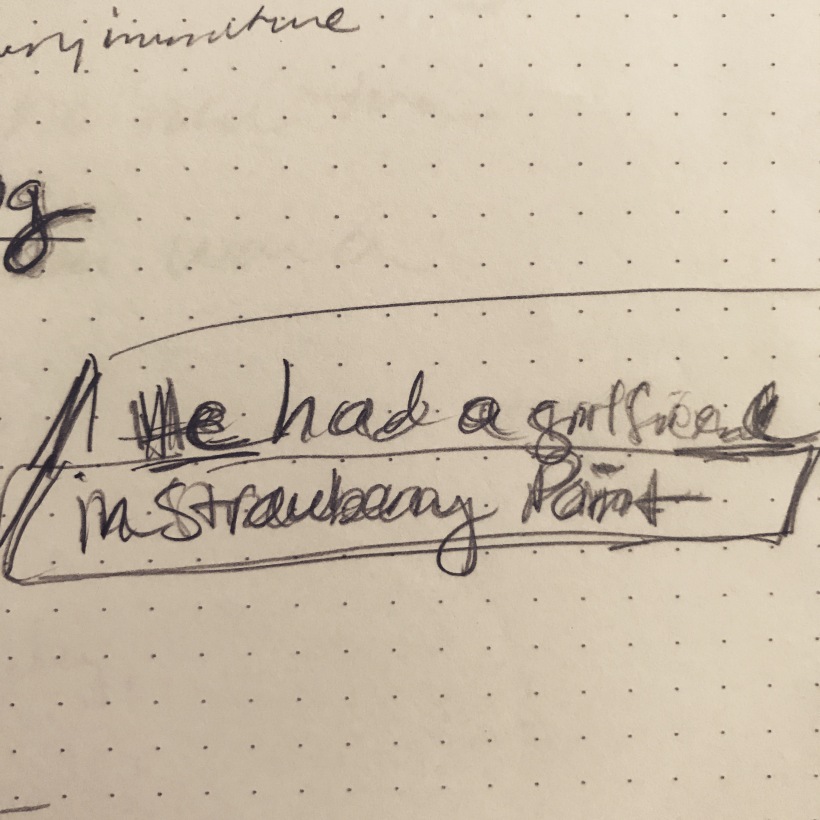
I wrote down the words, traced them over and over as she talked. He had a girlfriend in Strawberry Point.
___
We knew about the girlfriend. We always knew.
Eight years old: I answer the plastic Garfield phone, tell the strange woman asking for my father that he isn’t home and “May I ask who is calling?”
“This is his wife,” she says, in a menthol voice.
“But you’re not Mom. Mom is his wife.”
___
In my medical records: my father’s social security number. I could run a background check. Find out things he never told me.
___
Mom finds a nursing home bed for Dad. “We can’t put him in the nicer one because they want a $3,000 deposit,” she says.
I research the cheaper nursing home, the one for poor people:
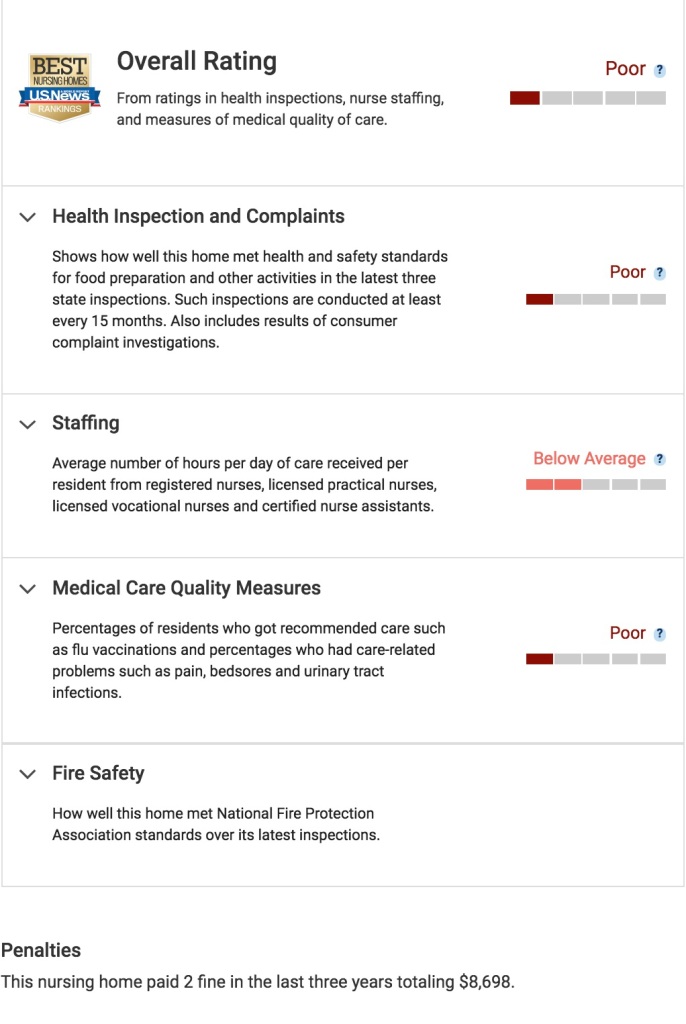
“We’ll have to be vigilant about abuse,” my sister says.
I picture my dad’s red catheter tubes curled on a shelf in the bathroom when I was a kid. He’s had to use them all these years because his bladder is too elastic, too stretched out, to squeeze out urine. I get so sad for him I hurt there, like a UTI. It’s where I always hurt when I think about him too much.
He did it to himself. He could have used his secret money.
It doesn’t make it any better. I am relieved when he does not go.
“We can’t put him in a nursing home against his will,” the doctors say.
They are going to leave that to his children. Pursue Power of Attorney, they advise us. It’s the only way.
___
Excerpt from a social worker report during one of my extended hospital stays, St. Luke’s Hospital, 1990:

When I was 13 or 14, I got a job detasseling corn. They recruited us at school, handing out the applications, and luring us in with the promise of good money we could spend however we wanted. We didn’t even have to get a ride. Buses would pick us up and transport us to the fields.
My father tried to stop me: No daughter of mine will get dirty in the corn fields.
I did it, anyway. Spent the money on my own school clothes and supplies. I thought if I bought them myself, he couldn’t yell at me anymore for costing him money.
That autumn, the falls started. The paresthesia. The seizures. Joint pain — there since childhood — intensified. I saw rheumatologists, orthopedists, neurologists. They tested me for arthritis, lupus, lumbar injuries, epilepsy, and Lyme.
Diagnosis: migraines and epilepsy, but it didn’t explain the pain or how my knees, shoulders, ankles, elbows and fingers slipped out of joint.
My father latched onto Lyme and refused to let go, even when blood tests came back negative:

The newspapers all that year:

“A tick must have got her when she out there detasseling,” my father said. He found a way to blame that job, to blame me.
But I never got bit by a tick.
“Your medical bills are draining us dry,” he said. “I wish you were never born.”
No daughter of mine will get dirty in the corn fields.
___
But it wasn’t just that job. It was any job.
Kool Moo ice cream stand, Cedar Rapids, 1992: My father skids into the parking lot, marches up to the counter reeking of Pabst Blue Ribbon, and demands I clock out and come with him. “I am not coming back for you later,” he says. I cannot drive because of my epilepsy, and he knows the buses do not come to our house in Hiawatha.
“Go ahead,” my boss says, his eyes fixed on my father’s, nodding like he might to a gunmen demanding cash out of the register.
Mr. Higgins has a lot of problems from his childhood because he is bitter for having to work at such a young age.
I see it now, how my father thought he was breaking some kind of cycle. He was never a child, so he would see to it I was always one.
I wish you were never born.
___
December 2017:
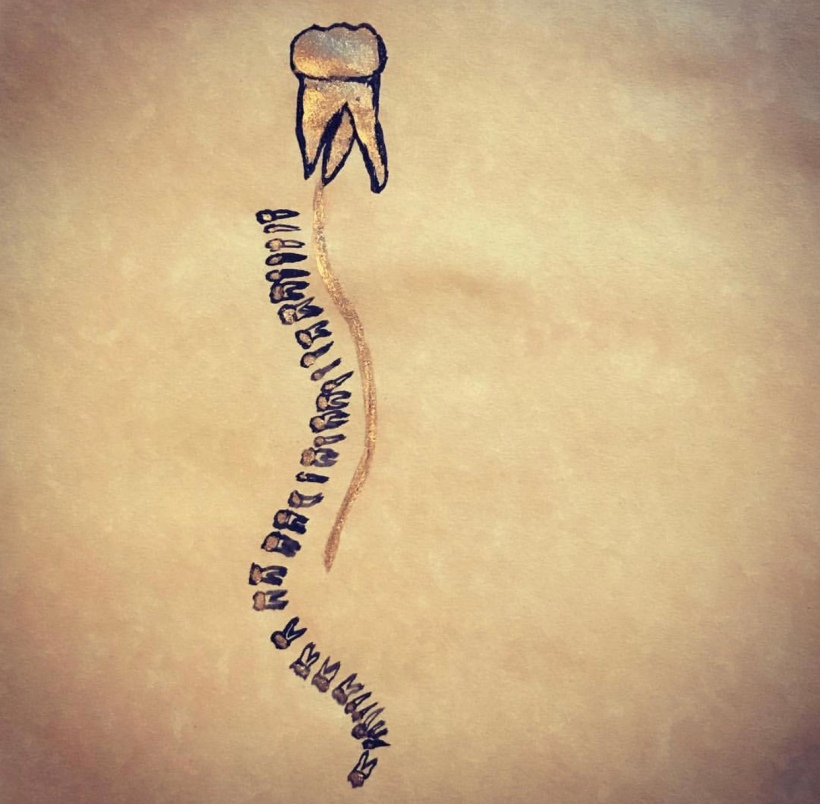
At my epileptologist’s office, we discuss the possibility I was never born.
Periventricular heterotopia: newborn baby neurons never migrated from their birthplace inside the ventricles to create the cerebral cortex during fetal development. Instead, they clung to the shore of their primordial sea inside the neural tube, anchored for life in the swirling waters of cerebrospinal fluid.
I might be a fetus and adult at the same time.
Four years ago, I got diagnosed with a neural tube birth defect called Chiari Malformation, which means: my skull is too small for my brain. My cerebellum crowns through the foramen magnum like a baby through the cervix. My brain is trying to be born.
On MRI films, my neural tube is a scroll without a seal: my spinal cord slit right down the center, like with a letter opener. All the secrets of my fetal development unfurled. Inside that tube: cavities called syrinxes. Syringomyelia.
And from that loose scroll: crest cells that migrated to my brain and face to create connective tissue, grow teeth.
My teeth. Deformed, with extra roots that curl and twist in my gum tissue like sea anemone. I have a high, narrow palate crowding my molars so close their roots appear tangled on x-rays, like trees planted too close.
The brain gives birth to the body.
By now, my sister has been diagnosed with Ehlers Danlos Syndrome, a genetic connective tissue disorder that explains our joints sliding out of place, paresthesia, chronic pain, migraines, high dental arches and tooth decay, my Chiari-Syringomyelia, maybe even my epilepsy. That’s why we are talking about periventricular heterotopia.
“Your neurons migrate on lattices of connective tissue,” my neurologist tells me. “If you have a connective tissue disorder, maybe those lattices aren’t quite right.” Heterotopia means: out of place. Neurons out of place, in the wrong home, cause seizures.
All the things my father blamed on Lyme, on my detasseling job, on me, turn out to be genetic.
And they were passed down through him.
I know because of Greg. The Airborne paratrooper golden child. Paternal half-brother. I got his records from the VA, filled out the request as next of kin, sent the corrected obit to prove it:
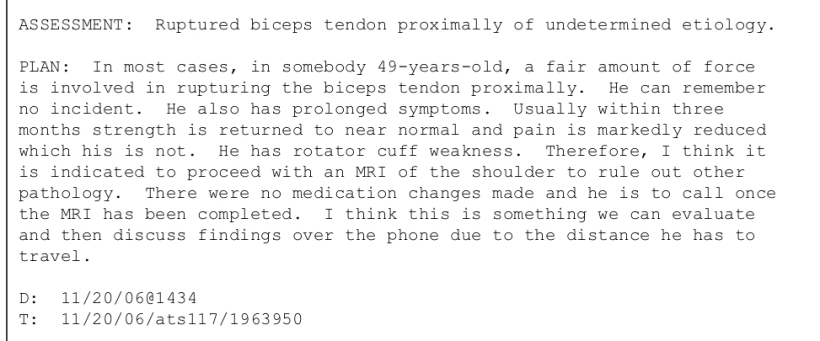
His records are full of tendon ruptures, hernias, migraines, pain, insomnia, joints out of place.
My father’s red catheter tubes, his stretched bladder; spontaneous pneumothorax in the 1980s, transported via ambulance from the ethanol plant to re-inflate his lung at the hospital; aortic root dilation; pain pain pain: all symptoms of EDS.
Not Lyme. Not my job getting dirty in the cornfields.
“See if you can get your brother Scott to go with you to the geneticist,” my neurologist says when I list off the family history. “Have them look at his joints, too. He may be the key.”
Scott, the peacemaker. Scott, who broke me into Granite Mountain. Scott, the Mormon. Scott, whose corrected obit unlocked Greg’s records. Scott, whose shoulders slide out of place, too.
Scott is my skeleton key.
___
On the phone, I tell Scott about Dad’s accusation: Scott is getting a little too close to Mom.
False accusations of incest from a father who never believed a real one. Greg did it to me, too. My father laughing, his half-toothless grin in the rearview mirror.
Scott tells me how he changes the oil in Mom’s van, helps with repairs around the house, helps when she can’t lift up my father from the floor.
How my father gets angry when he asks to speak to my mother on the phone.
“I never thought he was jealous,” he says. “I think of your mother as my mother now.”
This is what my father fears most: The hearts of children turn toward mothers.
I think, I will write you into the obit, too, when she dies. I will make sure you are listed as a surviving son. I will create your birthright like you created mine.
In Granite Mountain, a second obit will strengthen our connective tissue, bind us together forever.
____
At the cardiologist office, we discuss the possibility I was never born.
My echocardiogram gives me away: a patent foramen ovale, the hole in the heart of every human fetus, a secret passageway through the septum for blood to bypass the lungs. Fetal lungs are dormant. Unborn babies, floating in an amniotic sea, do not breathe. Their tiny hearts keep their blood a secret. Shhhhh, the lungs are not alive like we are yet.
When a baby breathes its first breath, the portal closes forever: no going back. Within a few months, it seals tight as a tomb. Except maybe mine never did. Maybe my lungs never trusted the air. Maybe my heart never trusted my lungs. My portal is still there, waiting, luring my blood back through time.
Inside the right atria: the Chiari Network, meshy strands leftover from embryonic development, named for Hans Chiari, the physician who discovered them during autopsies, same man who discovered my neural tube birth defect. Chiari is inside me everywhere. A through-line from heart to brain: Chiari, Chiari, Chiari.
Maybe EDS, too: it causes heart defects.
Or the hole could be an atrial septal defect–not a purposeful passageway, an accidental one, when the atrial tissue failed to finish forming.
Either way, my heart thinks I am still incubating. I do not yet exist.
Later, they find an aortic aneurysm, too: Something for old people, I think. How can I be old and never born at the same time?
EDS causes that, too: my conception will be my undoing.
“Does anyone in your family have heart defects?”
“My father,” I say.
The hearts of children turn toward the fathers, literally.
___
What about the hearts of fathers?
My father’s high school sweetheart left him money when she died last year.
Last year. They were still together, still in love. She had my father’s heart until the bitter end.
“Her children called him,” my sister says. “Asked him not to take it. They needed it for her burial.”
We have to find the kids, check the story. Medicaid demands a full accounting.
I search the obits for her first name; it’s all we have.
Judy + [town where she died]
One hit. Right year, right name, right location.
It could be my family:
Judy married a man named Clifford–same name as my father. She named her first daughter Denise.
Denise.
I freeze. Denise is my sister’s name.
I text my sister. She replies, “I am going to be sick. Mom always told me that Dad insisted on my name.”
“Let’s hope it’s the wrong Judy,” I text back, but we already know it is not.
___
I search the court database for her probate, find her divorce instead: 1997. The year Mom found out the first time. Dad promised to end it, but he never did.
But Judy did — with the other Clifford. The mirror Clifford.
___
We are not a real family. We are his pretend family.
I am glad I said no to that family photo. I am glad it doesn’t exist, because we don’t exist.
___
I start searching property records. Maybe Dad bought Judy a house. Maybe that other Denise — bizarro world Denise — is sitting in it right now. Maybe she is the real child, with the real inheritance. Maybe she just found out about secret money, too.
__
I dispatch my sister to our parents’ apartment. “Rifle through dad’s papers,” I say. “Look for a bank statement or maybe a safe deposit box key.”
The only thing she finds is shoe boxes filled with fishing trip photos and this:

I wonder if Greg wanted that photo. I wonder if Scott did. I wonder if they exist to him.
___
January 2018: I return home for my appointment in the Connective Tissue Clinic at one of my childhood hospitals, the same clinic where my sister got diagnosed with EDS. It is my turn to be written into this genealogy with my father and brothers and sister. For my connective tissue to become part of the connective tissue that binds us.
It’s seven years since my last and only visit. Nobody in my family has seen me with a walking cane, rollator, ataxia, hearing aids. I am recovering from DVT and a mini-stroke, still on blood thinners after I begged my doctor not to take me off them, weaker than I used to be. I am the same Karrie who left 18 years ago; I am not the same Karrie who left 18 years ago.
“That’s my Granite Mountain,” I tell my husband as I look out our hotel window at the hospital.
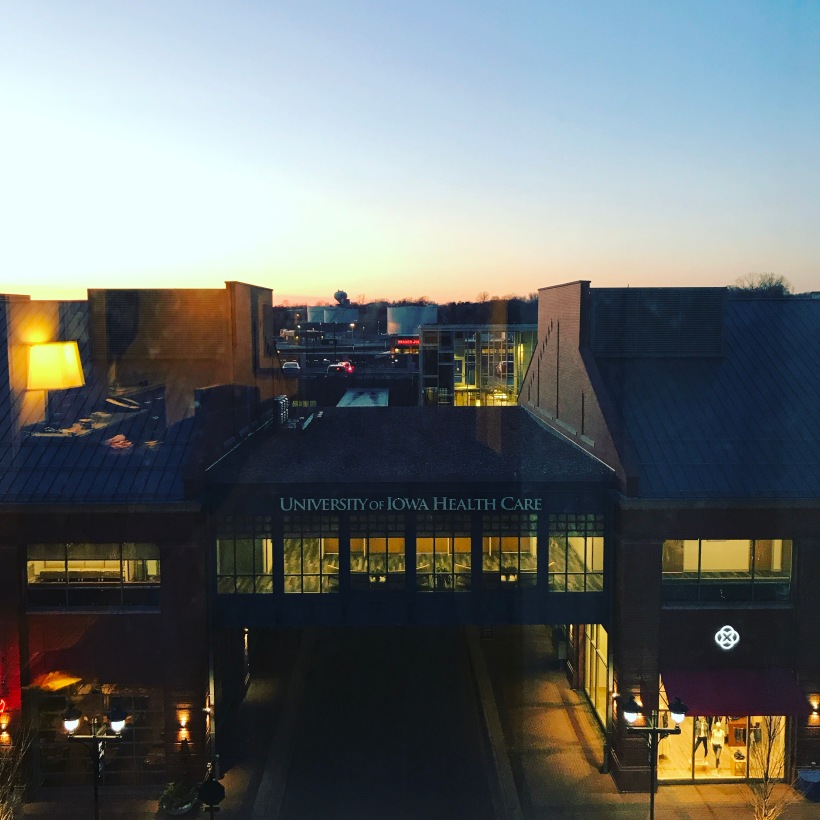
In my suitcase: hundreds of pages of medical records from my mother, my father, Greg, and me.
I may never know if my dad bought a house for his high school sweetheart, but I can draw the tracings of his heart on an EKG in 2005. I know the size of his aortic root dilation and how his hernia repairs failed. I know the precise date he refused to stop blood thinners against medical advice because he — like me — was afraid of another stroke. Is this family? Is this real?
The next day at the geneticist’s office, the doctor bends my elbows backward, measures the degree. Bends my pinkies backward, measures the degree. Pulls my thumbs to my forearms. Watches me hyperextend my knees, measures the degree. Shines a flashlight on my teeth. She examines my echocardiogram, reviews the records of my Chiari-Syringomyelia and scoliosis.
She says: You have EDS. It feels like something real. A real connection. I am part of a family. I made my own birthright, my own inheritance. I am my own skeleton key.
When she takes the family medical files, I think: Once records go in, they never come out. Families can be together forever.
___
In the hallway of my parents’ apartment building, I show my father my rollator, ask him to give it a whirl. He’s got a hospital rehab-issue silver walker, the kind you can pick up at the drugstore. He refuses to use it, keeps falling.
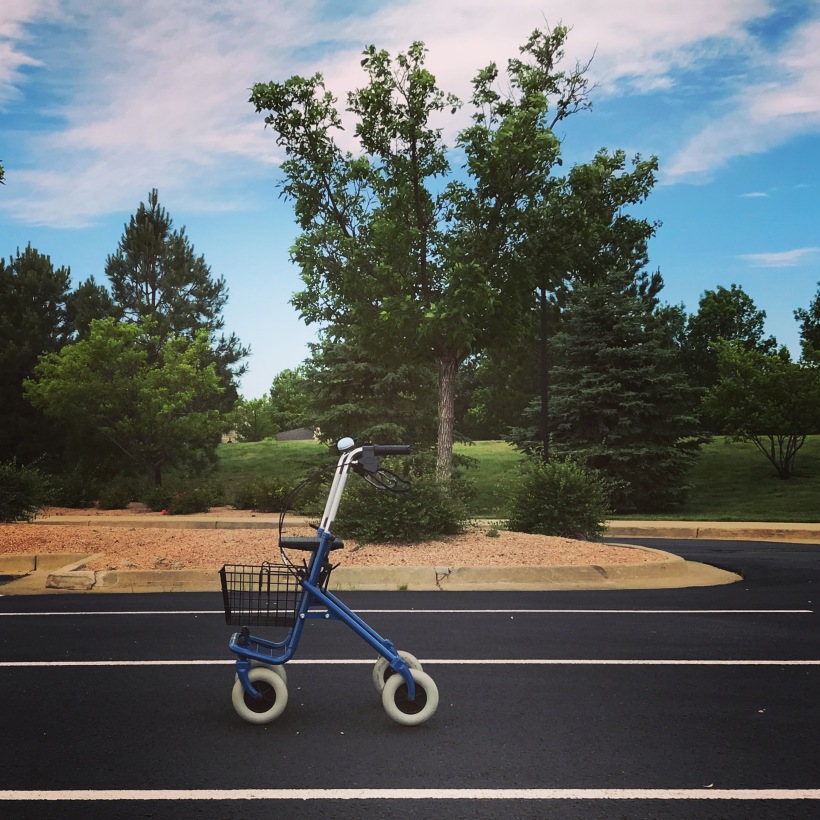
“Let me show you how to engage the brakes,” I say squeezing them and asking him to try.
“I’m going to need a new driver’s license,” he says, chuckling.
The state revoked his license after he totaled Mom’s van.
Now he is like me, the epileptic child who never learned to drive. He made himself like me.
“Keep it,” I say.
“Are you sure?” he says. “These things are expensive.”
“It’s OK,” I say. I guess I am leaving him an inheritance, too.
___
In the living room of my parents’ apartment, we talk about our hearts. Who has a hole in their heart, like Karrie? Who has an aortic aneurysm, like Karrie?
“Some of your heart problems, I have, too,” Dad says, and I can tell he is excited for the connection.
Why do our connective tissues have to be fucked up?
Scott asks me about Salt Lake City, talks about being Mormon. “I drink coffee and beer. I could never give them up.”
He is Mormon by shotgun.
I don’t tell him about Granite Mountain. “I almost converted,” I say. “But I could never give up coffee, either.”
We laugh.
Mom gets out her camera, directs us to stand together for a family photo. She is finally getting it: one last picture of us all together.
Is it real now?
When I leave, my father follows me out the door and shouts, “I love you!” across the parking lot. He looks so frail, so weak, like he can’t hurt me anymore, but then I remember the secret money. He is still hurting us. The heart of this father does not turn toward his children.
I’ll never understand why he did it.
He never loved us.
___
A month later, on the anniversary of Judy’s death, my father mails me his Harvard Heart Newsletter with an article highlighted:
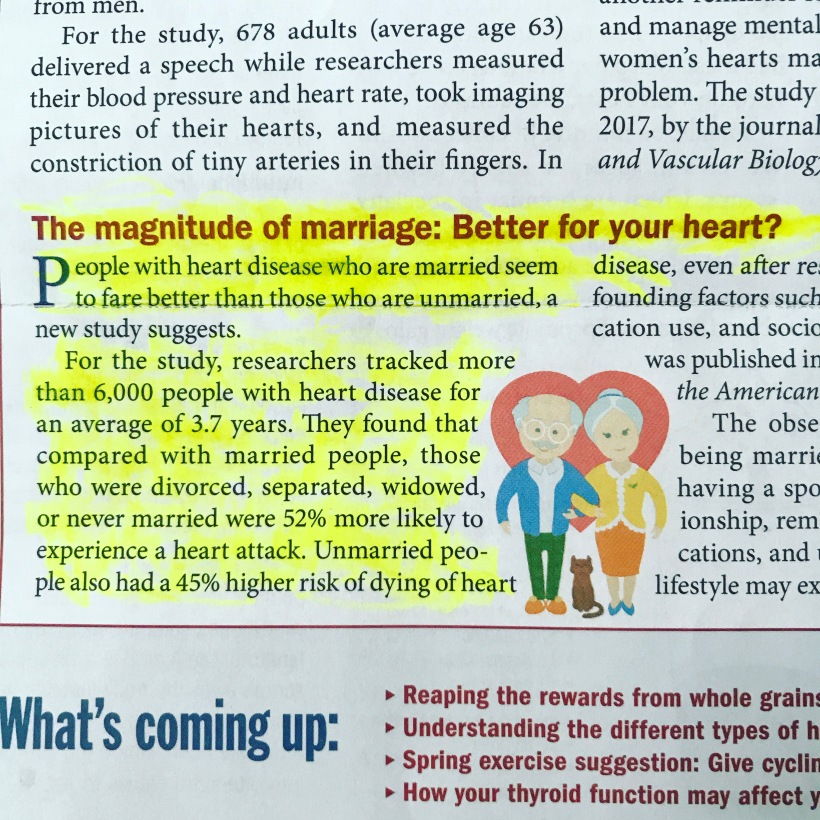
Marriage is saving his heart.
I’ve never hurt my wife–your mom–physically, but mentally I guess I did for … I don’t know why now. But I thought I would have time to make it up.
Protected: epigenetic resurrection spell, inks, forgeries, magic
Losing Propositions
Today I was talking to a friend about my project of filing an IRS Referral to investigate the tax exempt status of the Association of Writers & Writing Programs, following yet another year of disability exclusion and ADA violations at the annual conference:
My friend is a lawyer, so she very gently and sweetly wanted to make sure I understand I have zero chance of winning–not to discourage me from trying, but just to make sure I know what I’m up against. This is a very tough area of law.
She was much relieved when I said, “Oh, of course I am going to lose!” (Followed by my foghorn laughter!)
I told her about my ongoing performance series called Losing Propositions, in which I barrel into battle knowing full well I have no chance in hell, and in fact, it is the entire point: It’s the performance I am interested in, the idea that having nothing to lose is, in its own way, an extremely powerful position from which to operate.
I can scream and yell about AWP online because everything they could take away from me — seats on panels, a slot at a reading, maybe a guest post on their site — is already gone.
And here is a space in which I feel extremely comfortable. Happy, even. Is that weird? It’s my happy place, diving deep into legal research knowing full well the deck is stacked.
In 2015, when I was applying to PHD programs, it started as a performance, too. I was angry about AWP’s systematic rejection of every single disability panel, and I had always wanted to earn a PHD. These two things are not disconnected: AWP is primarily a network of member educational programs, and those programs are inherently ableist at their core. I thought, OK, I will apply to programs and seek accommodations in the process (primarily, a waiver of the GRE), and I will Facebook-blog each response publicly.
I expected every single program to slam the door in my face.
But do you know what happened? The very first school — my dream school, in fact — said yes. And then another school did, and another. Each one that said yes made a stronger case for the next school because I could list them all and say, “Seven other programs have granted this accommodation, which speaks to it being reasonable under the ADA.” It snowballed. By the time it was over, I had applied to so many programs I cannot remember the number now.
When schools denied my accommodation request, I argued my case and asked them to reconsider. If they continued to dig in their heels, I sent them research into the futility of the GRE in predicting success, particularly for underrepresented groups. When they dug their heels in deeper, I FOIA’d them, seeking very specific data that might help me estimate how many people in their programs are disabled, since schools do not keep track of disability as a form of diversity.
I got data dumps like you wouldn’t believe.
I posted everything on Facebook. Again: performance. Nothing to lose. Performing my losses.
But see? It was the “not having anything to lose” that fueled it. Thinking of it as performance made me powerful. Made me invulnerable to the pain of losing. Made me BOLD. But then, as often does in my work, performance became reality. In fact, some of those programs have since dropped the GRE requirement altogether. I can’t take credit for that development, but I can take satisfaction that my “test case” was on the right track.
Test case.
That’s what my friend said when I told her about this performance series. “You’re a test case!” She told me about historical cases where activists essentially did the same thing: they knew they were going to lose, but they had to at least try. Sometimes they won. Sometimes they lost, but — and this is key — got their enemies to come out and state their true position so they knew what they were really up against. And from there, they formulated new strategies.
I never thought of what I’m doing that way, but I like this framework. When I approach things like filing an ADA complaint against AWP in 2015:

I think, somebody has to do it. Why not me?
Back in 2016, when I got that letter from the DOJ, I didn’t know what I had in my hands. I had a right to sue letter. Again: losing can be powerful all on its own. And as another disability activist told me, this letter is beautiful. It shows how long we’ve been fighting.
Every year, AWP treats our disability access & representation as a brand-new problem, as if we haven’t been fighting this fight, traveling in this same circle, over and over. But here we have proof. Legal proof. It is beautiful.
This is why I do it publicly: on social media, on my blog, in essays, in Twitter rants. I am performing justice. I want to show people it matters enough to fight–even if the odds are stacked against you. The process, the fight, the boldness, are what matter.
I know I have less than a 1% chance of winning on this 501(c)3 thing. That’s OK with me because … what if I do win? What if I’m the test case that becomes case law?
In 2016, when I moved to Colorado, I made protest art about the missing sidewalks and curb cuts. Everyone told me it was a waste of time. They had never seen a city respond to such a thing.
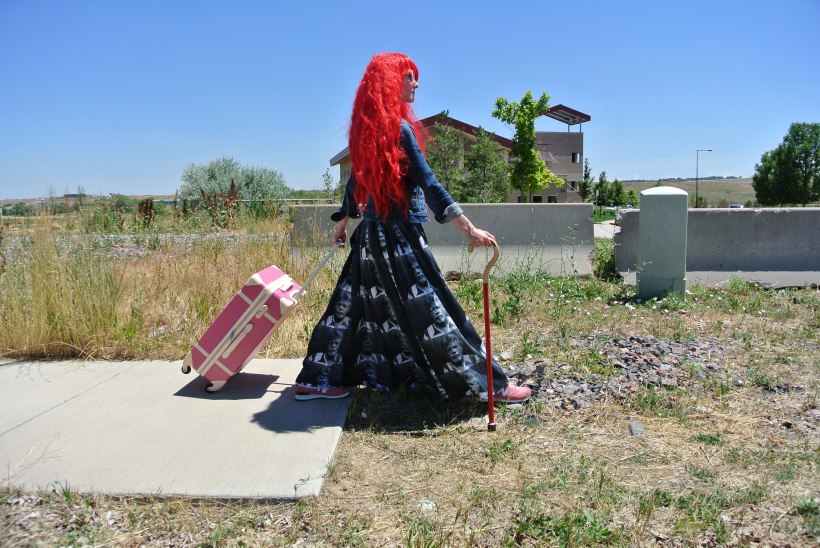
Do you know what happened by the end of that year? That sidewalk above got paved & the curb cut installed. The City saw my protest photos and just did it.
Sometimes, once in awhile, you fucking win.
But Losing Propositions–that’s where I find my power to keep going.
When I go in with the intent to lose, you can’t take my hope. You can’t take my dreams. You can’t even take my time.
If you tell me I am wasting my time studying 501(c)3 case law, I will tell you about how much I learned about the history of disability rights in education, like this case from my hometown. I will tell you how much I loved formulating a strategy, looking for ways to push disability justice forward. How can that be a waste of time?
Losing, sometimes, is winning.
visiting my brother’s grave for the first time
CW: death, graveyard, car accidents (in newspaper photos and headlines)
On the anniversary of Challenger, I visited my brother’s grave for the first time.
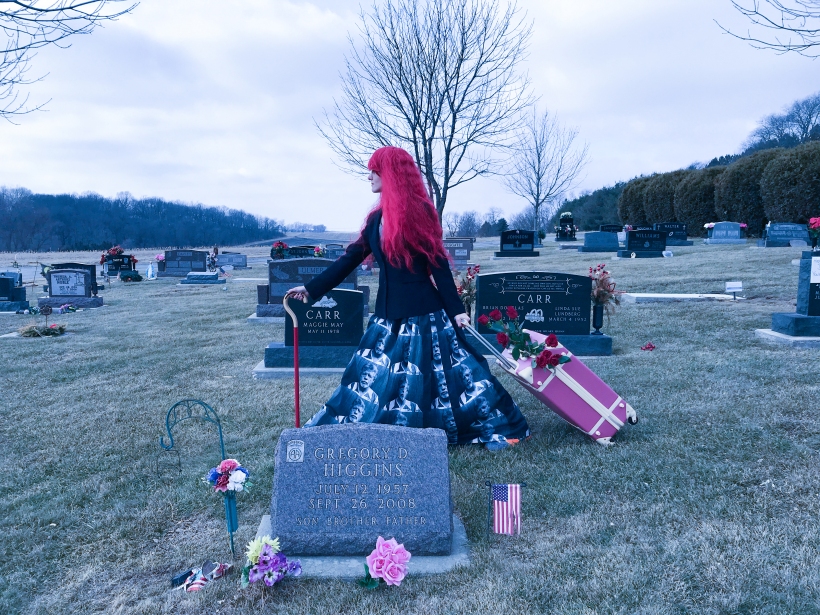
If you have read my work, you know this date is significant to me. Two days after the last time I saw my brother, I watched the Challenger disaster on TV. I confuse NASA Public Affairs Officer Steve Nesbitt’s voice with my brother’s.
I’ve made spectrograms comparing them:
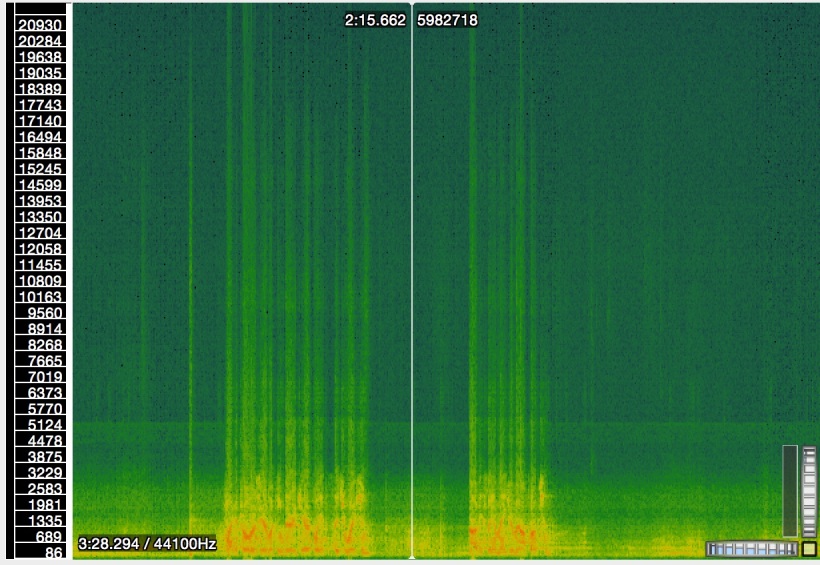
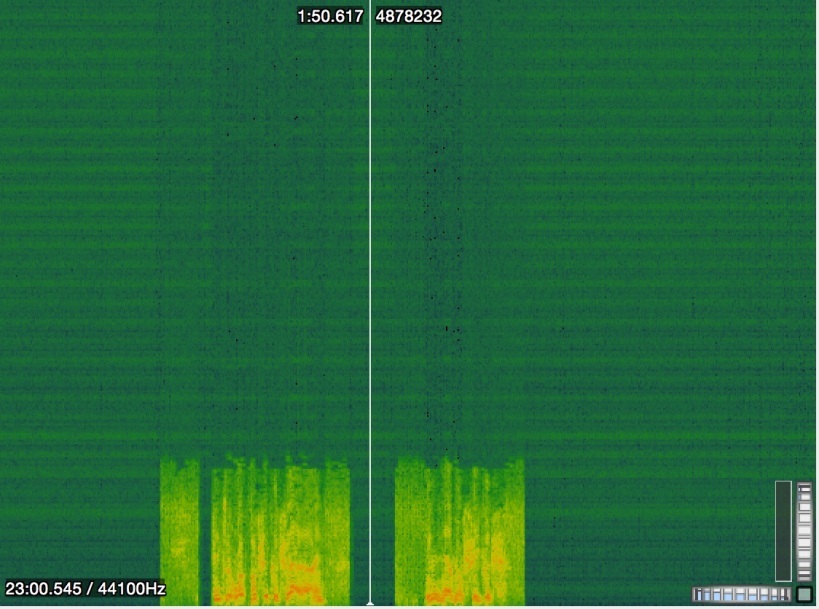
I didn’t plan to go to my brother’s grave on the Challenger anniversary. My husband and I traveled to Cedar Rapids for my Aunt Joann’s funeral and my appointment with a geneticist.
We had very little time — only a few minutes — and we had to sneak to the cemetery without telling my family. I needed to be there alone. I needed to process it without the sibs or my father.
Except I can’t go there alone, not really: no buses reach it; I can’t drive. My brother’s grave is unreachable except by car. Even grief rites are inaccessible sometimes.
As we drove toward the cemetery, we passed Prairie High School, and I gasped. “We are in the territory of my brother,” I said. “This is the land of Greg.”
He lived near Prairie High, attended Prairie High. I lived to the north, attended Kennedy. We had different geographies. Sometimes it didn’t feel like we came from the same city.
When we turned onto Highway 30 and passed the ADM plant, I said, “This is the land of my father.” It’s where he worked my whole childhood.
It was the land of Greg, too. “My brother had his first life-changing injury there.”
I have always felt like that factory ate my brother.
“Watch out for the fog. It creeps over the highway and causes accidents. That ethanol factory eats cars.”




It felt like the ADM plant was standing sentry. Or maybe my father was. I always feel like he is there, at ADM, watching.
When we turned into the cemetery, I found my brother’s grave without even having to wander.

It felt like somehow I had always known where he was.
It was cold–not just any cold, Iowa cold. My hands froze so badly I could not control them at the end of the shoot, when we returned to the car so I could change my skirt and wig to rush to my mother’s apartment. I couldn’t open the wig bag or slide the cap over my head. My fingers refused to grip. I cried. I needed to get that red wig off me. It’s the hair I associate with Greg. It’s a secret. The skirt, too.
My joints hurt. They were all out of place. The pose caused subluxations in my ankles and knees from my newly diagnosed Ehlers Danlos Syndrome. It’s excruciating to stand and balance like that for my ataxia & syringomyelia, too. That’s why I chose the pose: it puts me in Parallel Stress (see my other images in this series at this link).
We had to hurry so nobody would wonder where we were. I didn’t have time to process it. I am still processing it.
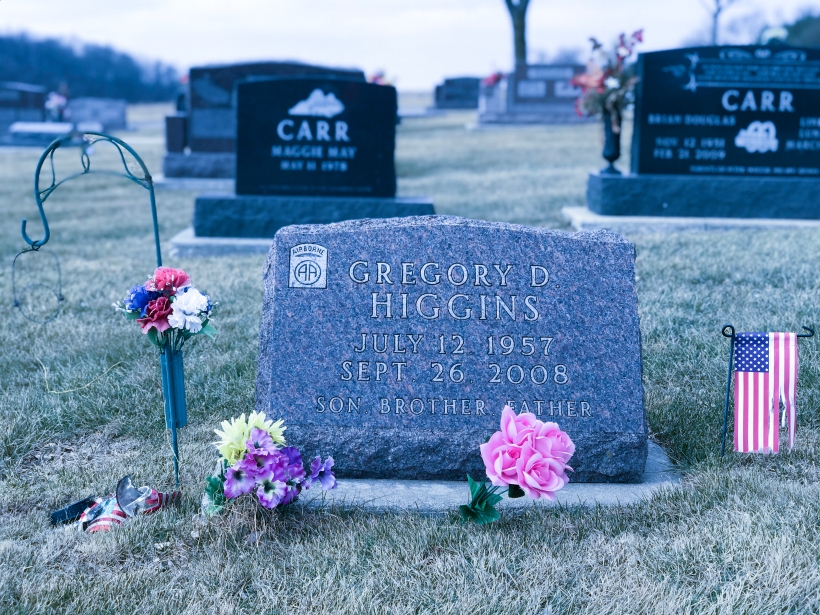
The last time I saw my brother alive: Challenger.
The first time I saw his grave: Challenger.
That I have to keep my grief secret: obviously a major malfunction.
Life of the Mind Interrupted by Katie Rose Guest Pryal

CW: mention of suicide, descriptions of ableism
Last week, I was talking to a friend about dropping out of my PHD program before I even began. “Honestly, I think it’s the best thing,” I said. “I would probably be in bipolar crisis if I had done it.”
My friend nodded. She’s disabled, too. She gets it. We both earned Masters Degrees. We both got sick, faced hospitalizations, survived manic episodes and more — all while trying like hell to churn out good work and not scare off our classmates and professors.
When I said, “I would probably be in bipolar crisis,” I didn’t mean I couldn’t do a PHD program. I meant PHD culture is toxic to people with disabilities. Before I delayed my admission (and later dropped out), I had pursued accommodations for my assistantship. At one point, Human Resources point-blank asked me how I ever expected to work in academia given my limitations & needs. When I said I had no intention of ever pursuing a career in academia, they were relieved. “You are much more likely to get the accommodations that way,” I was told.
Which is why when I learned Dr. Katie Rose Guest Pryal had written Life of the Mind Interrupted: Essays on Mental Health and Disability in Higher Education, I was ecstatic.
As a novelist, attorney, freelance writer, and former law professor, Dr. Pryal became a major voice for disability rights in higher education after she took a sabbatical from teaching and spoke up about her mental illness in the Chronicle of Higher Education:
But I feel anxiety for another reason as well. I have a psychiatric disability—that is, a mental illness—that I’ve kept secret since I was diagnosed at the age of 21. So when the teaching evaluation called me “emotionally eratic,” I feared that my supervisors would believe the words. And, despite all evidence to the contrary, I feared that Mr. Eratic might be right.
Mostly I feared that everyone at work would learn about my secret disability, and that I would get fired because of it. I feared I would be seen as unreasonable, irrational, and therefore unable to do the work required of a professor. Because of my disability, my career would be over.
Much of Life of the Mind Interrupted draws from her columns in the Chronicle, as well as other essays, with updates and expansions. Covering everything from the tenuous, terrifying tightrope walk of adjuncting-while-disabled to practical advice for classroom accessibility, Dr. Pryal not only dismantles academic ableism; she makes the case for how easy it is to be accessible — and how it benefits everyone.
In “Disclosure Blues: Should You Tell Colleagues About Your Mental Illness?,” she writes about Elyn Saks, a professor at University of Southern California who gave a TED talk about disclosing her schizophrenia:
Sak’s advice is written from the position of a tenured professor, with great academic privilege, the most important one being near-bulletproof job security. But there are other privileges that come with the type of job she holds. For example, she gives the following advice to professors with mental illness: “Schedule your courses carefully. If your meds make you tired in the morning, try not to teach morning classes. Try to choose courses you like to teach — you will do a better job and feel less stressed.” As any contingent professor knows, we often choose neither our courses nor our class meeting times.
The first time I sought a scheduling accommodation as an adjunct, I lost my job. I was teaching online, and each class included a live weekly webinar. I always selected sections with daytime or early evening webinars: late nights = seizures. When the department overhauled the scheduling system, instructors lost control over seminar times, and I was forced to seek accommodation.
My department’s response? Tell fellow faculty about my epilepsy, beg for a daytime seminar, and hope for the best.
“That is not how accommodations work,” I told my department director. “I shouldn’t have to expose my private medical information to colleagues.”
Epilepsy comes with serious stigma: People think you are devious, crafty, lazy, dishonest, and dangerous. They doubt your intelligence, too (never mind intelligence is itself an ableist measure.) I’ve been called “idiot” or the r-word a lot when people find out about my seizures.
My director fired back. “You never told me you were disabled before.”
I wasn’t fired. Oh no, they knew enough not to outright can me. Instead, they withheld information, resources, and student contact lists, making it impossible to fulfill my duties. If I emailed my director with a question, he would critique my email instead of answering. “Learn how to write shorter emails,” he quipped once, after I sent him two paragraphs detailing a complex & urgent issue with a student. He was calling into question my competence, just as I had feared.
The saddest thing? None of it had to happen. The original scheduling process was accessible: We chose our times and that was that. No scheduling accommodations needed.
And that is a key point of Dr. Pryal’s book: accessibility and accommodations are not the same thing:
But the accommodations model requires us to disclose our disabilities, it requires us to explain, to give up secrets we might not want to share. The accommodations model depends on invasions of privacy to work.
Accessibility, alternatively, means that a space is always, 100% of the time, welcoming to people with disabilities. Accessibility means that ‘accommodations’ are integrated into a space and are not particularized to an individual–but rather created for our society as a whole. We, as a society, are disabled people. Therefore we, as a society, build spaces and procedures for disabled people.
It really is that simple.
And she shows how simple it can be with her “universal design alternative to the whiteboard,” in which she projects a blank document from her laptop onto a projection screen and writes a daily “class record.” Each week, she saves the file and emails to the entire class. “And my students really got into it,” she writes. “‘Put that on the class record!’ they would request during class, when I said something they found particularly helpful.” This was all in response to a student who couldn’t see the whiteboard and requested lecture notes in PDF. Accessibility benefits everyone. No barriers. No documentation. No invasion of privacy.
That last bit is key. Remember I mentioned my PHD assistantship accommodations? To get those, I not only had to declare I wasn’t pursuing an academic career; I had to turn over medical records and discuss — at length — my mobility limitations, mobility aids, and medication side effects. The medication side effects turned out to be more important than my actual disabilities: Side effects are easier to understand, easier to “prove,” and easier to accommodate. It was awkward and invasive. I felt like I was talking to a medical assistant, not my HR department.
And what about instructors and students who lack access to medical care? Or women of color, whose pain goes disbelieved, denied, and untreated? Transgender colleagues and students, who face misgendering and abuse at the hands of doctors? The very concept of “documented disability” is exclusionary so long as access to documentation isn’t equal.
As Dr. Pryal writes, “we cannot ignore how race, gender, socioeconomic, and other kinds of privilege affect how people with disabilities live and work.” In “Shattering the Madness Monolith,” she shares stories of academics with diverse identities. One of them, speaking under the pseudonym “Annie,” reveals how she struggled to receive medical treatment as a Chinese-American woman, with one doctor even telling her “it was normal for Asian women to be anxious and stressed out, and anxiety was causing my abdominal pain.”
When I was a graduate student, a faculty member joked that proximity to a certain faculty member caused a couple seizures. The implication: my seizures are sexual. I don’t think anyone would have made that joke if I were a man.
Probably my favorite essay is “Breaking the Mad Genius Myth,” about Kurt Cobain and the romanticization of mental illness as “genius.” Of all the myths about mental illness, this one has done me the most harm: Bipolar robs me of credit for all my hard work. Don’t ever take medication, people will say. It will ruin your writing. They are wrong. As Dr. Pryal argues, creative people are more productive when their psychiatric symptoms are under control. For years, I bought into the myth, though. I believed medications dulled my shine. Now I know better, but I still have to listen to people deny my hard work and praise my epilepsy & bipolar as “genius.” At the same time, literary colleagues have outright accused me of exaggerating my experiences because they perceive me as “that unreliable crazy person.” That’s the problem with “mad genius.” It’s inherently “unreasonable,” as Dr. Pryal points out. The whole “genius” of it lies in being beyond “normal” reason.
While the myth of the “mad genius” romanticizes mental illness, the taboo around suicide & suicidal ideation is strong as ever. As Dr. Pryal writes in stunningly honest, heartbreaking prose, “Suicide didn’t almost kill me. The taboo did.” Taboos make us keep secrets. Taboos keep us from seeking help. Taboos keep us from asking for what we need.
Now imagine your career depends on living the “life of the mind” and you’re suicidal.
Ultimately, the reasons I couldn’t do my PHD program came down to the smallest things: I needed Paratransit; it’s not included in the student bus pass and too expensive. I needed a part-time load; part-time is not allowed. Other things, too. Along the way, as I delayed my decision, more than one doctor told me, “I’m worried about you doing a PHD.” One went so far as to say, “Don’t do it.”
“It will throw you into bipolar crisis,” she said. “I see it all the time.”
Which is why I am recommending Life of the Mind Interrupted to everyone.
___
For more of Katie Rose Guest Pryal’s work, find her at https://katieroseguestpryal.com/ and The Chronicle of Higher Education
ink magick for a dental stem cell transplant
Want to read about some of my ink magick? Find it right here. I chose the page rather than post format because it’s formatted partly in two columns and needed more width. Enjoy.
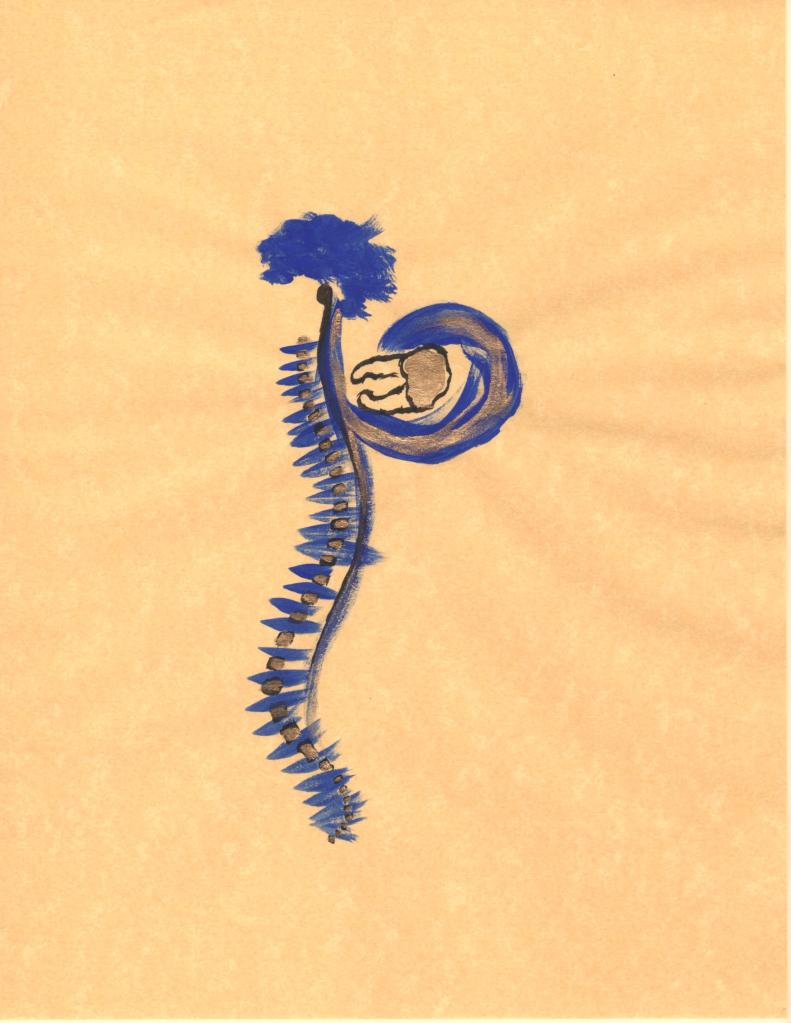
Winter Kills
Today is the one-year anniversary of the MRI that diagnosed my syringomyelia.
It was supposed to be a routine checkup after seizures. Sort of. My neurologist got freaked out by my gait, my abnormal smooth pursuit eye movements, my asymmetrical reflexes. She ordered a c-spine. We never did that before — only brain.
The techs blasted Prince into my headphones. In every MRI before — and I have had a lot of MRIs — I dozed off, hypnotized by the clang clang clang and bang bang bang. I slid into the tube expecting a nap. Instead, I panicked. Sometime during the Purple Rain guitar solo, I tried to lift my head. My neck burned like a beheading with a blade of fire. I am paralyzed, I thought. I can’t move my neck. I can’t move my neck. I can’t move my neck.
I kicked my feet. Screamed: GET ME OUT OF HERE. GET ME OUT OF HERE.
I knew. My spinal cord knew. All this time, it had been transmitting coded messages in the strange movements of my eyes, like a political prisoner paraded out on TV. Classified intelligence about a biological weapon implanted in my backbone. My own body turned traitor. This is not a democracy anymore. You do not get to choose. You can’t move your neck. You can’t move your neck.
“Winter Kills” is the soundtrack to the first time I saw the first syrinx in my spinal cord.
Alone, at home, MRI disc popped into my MacBook:
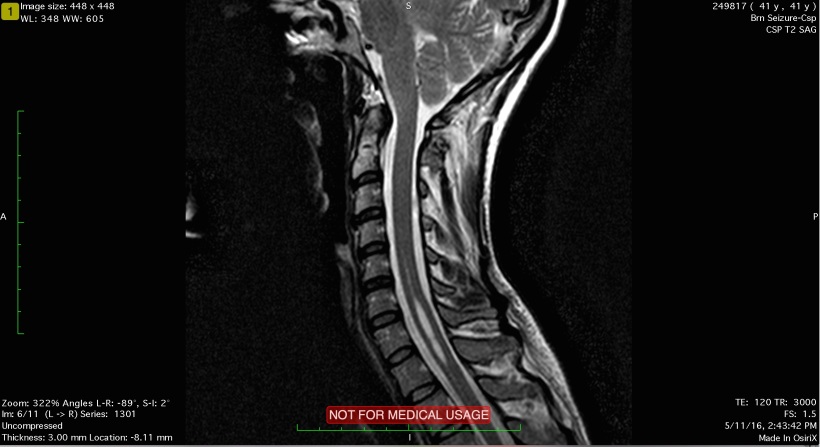
I knew what that hole in my spinal cord was. If you have Chiari like I do, you know.
On TV: The Americans. “Winter Kills” in the background as KGB agent Elizabeth Jennings rifles through her friend Young Hee’s house for the access code to a biological weapon.
“The Day After” episode, when the Jennings family watches a made-for-TV movie about nuclear apocalypse, and they know: they are living, breathing weapons of mass destruction. They are quickening the End of the World.
“I was thinking about not telling the Center about this,” their contact in the bioweapons lab says. “I’d like to make the right decision… Nobody needs this. I don’t trust us with it.”

The Day After was a real movie. I watched it as a kid. I lived in terror of nuclear bombs because, as we were told in school, Cedar Rapids was a prime target:

Cedar Rapids, Iowa: land of Rockwell Collins, makers of military aircraft communications and space shuttle parts; Duane Arnold nuclear plant; the bread basket of the nation. The Russians are going to nuke us. The Russians are going to nuke us. The Russians are going to nuke us. Nuclear winter is coming. They drilled it into our heads. The first Wednesday of every month: civil defense sirens. Take cover.
Same as the tornado siren. I started to confuse tornadoes with nukes. Tornado shelters for bomb shelters. Tornado drills at school with duck and cover.
Later, I thought it was all a lie, but it wasn’t. On maps of a 500-warhead scenario: a triangle marking my childhood industrial wasteland in a flyover state nobody cares exists.

The Day After aired November 20, 1983: one month before my brother Jimmy died. I have always associated nuclear bombs with brother death. And there I was in 2016, in the middle of a resurrection spell to bring my other brother Greg back to life, and I made myself a spine like his:

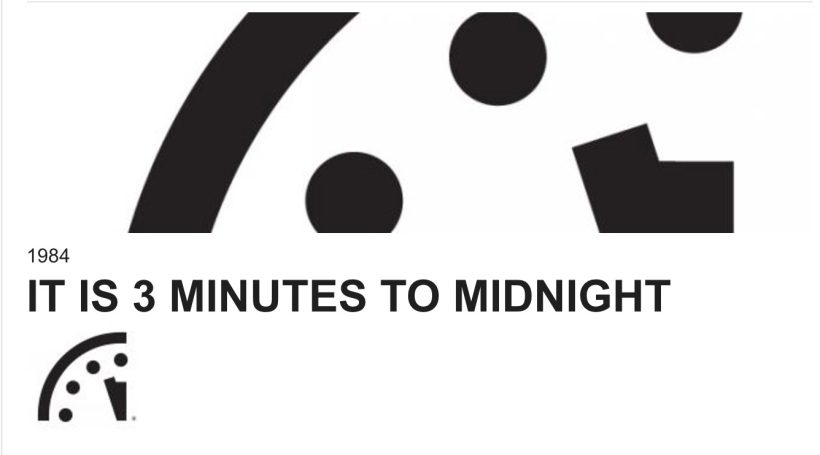
U.S.-Soviet relations reach their iciest point in decades. Dialogue between the two superpowers virtually stops. “Every channel of communications has been constricted or shut down; every form of contact has been attenuated or cut off. And arms control negotiations have been reduced to a species of propaganda.”
Resurrection has consequences.
Tear at me, searching for weaker seams.
I’ll tear at you, searching for weaker seams.
Resurrection and apocalypse. Resurrection requires apocalypse. Resurrection is apocalypse.
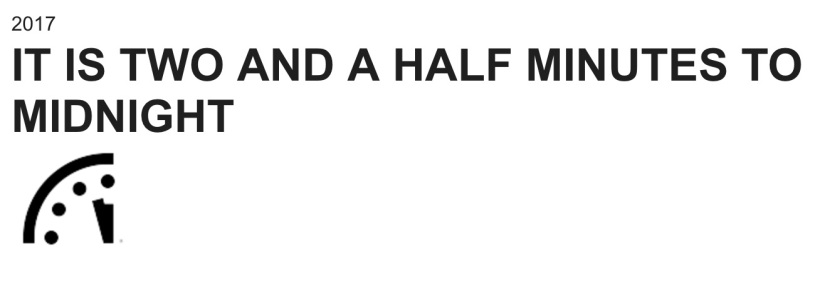
For the last two years, the minute hand of the Doomsday Clock stayed set at three minutes before the hour, the closest it had been to midnight since the early 1980s. In its two most recent annual announcements on the Clock, the Science and Security Board warned: “The probability of global catastrophe is very high, and the actions needed to reduce the risks of disaster must be taken very soon.”
Nuclear winter is coming.
I am caught in a time loop: Comey canned, the president laughing in the Oval Office with the Russians who conspired to tear at us, searching for weaker seams, hacking intel about our election, turning our own democratic bodies against us.
tick tick tick
oracle of flesh and bones: a review of Body Cards by Courtney Putnam
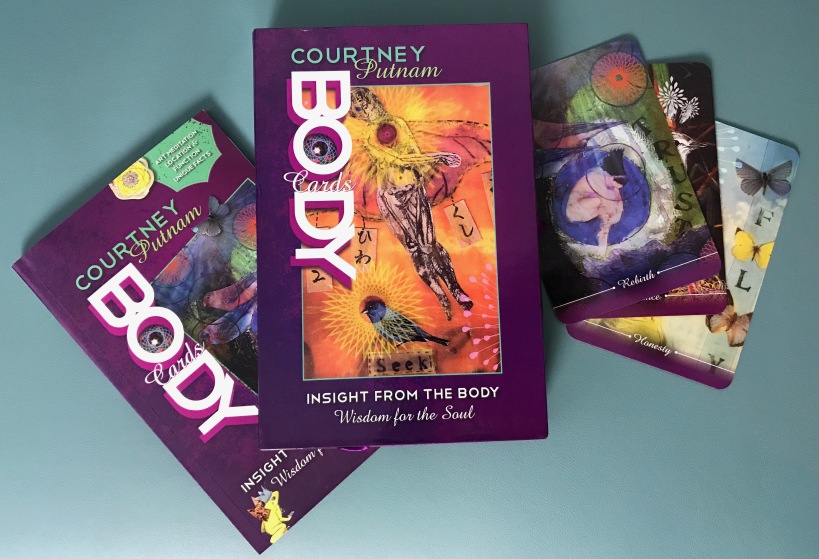
Body Cards: Insight From the Body, Wisdom for the Soul by Courtney Putnam appeared in my mailbox during a time when I would rather do anything than think about my body.
Last May, one month after signing a lease on a new apartment in a new state, my neurologist ordered a c-spine MRI after she witnessed drastic changes in my gait.
Ataxia, she called it. From the Greek: a/”without” + taxia/”order.”
Without order. Disordered.
I showed her my balance test results, ordered by an ENT when he saw how I walked. Diagnosis: abnormal smooth pursuit.
“Follow my finger with your eyes,” she said.
I did as told.
“Yep. Not normal.”
The month before that: seizures when a new epilepsy med failed. Banged my head hard. “They weren’t like my normal seizures,” I told her. “No aura. Just BAM, down.”
I showed her my dental x-rays, tooth 19 shoved out of place. Told her we got me plastic dinosaur dishes because:

We expected another traumatic brain injury. Instead, the MRI found this:

My first syrinx, a hole in my spinal cord. Diagnosis: syringomyelia.
These days, I walk like I am drunk. People think I am drunk. If a cop wanted me to follow his finger with my eyes, he would think I was drunk, too.
My shoulders, scapula, and neck burn. I wake up panicked the bed is on fire. My spinal cord is a lit fuse, tick tick tick to paralysis.
Which at first made Body Cards a scary proposition. I am never not thinking about my body. I have to breakdown the kinetics of every step, like a Muybridge series in my mind.

Credit: Wellcome Library, London.
But — full disclosure — I know Courtney from my MFA program in creative writing. I love her art. I trust her heart. I knew I was in good hands when she sent me the cards to try (also full disclosure: I loved them so much that after I left the accompanying book at a hotel, I bought a second deck for myself!).
For Body Cards, Courtney gleans wisdom from years of working with clients as a massage therapist and Reiki Master. Her poetic imagination and deep connection to the body emanate from her colorful collages. The cards are large with rounded corners, printed on a slick, high-quality card stock that is durable and easy to shuffle. Holding them, I sense the care that went into their design.
As Courtney writes in the book, the cards “draw upon the idea that the human body is not a complex organism complete with the powerful ability to heal, but also a tremendous resource for us in terms of understanding our very lives.”
“Your body is your map your muse and your medicine,” she writes.
Cerebrospinal fluid is 99% water, I thought, when I flipped opened the book and discovered those words. Water extinguishes fire. Let’s see what these cards can do.
___
I. (No Spread – A test of sorts.)
Cerebellum: Grace

For my first reading, I went straight to the cerebellum card. I wanted to see what it brought up, how I connected to it. I have Chiari malformation, a neural tube birth defect that means my skull is too small for my cerebellum, can’t hold it in. My cerebellum has nowhere to go but down down down through the foramen magnum, spilling into my spinal canal. The compression makes me dizzy, makes me stumble, sends me into word-finding spirals, gives me pressure headaches at the back of my skull.
It gave me syringomyelia, too, clogging the flow of my cerebrospinal fluid until it formed little whirlpools inside my spinal cord.
If I could connect to this card, I could connect to the whole deck.
From the book:
Without a well-functioning cerebellum, we could struggle with our balance and coordination … On a metaphorical level, embracing grace means to embrace beauty, love, and forgiveness. What in your life is in need of this humble cerebellum energy?
When the cerebellum card waltzed into your reading, it’s time to seek out grace. First take stock of your actions toward yourself and others. What could use some softening, some lightness, some love?
The cerebellum card asks you to forgive yourself for the times in which you have been a little clumsy.
I forgive my childhood neurologists 100 times a day for never catching my birth defect even though they did a million MRIs for my epilepsy. For calling me hysterical. Which is to say: I haven’t really forgiven, because I have to keep doing it.
Abnormal smooth pursuit of forgiveness.
How do I forgive a whole city? I came here for a fresh start, an education, a chance to show my childhood neurologists they lacked imagination when they said I may lack realism in my aspirations. Every path out of my apartment complex ends like this:
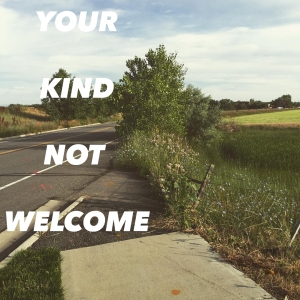
Abnormal smooth pursuit of a way to reach the cafes, the bookstores, the library, the health food shop: people. Humanity.
Every morning, I circle the hospital next door.
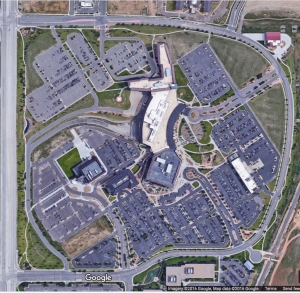
two laps=one hour
My walking cane taps taps taps. From a drone, I am the minute hand tick tick tick.
I am restless as a clock face.
The first thing I said as the moving truck pulled into my new neighborhood: “It looks like my childhood.”
We didn’t have sidewalks leading out. We didn’t have a bus stop. I walked alone on the shoulders of four-lane roads in the dark. I balanced on railroad tracks (I could do that then). I spent a lot of time alone.

Twenty-seven years post-ADA. Twenty-seven years post-ADA. I forgive 100 times a day.
I need some kind of prosthetic grace, the grace of a sidewalk. The grace of a car, but I cannot drive. The grace of a bus, but transit is not accessible. The grace of friends who drive in for a visit.
I start to mark off days alone.

By December, it looks like a DNA test. My DNA test. Bisulfite mapping of my methylation marks would look like this. Isolation methylates DNA. Obliterates genes. Marks people.
[I forgive 100 times a day.]
Tinnitus like air raid sirens. I Bluetooth rain recordings into my hearing aids, drown out the alarms.
Recordings are not like real sound, 3d sound, the intonations in human voices. People who get out don’t know that. They think sound is sound, voices on TV are just like real life, but they are not. I am starved for human voices.
“You need to get out. Listen to people. Talk. Hear birds chirping. Airplanes. Car horns. All of it,” my audiologist told me after my hearing tests. “Isolation makes tinnitus worse.”
Can’t think. Can’t focus. I lost the prosthetic grace of my epilepsy medication when we moved here. Traumatic brain injuries, spinal cord like Swiss cheese, the terror of the holes expanding every time I fall fall fall like my brain through the foramen magnum. I lose books and find them again and lose them again. I get voice mails purr purr purr of my vibrating phone and forget until weeks later oh I gotta call them back.
“You need to get out,” my neurologists say. “Join groups. Go to lunch. You need to stimulate your brain. You need to be in novel situations.”
But:
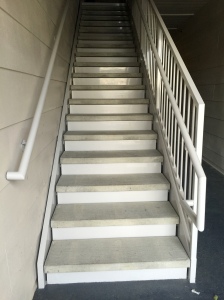
We told the landlords we needed an accessible apartment, told them about my walking cane. They said it would not be a problem.
Get out. Get out. Get out. Everyone told me that in Utah because of the air: smog so toxic it was like smoking a pack of cigarettes a day. Come to Colorado. Come to Colorado. We have clean air.
I am here. I am breathing your air. Did you know isolation is as bad as smoking 15 cigarettes every day?
[Driving pollutes, but so does not driving. Catch-22.]
Did you know isolation can make you hear things? Make you forget things? Make you doubt things? Make you dead?
I post on Facebook. I sound too sad.
[I delete 100x a day.]
April sun and medication changes bring mixed mania, mixed mania, mixed mania on rapid cycle. I lash out on Facebook. I fuck up.
“But Karrie,” a friend texts after witnessing it. “You know isolation is illegal in animal experiments, right? Because the animals lose it.”
I have to forgive myself for breaking. Breaking is normal.
[Which means I am not broken. Not yet.]
[27 years post ADA, I learn to take my vitals every day. When my heart is thunkthunkthunkthunk and not beat ___beat ___ beat___beat I know to pull the plug and _______flat line___________on Facebook, on Twitter, on Instagram so nobody has to see who I am when I am broken.]
I circle the hospital in the morning. I circle the hospital in the afternoon. I circle the hospital all day long.
I am my own metaphor. I think that’s a kind of grace.
I don’t know about forgiveness yet [100x a day].
___
Thoughts after my Cerebellum card test: At first, the connection between the cerebellum and forgiveness frightened me. If my cerebellum is compressed, is my capacity for forgiveness, too? But it wasn’t like that! The cards do not “diagnose” “deficiencies”; they inspire personal journeys. As with many divination decks, they are what you make them. I made them into disability poetics because that’s who I am and what I do.
Courtney suggests wearing magenta or white and using rosewood and ylang ylang oils to stimulate the crown Chakra. Rosewood and ylang ylang! I want to make a hair powder with them so I can catch the scent throughout the day and remind myself of what I wrote. Maybe even to forgive myself.
“Elevate an activity or thing with purpose, meaning, significance and beauty!” She writes. “How might brushing your teeth, doing the dishes, buying groceries, or changing the oil in your car become mindful and enlightening?
Every movement is mindful for me right now, but not in the way she means. My mindfulness is locomotive, automatic, unintentional and sometimes, fear-based. And yet, it has changed how I think about everyday moments. I have started to see the staircase outside my door as my backbone. I was doing that before Body Cards, but now, I am turning it into a conscious meditation on forgiveness. How can I hate this inaccessible apartment, how can I fear those stairs, when they are me? I can forgive this building for being disabled, missing an elevator. (It is disabled like me!) I am it, and it is me. Not sure how I feel about it yet, but it’s a start.
___
Body Cards offers several spreads of varying complexity: Present Moment, Letting Go, Transformation and Chakra. I decided to try “Letting Go.” It’s simple and tells a story.
II: “Letting Go” Spread
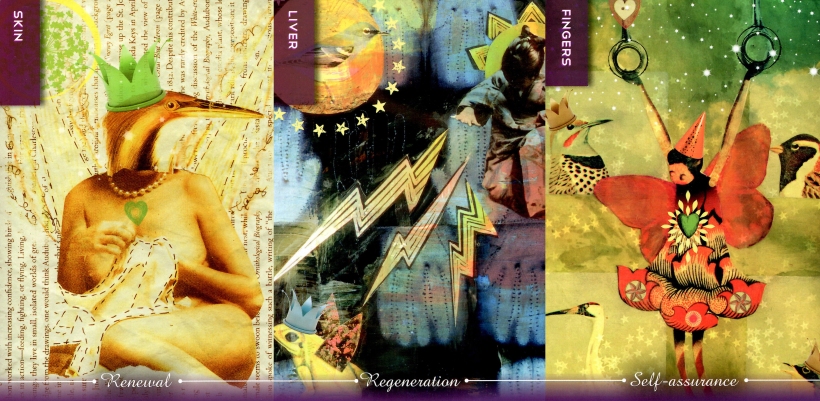
1st card= “The Issue”
2nd card = “What’s holding you back?”
3rd card = “What will help you move forward?”
THE ISSUE: SKIN/RENEWAL: “If the skin has sloughed its way into your cards today, it may signal a time of shedding your attachment to the past.”
Chakra: heart
Color: pink
Pink! I am the woman with the pink hair, pink tennis shoes, pink cane, pink coat, pink suitcase, pink purse. One doctor at NIH, where I am enrolled in a syringomyelia study, even called me the Pink Lady because of all_that_pink.

I told my husband the first time I bleached my hair to go full-on unicorn since high school, “If I’m going to use a cane, I am going to be sparkly and unicorn-y.” I searched for canes in pastels far and wide. I embraced them as fashion and mobility aids. I never had a moment of oh this is sad. I shed my old skin.
Or did I? I’ve always been disabled — epilepsy, auditory processing disorder (undiagnosed until adulthood), partial deafness, migraines, chronic pain, a birth defect not diagnosed until I was 39– but it’s always been invisible. People couldn’t see it unless I had a seizure, so they didn’t believe it. “You don’t look sick.”
Was I shedding an old skin or flipping mine inside out, demanding SEE ME.
Pink: heart chakra. Was all that pink because I loved myself or because I wanted to? An armor that said I love me, so you should, too?
WHAT IS HOLDING ME BACK? LIVER/REGENERATION: “If the liver card is speaking to you today, it is important to listen, for the liver offers an important message about the power of our bodies to heal.”
How can regeneration and healing hold me back from renewal?
Regenerate:
1. verb (of a living organism) regrow (new tissue) to replace lost or injured tissue.
2. Adjective reformed or reborn, especially in a spiritual or moral sense.
Renew:
verb:
1. resume (an activity) after an interruption.
2. re-establish (a relationship).
3. repeat (an action or statement).
4. extend for a further period the validity of (a license, subscription, or contract).
5. replace (something that is broken or worn out).
The first time I saw the hole in my spinal cord, I thought, I did that. I made it. Not my Chiari malformation. Not my neural tube birth defect. Me. Not my DNA. I did. Consciously.
For years, I have been working on a magic spell to resurrect my oldest brother. I call it intentional epigenetics. I am stealing his memories — learning what he knew, doing what he did. Memories have epigenetic mechanisms, which means I am physically becoming him. When I saw my syringomyelia for the first time on an MRI, I knew my magic spell had worked.
My brother had a spine like mine, fused with titanium in the same location as my cervical syrinx, injuries all the way down to where my second syrinx, later discovered at NIH, ends. My brother used a walking cane. My brother’s nerves burned.
Resurrecting my brother, though, means I cannot regenerate my own tissue, cannot heal. A healed body is fundamentally incompatible with his.
[Resurrection has consequences.]
And yet, there is no cure for Chiari-syringomyelia (surgery is not a “cure”), or epilepsy, or central auditory processing disorder, or Bipolar, or migraines, or on & on. Meaning: I cannot hope for regeneration, anyway.
[I circle the hospital in the morning. I circle the hospital in the afternoon. I circle the hospital all day long.]
WHAT WILL HELP ME MOVE FORWARD FINGERS/SELF ASSURANCE:
The first time I visited NIH, a neurologist told me I had thenar wasting. She meant the thenar eminence, muscles responsible for bringing thumb and fingers together: opposable thumbs, the thing that set early humans apart. No more walking on hands.
Thenar: Greek for palm of the hand, sole of the foot.
[Is my cane a leg or an arm?]
One of my syrinxes sits at the spot that innervates the thenar eminence. The signals are cut off, like me where the sidewalks end. [I am my own metaphor.]
The inner “C” between my index finger and thumb burns. Goes numb.
“When you start getting numb there, you know you are in trouble,” my old neurologist said. “That’s your warning signal.”
How can losing my opposable thumbs propel me forward?
I used to hang from gymnast hoops like the figure in the card. I used to pump out chin-ups. Now, I am losing my grip–literally and metaphorically.
This card also signals undue influence from society or family. I wonder about it sometimes, if I am under hypnosis of a kind: you are less than human because you walk on your hand.
I need to shed attachment to the past; my connection to my brother is holding me back, and shedding undue influence will propel me forward. There is something here. I don’t see it all yet. That’s OK.
___
Courtney suggests rose essential oil and pink clothing to stimulate the heart chakra. I wear pink every day. Drink rose petal tea. Mix rose petal infused homemade lotions. Make rose petal jellies and syrups. Grind rose petals into powder for my hair. Fairy dust. I have always done this. Prosthetic heart.
She also provides a meditation: sit in prayer pose and repeat, I trust my heart, I trust my heart, I trust my heart.
Today, I don’t trust my heart. It is filled with the undue influence of blotted out calendar days and missing sidewalks.
I will try it, though. Not today. Maybe next time the tinnitus gets too loud. Instead of water, I can listen to my voice.
Did you know the word syrinx also means a set of pan pipes, or the vocal organs of birds?

___
Body Cards by Courtney Putnam have helped me process a difficult time in my life. Looking back, I think my apprehension was whether cards like this could apply to my disabled body. So many things are made for abled bodies — streets with no sidewalks, sidewalks with no curb cuts, apartments with no elevators — that I get wary of anything “body” related. In a way, though, Body Cards were made for me (or someone like me). After all, Courtney was inspired by her healing work with “disordered,” “ungraceful,” hurting bodies – just like mine. And the cards aren’t the oracle, not all by themselves. The body is, too — my body. An oracle of flesh and bone.
Buy your deck here.
[Full disclosure again: Courtney was kind enough to send me a deck to review as I had been eagerly anticipating Body Cards for a long time, and I loved it so much I also bought a second one when I lost the book!]
Who Killed Virginia Woolf? CW: suicide; ableism; sexual abuse
In response to Amanda Lauren’s XOJane piece suggesting her mentally ill friend’s death was a “blessing.”
Content warning: suicide; ableism; mental illness; abuse; caregiver abuse; psychiatric commitment; violence; dead bodies
If you are in suicide crisis, please call the National Suicide Hotline at 1 (800) 273-8255.
If you are a victim of sexual assault in crisis, please call RAINN at 800.656.HOPE (4673).
___
The first time it happened, a stranger in Prairie Lights bookstore in Iowa City called me “the second coming.” He was pointing to a display of tote bags and t-shirts printed with Virginia Woolf’s portrait.

“That could be you,” he said.
He didn’t know I was a writer. He didn’t know I was sexually abused by a half-brother, just like Virginia. That I am Bipolar, just like Virginia. That I have tried to commit suicide, more than once, just like Virginia.
He meant second coming in body, not mind.
But I saw the dissociation in that portrait, how she floated out of her body. That’s what he sees, too, I thought. He sees I am not all here.
___
“I feel certain I am going mad again,” I say. I am reading Virginia Woolf’s suicide note to my husband, the one she wrote for her husband. I have been studying suicide notes–their art and craft, their rhetorical strategies, what it means to write them, to not write them.
I feel we can’t go through another of those terrible times. And I shan’t recover this time. I begin to hear voices, and I can’t concentrate. So I am doing what seems the best thing to do. You have given me the greatest possible happiness. You have been in every way all that anyone could be. I don’t think two people could have been happier till this terrible disease came. I can’t fight any longer. I know that I am spoiling your life, that without me you could work. And you will I know. You see I can’t even write this properly. I can’t read. What I want to say is I owe all the happiness of my life to you. You have been entirely patient with me and incredibly good. I want to say that – everybody knows it. If anybody could have saved me it would have been you. Everything has gone from me but the certainty of your goodness. I can’t go on spoiling your life any longer.
I don’t think two people could have been happier than we have been.
“She sounds just like you,” my husband says. “You have said the same words.”
___
I wrote my first suicide note in 1990. Notebook paper, ballpoint pen, folded and hand-delivered to a friend at school.
“Read it later,” I said. She didn’t know it was an advanced directive: no life saving measures.
I wish I had that note now. I want to know why I did it. Or why I thought I did it. Or what I wanted people to think about why I did it.
Who doesn’t remember their own suicide note?
___
Lately I can’t think. I can’t read. My eyes skip around l-t-e-t-ers, fill in blanks like Mad Libs. I am dizzy. I can’t walk in a _______ ______. I stumble with my walking cane like I am ______. All day: an electric hum in my ear. bzzzzzzz bzzzzzzz bzzzzzzzzzz the appliances are talking to me.
“I feel like someone who used to be smart,” I tell an old writing mentor. He says I am still smart, but I think: He hasn’t seen me in a long time, hasn’t read my work in a long time. He doesn’t know. A seizure last winter cracked two molars, knocked tooth 19 out of place. Rattled my brains.
I start books and can’t _________. I start essays and can’t _______. I grind batches of bone black ink that go rancid before I can use them. I can’t control a pen like I used to.
My signature changes every day.
Look how the line from the H stabs at “Karrie” like a spear. I cross out my own name. Graphologists call it scoring, cutting. It means suicidal ideation, but how can I know, when I can’t control the pen?
I receive radio transmissions from Saturn.
(transcript at link)
Or is it the tinnitus? Or is it a seizure? Or is it mania?
I feel certain I am going ______. I can’t _____ this time.
___
I’ve a very low opinion of my writing at the moment. This comes of correcting proofs: it’s all bounce and jerk; I want to spin a thread like a spider.
— Virginia Woolf, 5 August 1927, letter to Vita Sackville-West
___
I can’t sleep without pills.
On nights when I swallow my amitryptiline, down down down the rabbit hole I fall, landing at the portal to apartment “A,” where my brother Greg died three days before facing trial for sexual abuse in the 2nd degree.
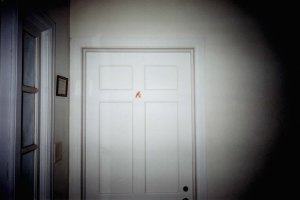
I knock.
My brother answers, a Marlboro Red dangling from his lips. He recognizes me even though he hasn’t laid eyes on me for twenty-five years. He smashes out his cigarette, yanks me across the threshold by my wrist. Inside, he pins me against the wall, leans in, licks my teeth the way he always did.
Sometimes, I force my way in. “Shhh,” I say when he protests. “I am all grown up. You can’t get arrested anymore.” This time, I pin him against the wall. I leave the door wide open. “Nobody knows I’m your sister.”
Or it plays out like this: He suspects the cops sent me undercover with a wire tucked into my bra or a transmitter concealed under a tooth cap. I strip out of my clothes, shoes to bra, to prove I am not a secret agent. I open my mouth wide, let him swab my teeth with his index finger and yank on my root canal crowns. He kneels, wraps his arms around my legs, and cries. I stroke his cowlick and whisper, “Don’t kill yourself. Don’t die. Let me save you.”
___
“I am jealous of your tidy ending,” a friend says. “His death was a blessing.”
___
“He wasn’t a suicide guy,” his Airborne buddy tells me. “He would crawl through guts and nails and shit and still keep going.”
In the police report:
In the autopsy report:
Cause of death: undetermined.
In a message from his ex-wife:
“I can tell you .. that on two different occasions I had found Greg in the same condition, in the same position. Once in our family room. And the other time in our hot tub building outdoors. That time I had to call an ambulance because he was unresponsive. It was in the wintertime, and when they finally got him on the gurney & outside where the air was cold, he started choking, sat straight up & said, “What’s going on?” He refused to let them take him to the hospital & had to sign a statement to that effect. I told him the next day I was going to call his doctor about the medications. And (this is the first time he had ever “threatened” me) he shook his fist in my face and said “Don’t you dare. If you do, she’ll stop giving me the pain medications.”
“I know what I’m doing.”
__
The police mailed me crime scene photos of my brother’s body.
They let me see the putrefactive decay in his jaw.
They let me see the fixed lividity in his chest where the blood, no longer pumping, pooled like blooming bruises.
They let me see his penis, bloated with carbon dioxide, as ridiculous as a balloon animal.
But not the pill count. They redacted the pill count. Suicide is a medical record.
__
May 15, 1990, in the psych ward after I swallowed all my epilepsy pills, psychiatrists interrogated me for a precipitating event:
___
“He could never sleep,” Greg’s Airborne buddy tells me. “He was up making peanut butter sandwiches 3 or 4 times a night. He just never slept. That will kill a person, you know.”
“Is there any chance in your mind that he committed suicide?” I spit the words out fast, afraid he will cut me off.
“Honey,” he says, “You could have pushed him out of the plane without a parachute, and he would have landed. Your brother was tough. He was a tough man. You couldn’t take the parachute off him.”
He means an Army parachute: Jump School, Fort Benning, 1975, my brother graduated top of his class, Iron Mike Award, the best of the best.
I don’t tell him about the Army records.
October 18, 1976:
March 24, 1977:
June 29, 1977, note in the Army medical chart:

I don’t tell him I practiced rolling off the couch the way the Medical Examiner described it in the autopsy report. Even the best of the best couldn’t stick that landing. No way he did it doped up on narcotics with a bad back and a bum knee. For weeks, my hips and knees bloomed purple. He got down in that position. He knew he was dying.
Or how, when the crime scene photos arrived in the mail from the Cedar Rapids Police, I stripped nude and crouched in front of my couch in an identical position to my brother’s body, the fetal position, the cops called it. I curled the fingers of my left hand—all except the middle one, which I extended almost straight, as he did in that last moment, one final fuck you on his way into eternity.
___
“What if he did it because he was afraid they would take away his painkillers in prison?”
What if my brother killed himself because he was disabled?
“That’s a real possibility.”
___
May 18, 1990, movie night in the psych ward.
Molly Ringwald as Lonnie, all ginger bob and pink scars on her wrist, sneaking out her bedroom window with boyfriend Rick. Star-crossed lovers, forbidden.
They ride and ride and ride on his motorcycle, past a car dealership, Pat Benatar soundtrack.
They almost crash head-on into a car.
They almost crash into a train.
“Rick you’re gonna kill us!” Lonnie screams as the train whooshes by.
“We could have kept going,” Rick says. “We could have done it.”
“It’s not that easy, Rick. We could have ended up crippled, or lost an arm or leg or both, and then we’d have to depend on our parents for the rest of our lives.”
It was better to be dead than disabled.
___
They sneak into Lonnie’s garage, hot-wire the family car, fall asleep on the front seat.
The next morning, their corpses are whole, beautiful, perfect, radiant, dead. Not disabled.
___
___
May 15, 1940, Virginia Woolf’s diary:
An appeal last night for home defence—against parachutists. L. says he’ll join. An acid conversation. Our nerves are harassed—mine at least: L. evidently relieved by the chance of doing something. Gun & uniform to me slightly ridiculous. Behind that the strain: this morning we discussed suicide if Hitler lands. Jews beaten up. What point in waiting? Better shut the garage doors. This is a sensible, rather matter of fact talk.
No, I don’t want the garage to see the end of me. I’ve a wish for 10 years more, & to write my book …
This idea struck me: the army is the body: I am the brain. Thinking is my fighting.
___
The ENT orders a balance test, spinning me blindfolded in a rotary chair in a dark booth. I lose all sense of space and time. I am a paratrooper, jumping from a plane in the dark of night.
“It’s not your vestibular system,” he says. “It’s your brain.”
The army is the body.
___
It’s not just my brain. I am losing on all fronts.
“It looks like a bullet shot clean through me,” I say to my husband, pointing at the silvery hole in my spinal cord. A syrinx, a cavity, like in a tooth.
Syringomyelia, caused by my Chiari I Malformation. A birth defect, like I was doomed just by being born. My brain is occupying my body now.
The syrinx is a scorched earth campaign, destroying neurons, burning up my spinal cord until it paralyzes me. It could take years. Could take days. I could wake up tomorrow unable to swallow.
I picture a nurse hoisting me into a bathtub, flash to my brother clicking the lock on the bathroom door, unbuttoning my pajamas.
Pistachio porcelain bathtub. Chipped plaster. Calk thick as toothpaste fresh out of the tube.
I am eight years old. David Copperfield is on the television in the living room. Can David do it? Can David Copperfield make the Statue of Liberty disappear?
My brother’s ribcage crushing mine. His hipbones thrusting against my hipbones, hard as my father’s belt buckle, but I can take it because I figured out how to make pain move.
Straight line from the hole between my legs to the empty socket where my molar used to be. The socket only feels good when I stick my tongue in it. My brother is licking the socket, licking the socket, licking the socket. My tooth socket can take what I can’t.
And then one day it occurred to me that I could show with magic how we take our freedom for granted. Sometimes we don’t realize how important something is until it’s gone. So I asked our government for permission to let me make the Statue of Liberty disappear—just for a few minutes.
I thought if we faced emptiness where for as long as we can remember, that great lady has lifted her lamp, why then, we might imagine what the world would be like without freedom, and we’d realize how precious our freedom really was.
But nobody in that live audience is facing emptiness. People cheer. People applaud. One old lady shouts, “I have never seen a Statue of Liberty disappear like that one before!”
They are glad the statue vanished. They are glad for the empty harbor. Nobody cheers for getting tricked. Nobody wants to be a fool. Which means they believe the statue is really gone. They believe in magic.
They want freedom subject to magical forces.
___
Syringomyelia restrictions: No running, no jumping, no prolonged standing, no strenuous activity, no lifting, no overhead work, no push-ups, no pull-ups. “And no parachute jumping,” my neurologist jokes.
___
My neck burns. My shoulders burn. Vertebrae topple out of place like a Jenga tower. I can’t sleep. Can’t sit. Can’t stand. In syringomyelia speak, it’s called the cape. I call it my parachute harness. I am strapped in. The pain protects me, keeps me from falling falling falling. It reminds me: take my epilepsy meds. It reminds me: walk slow. tick tick tick tick tick goes the bomb inside my spine. The army is the body.
The doctors predict my future: gabapentin and morphine. Same drugs my brother took after his spine got crushed making the machines that harvest the corn to make ethanol. When was the last time you heard anything good about carbon monoxide? Down down down down the rabbit hole I will fall, into Apartment A.
Crouched in front of the couch in the fetal position. My birth defect is going to kill me. My birth is going to be my end.
Thinking is my fighting. Thinking is my fighting. Thinking is my fighting.
___
I begin to hear voices.
David Copperfield is casting magic spells through the Walker Center Weather Tower.
I think I think I think David Copperfield cast a spell on my spine.
__
My neurologist prescribes me a new epilepsy med. The pill of last resort, I call it. No generic. Poor insurance coverage. Sometimes thousands of dollars for a 90-day supply.
“I am sucking us dry,” I tell my husband. I have no job. No hope of a job. I made $50 last year.
Sucking us dry: that’s what my father used to tell me every time a new hospital bill landed in the mailbox. Now I say it, like something I inherited, something in my genes that makes me turn on myself.
___
I am afraid of being disabled under President Trump.
Do you know what Nazis did to people like me?
They put us to sleep with our own medications. They put us to sleep.
__
“How terrible that you never got to grow up and live your adult life,” an anesthesiologist says, when he asks if I have a ride home from my root canal, and I tell him I cannot drive because of epilepsy.
When the Propofol hits, I feel myself floating out through my tooth socket, the same way I did with my brother, the same way I still do when I have sex. I tug at the oxygen mask, wriggle in the chair. This feels just like—
Baby Grows Up. I despised that doll. She grew when she sucked her magic baby bottle and shrank back to baby size when you yanked a cord from the base of her spine. I knew it was a lie: adults could make you all grown up by sticking things in your mouth, but they could never make you a baby again.
I fed her bottle, yanked her spinal cord, fed her bottle, yanked her spinal cord, over and over like a hex.
___
The dentist stands very clean and impersonal in his long white overcoat. He tells one not to cross one’s legs and arranges a bit under one’s chin. Then the aneasthetist comes in with his bag as clean and impersonal as the dentist and only as black as the other is white. Both seem to wear uniform and to belong to some separate order of humanity, some third sex … These are the people who manage the embarcations and disembarcations of the human spirit; these are they who stand on the border between life and death forwarding the spirit from one to the other with clean impersonal antiseptic hands.
–Virginia Woolf, “Gas”
___
“Do you know why I love Propofol?” I tell my husband. “It doesn’t make you high. It doesn’t drag you down. It doesn’t make you feel anything. It’s like the coffin lid slams shut, and–” I snap my fingers. “You’re dead.”
Every time I see the dentist now, I hope for a root canal. I hope for any procedure that justifies Propofol. My dentist is my dealer, and he doesn’t even know it. “If I could buy that shit over the counter,” I tell my husband. “I would have a problem.”
Later, I learn that survivors of sexual trauma are attracted to the dissociative state it induces. I love a drug that feels just like sex with my brother. I love a drug that feels like abuse.
I write Dr. Omar Manejwala, an expert in Propofol addiction. I ask, “Is it suicidal ideation?”
“I think that this is a primitive defense,” he writes back. “It allows for self-denial without the moral implications of suicide.”
___
___
“You’ll feel it first in your fingers,” the neurologist says, making a C with one pointer finger and thumb and rubbing it with the other.
How do I kill myself if I can’t use my hands?
___
December 1983: My brother Jimmy fired a bullet through his heart. Temperature: 30 degrees below zero, cold enough to crystallize diesel, clog fuel injectors, slow school buses to a creep. Cars were scattered like abandoned toys in the streets, as if the Rapture had translated their drivers straight out of the bucket seats.
At AAA: distress tickets piled up three inches thick. Mom & Pop towing services turned callers away.
Jimmy’s horoscope in the Cedar Rapids Gazette: a phone call brings good news.
His father—his real father, I was told— rendered his tow truck a super vehicle: tank filled with Diesel 1, impervious to cold. All night, every hour on the hour, he flipped the ignition to heat the engine.
Jimmy knew about the pile of distress tickets. He knew his father could save the cars or his son, but not both. He knew, and he pointed the gun barrel at his heart and fired.
Jimmy died because the cars stopped.
(When was the last time you heard anything good about carbon monoxide?)
___
Etched into his gravestone: If I go to heaven I earned it; If I go to hell I deserved it.
___
“I knew your brother as Jim Higgins first,” his elementary school friend tells me. “Now this is where it gets sketchy because he had his name changed and he talked about him having other toys at his other house so I don’t really remember the details … I think if anything messed him up was a series of name changes because that became a stumbling block for a lot of the kids in our class in fact when we speak of him still we always mention the name changes.”
__
He means when my father rescinded his adoption.
“Why did dad do it?” I asked my mother.
“Child support,” she said.
Jimmy was a burden, too. Jimmy was draining my father dry.
___
May 20, 1990: a psychiatric nurse told me to be kinder to my father, to show support and love for him, to be reasonable.
He knew about my black eye, the one my mother lied about to cover up:
He knew about the cuts all up and down my arms, scoring from dull butter knives I sawed back and forth across my skin.
He knew my father was under investigation for child abuse.
He knew that, and he told me: you are the burden. People who swallow the pills are always the burden.
___
May 20, 2016: I sign a last will and testament. I want my papers in order before I lose control of my hands. I want my father written out of it.
Thy will is not done, I say out loud to my psychiatric chart. My will is done.
___
I message my old writing mentor a letter from Virginia Woolf to Beatrice Webb, April 8, 1931:
I wanted to tell you but was too shy, how much I was pleased by your views upon the possible justification of suicide. Having made the attempt myself, from the best of motives as I thought – not to be a burden on my husband – the conventional accusation of cowardice and sin has always rather rankled.
He messages back with a quote from Christopher Isherwood:
There is one question which we seldom ask each other directly: it is too brutal. And yet it is the only question worth asking our fellow-travelers. What makes you go on living? Why don’t you kill yourself? Why is all this bearable? What makes you bear it? … You did whatever was next on the list. A meal to be eaten. Chapter eleven to be written. The telephone rings. You go off somewhere in a taxi. There is one’s job. There are amusements. There are people. There are books. There are things to be bought in shops. There is always something new. There has to be. Otherwise, the balance would be upset, the tension would break.
We talk through other people.
I can’t say, I want to _______ ________.
He can’t say, please don’t _______ ________.
___
I don’t know why I dump this on him. I don’t know why I choose him. I have always been like this. I choose the wrong people. I intrude. I send inappropriate messages. I do social media all wrong. I do social all wrong.
___
A friend says my Facebook posts are too sad. I don’t sound right. I am becoming a burden.
“I look at everyone’s Facebook feed,” I tell my husband. “They take vacations. They go to concerts.”
“We can’t do that,” I say. “Because of my medical bills.”
If I die, you can take vacations. If I die, you can live.
___
I don’t know whose thoughts are mine and whose aren’t anymore.
___
Last year, I got the paperwork to donate my body to a body farm, but I got stuck on one checkbox:
____Trauma and advanced research request: Your initials indicate that you permit your remains to be used for trauma.
“It’s too sad,” a friend said. “Haven’t you had enough?”
“But I’ll be dead,” I said. “Does it matter?”
But it does matter. The act of donation means it matters. I want my body to be a blessing to somebody. Solve a murder, maybe. Put a killer behind bars.
I think of Virginia Woolf’s body, tumbling in the current of the River Ouse after she loaded her pocket with rocks and waded into the water.
I think of Greg, his balloon-animal penis.
Jimmy turning blue in air so cold it crystallized diesel.
I want my death to be a blessing to somebody, but I want it to be a blessing to me, too.
No initials on the ____.
Able in this Diverse Universe contest winners!
I am excited to announce the winners of the Able in this Diverse Universe essay contest!
With so many incredible submissions, it was a difficult decision. It moved me beyond words to read so many raw, powerful, emotional, and beautiful essays about the disability experience. Thank you to everyone who submitted. Remember, you are all winners, because each and every one of you helped little Noah Ainslie get his therapy dog!
Without further ado, the winners are …
1st Place: joining a stream, grace is still possible by seeley quest (this essay is not published on the site, but when/if it publishes elsewhere, I will be sure to link it!)
This stream of consciousness essay moves like a literal stream through the topography of the disability experience, cutting through layers of politics, identity, and sexuality. The writing is bold and fearless, with moments so revelatory, they carry away existing assumptions about disability like a flood.
seeley quest lived in the San Francisco Bay Area from 1998 till 2015, and is now in a nomadic period. Sie worked at Cody’s Books and Modern Times Bookstore for twelve years, and often performed around the Bay Area, last featuring in the ’14 LitCrawl. Seeley’s also toured to present in D.C. for the True Spirit Conference, L.A. for Trans/Giving, NYC for the Stages Transgender Theater Festival, New Orleans for Saints and Sinners Literary Festival, and to Vancouver, Toronto, and many other U.S. cities and colleges. Sie has poems published in the book Disability Culture and Community Performance: Find a Strange and Twisted Shape, and issue 2 of of Them: a Trans Lit Journal. More of hir work’s at http://sinsinvalid.org/.
2nd Place: Beauty in Mind by Sean Mahoney
Beauty in Mind is a fantastically fragmentary, speculative, and gorgeous essay that meditates on how illness both alters the human experience and is part of it. Powerful, haunting passages reveal how illness creeps into every corner of the psyche.
Sean J Mahoney lives with his wife, her parents, two Uglydolls, and three dogs in Santa Ana, California. He works in geophysics. Out-boozed by Franciscan monks in Ireland. Swimming with Whale Sharks in Mexico. Sean believes that punk rock miraculously survives, that Judas was a way better singer than Jesus, and that diatomaceous earth is a not well known enough gardening marvel.
3rd Place: Like Echoes in the Mist by Lizz Schumer
Like Echoes in the Mist meditates on what it means to lose memories to the brain fog of fibromyalgia. Who are we without memory? What does it mean to move through the world as if managing someone else’s life? What does it mean to write nonfiction when memory is slipping away?
Lizz Schumer is a writer, artist and teacher living and working in Buffalo, N.Y. Her work deals largely with the interplay between the personal and universal, and how one’s personal development is influenced by both cultural and environmental factors. Lizz’s writing has appeared on Salon.com, XOJane.com, Thoughtcatalog.com, The Manifest-Station, Wordgathering, Breath & Shadow, Connotation Press, Minerva Rising, Love Your Rebellion and others. She can be found at lizzschumer.com, @eschumer on Twitter, @lizzschumer on Instagram and Facebook.com/authorlizzschumer
___
Truthfully, it was so hard to choose! Thank you again to everyone who submitted!
Prince and the Sparkle Brains (cw: disability, ableism, sexual abuse)
The day Prince died, I was walking to the audiologist office to pick out hearing aids, Purple Rain playing on my purple iPod, my lipstick-red walking cane tapping its drumbeat on the sidewalk, vibrating through my wrist bones to my elbow bones to my shoulders to my clavicles to my brain, telling me: I am whole. Without my cane, without that drumbeat, my brain gets confused: Where is my musical limb?
The cane makes music just for me. When I walk to the beat, I drum to the beat. Doesn’t matter about my hearing anymore. I am a walking musical instrument.
Except it does matter, because certain music saved my life. Certain music still saves my life.
Maybe I can hear Prince like I did when I was a kid, I thought. How much of his music am I missing? What frequency is his voice?
I wanted a purple hearing aid to match my pastel purple and pink hair. Unicorn hair.
Later, in the office, disappointment: hearing aids tiny as earrings, designed to be hidden behind my ear lobe like something shameful, scattered across the desk in colors as dull as thumb drives or computer parts: boring blue, boring silver, boring beige.
No purple.
Then I saw the flash of red. Hot red. Carousel red. Like Little Red Corvettes for my ears. They will clash with my pink glitter glasses, I thought. They will clash with my mint green cat-eyes. They will clash with my hair.
“You’re going to want the red ones,” the audiologist said. She was looking at my handmade pageboy hat, white with black vintage typewriters printed on it, the one I sewed because it would make me stand out, the same reason I sew all my skirts, bags, and other clothes. I have to be different. I love to be different. I need to be different.
She pointed to my cane. “You’re a colorful personality. I can tell.”
I smiled.
“The colorful ones aren’t for everyone. But they’re for you.”
___
They are for me.
As a kid growing up with epilepsy, I made myself colorful as a survival strategy.
Age 14, a sharp, distinct, intentional before and after: Before seizures, I was the shy, quiet girl drowning in baggy kitten sweatshirts and Wrangler jeans; after seizures, I showed up to school in fishnets, combat boots, heavy black eyeliner, and dyed red-platinum-orange-pink-black (whatever fit the mood that week) hair. While the other kids whispered Karrie is on drugs, Karrie is nuts, Karrie pisses her pants, Karrie is faking, Karrie is a freak, I said fuck it. I will show them a freak. My clothes got weirder. My writing got weirder. My musical tastes got weirder. My art got weirder. I got weirder.
I didn’t know until years later that Prince did the same damn thing. Prince had epilepsy, too. Prince got freaky as survival strategy.
In 2009, he talked about his epilepsy publicly for the first time on PBS with Tavis Smiley. “From that point on,” he said, “I’ve been having to deal with a lot of things, getting teased a lot in school. And early in my career I tried to compensate by being as flashy as I could and as noisy as I could.”
Prince was a walking disability poetics.
After that, when I listened to his music, I thought: Prince has a Sparkle Brain.
___
Sparkle Brain. My term for my Epileptic, Bipolar, Chiarian, PTSD-brain–for any neurodivergent brain. Sparkle Brain is big tent. Autistic brains are sparkly. Psychogenic Non-Epileptic Seizure brains are sparkly. Sensory disordered brains are sparkly. Neurodiversity in all its forms is sparkly.
I mean sparkle literally: my brain is extra electric. When my brain lights up, it sparkles like it’s 1999.
But I mean it figuratively, too: sparkly, like a disco ball. A Sparkle Brain is shiny. A Sparkle Brain is beautiful.
Sparkle Brain is my fuck you to neurologists who only see me as broken. My fuck you to editors who want me to cut epilepsy out of my writing because they don’t think it’s relevant, they don’t think it sells, they don’t think it’s sexy. My fuck you to neurotypicals who think I need to be fixed.
Sparkle Brain is Disability Poetics.
___
When I was fifteen, the neurologists told me not to dream big. They said I lacked realism in my aspirations.
My aspirations: earn a PHD, write books.
Prince is the affirmative defense.
Prince had a Sparkle Brain. Prince dreamed big. Prince made music so sparkly the neurotypicals are jelly.
I wish I had known about his epilepsy back then. As a working class (and often poor) kid with parents who didn’t get it and didn’t have the money or time or education to advocate, pre-ADA, I believed what the neurologists said. Don’t dream big. Don’t dream big. Don’t dream big. I heard it in my head like an ear worm, like tinnitus made of words.
___
Last year, after the largest writing organization in the country, AWP, rejected every single disability panel for its annual conference, I filed an ADA complaint, and the Department of Justice mailed me a letter explaining they lacked resources to investigate. On the second page: a list of assisted living facilities and voc rehab programs.
Go bag stuff at Goodwill, they were saying. They wanted to funnel me into the sub-minimum wage disabled labor pool.
Don’t dream big. May lack realism in her aspirations.
___
Lately, it’s been hard to love my Sparkle Brain. I am struggling with word-finding, suspected auditory processing disorder, dizziness (hence, the walking cane), falls, eye-tracking problems, tinnitus, more frequent seizures, and fatigue.
When I got accepted into a PHD program, I asked friends for advice seeking accommodations. They said, “Whatever you do, do not use the word ‘cognitive.’ Ever. They will think you are dumb.”
Even among people with disabilities, there’s an ableist hierarchy: So long as your brain is OK, you are OK.
I bought into that shit. I internalized it. I was ashamed.
Once, I told a friend, “I don’t have a learning disability. I have cognitive disabilities.”
Later, when I found out my (maybe) auditory processing disorder is a learning disability, I thought: Will anyone ever believe me about my high IQ? Will people think I am stupid?
That’s internalized ableism, and that’s exactly why I can’t keep this stuff secret and call it self-protection. It isn’t protection; it’s destruction.
What would Prince say? He would say: get freaky with it. Make it shiny. Make it loud. Make it your art.
___
Sparkle Brain is intersectional.
There was a boy I liked in high school. He told people I flopped like a fish. I dragged him by the arm into the hallway and made him say it to my face. He refused at first, and then, cheeks flushed and head hung in shame, he mumbled it.
“Look me in the eye,” I said. “And say it again. I dare you.”
And he did. And I punched him.
Preach whatever you want about nonviolence, but he never said it again.
He got beat up by a girl.
And not just any girl, but the epileptic girl.
That was survival strategy, too: Defy gender expectations.
Being epileptic was one thing. Being a girl with epilepsy was another. I hated being a girl. I didn’t want to be a boy, but I sure as hell didn’t want to be a girl.
__
Prince in that video for When Doves Cry, the way he crawled across that floor, all lean and sinewy, but soft, too. Boy, girl, it didn’t fucking matter.
___
I had sex for the first time when I was eight, or at least that’s the first time I can corroborate. It was 1983. Little Red Corvette was a hit. My brother, the fast-car-driving mechanophiliac was sleeping on our couch.
I was his Little Red Corvette.
___
If you want to get away with rape, rape an epileptic. Nobody believes us. Nobody cares. We are crazy. We are hysterical.
We are unreliable witnesses. We have bad memories. We are liars.
___
In high school, a teacher–not just any teacher, but the most popular high school baseball coach in the state, our very own Cedar Rapids, Iowa, version of goddamned Jerry Sandusky–forced his hand down the front of my jeans into my panties, yanked me toward him by my waistband, and whispered so close to my face I could taste his sour breath, “I know things aren’t right at home.”
He said it like a threat. Nobody will believe you. You’re the freak. The epileptic. The poor, white trash. The kid with the father who skids into the driveway in his rusty Chevy pickup, breath reeking of alcohol. I know things aren’t right at home.
Later, when I overdosed on my epilepsy meds, he sent packets of math homework to the psych ward and refused to tutor me.
Don’t dream big. May lack realism in her aspirations.
When he died and everyone was posting eulogies on Facebook, I spilled it. “I waited half a lifetime to tell this story,” I said, “because none of you would have ever believed it.”
He got a baseball field named after him. I got unfriended.
___
Once, my father heard Darling Nikki blasting from my bedroom, and he called it trash. “No daughter of mine is going to play music like that.”
Music like that. Music that made me feel like sex was OK, that I was OK, that my body wasn’t filthy, ruined, that maybe it even held secret powers, that I knew things the other kids didn’t. That I wasn’t trash.
You have to understand: sexual abuse sometimes felt good. It’s a normal physiological response. I knew stuff the other kids didn’t.
It wasn’t just the lyrics. It was that voice. God, the way Prince could grind with his voice. My father heard a man celebrating a woman grinding. My father heard something threatening to the social order in our house, where he ruled over my mother, my sister, and me with an iron fist and the buckle end of a belt.
That video for When Doves Cry, when Prince pulls his father off his mother. Violence. Sex. Ambiguous gender.
___
Music like that. My father screamed at me when he caught me with my hands in my underpants. I was seven or eight. I had already been to the doctor for unexplained bleeding, unexplained infections. Nobody made the connection with my brother. I was shameful. I was sinful. I got a beating with the buckle end of the belt.
Later, when the truth about my brother came out, my father didn’t believe it. He visited him in secret. A couple years ago, I mapped his criminal traffic violations to prove it. He visited my brother, praised my brother, called him his favorite son.
My father was more disgusted about me touching myself than my brother touching me.
Prince told me, fuck that shit.
___
My brother taught me my value was in my body, in my looks–not my brain.
My father did, too. Once, as the entire extended family watched from the dinner table, he lifted my skirt until my panties were showing, and said, “The boys must like it.”
___
When I got prescribed a walking cane, I read shit like this on the Internet. I thought: I will never be sexy again.
Strangers feel entitled to tell me: You would be so pretty without the cane.
But you know what? Prince had a walking cane. He had a goddamned sparkly rhinestoned cane. And he was still sexy AF, and only liars would deny it.
Prince is the affirmative defense, always.
Prince was a walking, sparkly disability poetics.
___
I have a collection of walking canes now. All loud, all colorful.
___
When a fellow Sparkle Brain dies young, I take it hard. Sparkle Brains are 11x more likely to leave this earth too soon. They are more likely to die if they abuse drugs than non-sparkles who do. They are more likely to commit suicide.
The Sparkle Life is a tough life. The Sparkle Life burns out fast, like a high-wattage bulb.
I feel the clock ticking every minute of every day. I swear I even hear it: tick tick tick tick tick tick tick tick tick tick tick tick tick tick.
My first thought when I read Prince died: Did the epilepsy get him?
When I shared this fear with friends, they said things like, “I heard it was a drug overdose.” “He was addicted to painkillers.” “It would be sadder if it were a drug overdose.”
They do not know the fear. They do not hear the clock ticking like I do.
They do not understand: his disabilities cannot be erased. Even if it was drugs, it is still about disability. Pain is disability. Addiction is disability. And epileptics, if they do abuse drugs, are more likely to die young.
___
The past few days, friends have posted tributes: Prince helped them love their broken, weird selves, they say. It’s beautiful, how he did that. But they leave out his epilepsy, the whole reason he made himself so colorful in the first place. They leave out the disability poetics.
___
Prince was intersectional in more ways than one.
As a straight, white woman, my experience of disability is different from an LGBTQA person of color, for a lot of reasons, and I want to be blunt about that, because so often, race, sexual orientation, and gender identity get erased from the disability experience. Prince meant a lot to me, but there were a lot of things he couldn’t mean to me, not like he did to Ekundayo Afolayan or Jack Qu’emi Gutiérrez.
Read those stories. Learn. Do not erase race from the story. Do not erase gender identity and sexual orientation. Do not erase intersectionality.
___
My able friends were surprised when I posted on Facebook about Prince’s Sparkle Brain.
They might have read about it, they said, but they forgot.
But we, the Sparkle Brains, we never forgot. It meant everything.
___
When I got home from the audiologist, the news about Prince broke. It’s too late, I thought. Even with hearing aids, I will never hear him like I used to. It will never be the same.
But the truth is, I never understood music. I never heard it like other people hear it. In elementary school, when we learned the keyboards, I didn’t understand the scales. I had trouble discerning subtle differences in tones. I memorized finger positions–visually, I mean, like snapshots. I heard notes as beats.
It’s how I process poetry, too. I do not hear stresses. I struggle with scansion.
That’s the auditory processing disorder. The learning disability. The one I refuse to be ashamed of.
The one that means maybe I will always hear the music like I used to. Maybe even with my hearing loss, I am not losing anything. Maybe sometimes a learning disability means you learn things other people don’t.
___
The day after Prince died, I walked with my purple cane and cried and cried, blasting Darling Nikki and Little Red Corvette on my iPod.
I felt the tick tick tick tick tick tick tick tick tick tick acutely. I felt the drumbeat of my cane. I am a walking musical instrument, I thought. My body makes music just for me.
I am making music with Prince.
Lucky to be alive
Content warning: ableism, suicide, sexual abuse
___
Last night, a stranger said, “Go kill yourself.”
Does he know I am 4x more likely to do that because of my epilepsy? That my bipolar and PTSD and history of sexual abuse tick up my risk sky high?
Does he know I have already tried?
___
In my newsfeed, headline after headline about Zika and abortion. Sentences like this one: “Zika could easily entrap American women in areas with standing water that breeds mosquitoes, closed clinics, no access to the later abortions a microcephaly diagnosis might require.”
Require.
I have a neural tube birth defect. I have a too-small skull and a screwed-up, epileptic brain. What do able people think should have been required for me?
Able people pretend, Of course we don’t mean you!
But they do. They do.
Before able people know I am epileptic: You are so selfish for not wanting a child!
After able people know I am epileptic: You are so selfless for sparing a child a disability!
It wasn’t that long ago that I could have been locked up and sterilized. In my lifetime, even.
Able people did that. Able people still do that, not with laws but with shame. Instead of locking me up, they tell me it’s so, so good that I don’t want to reproduce.
Which, when you think about it, is a lot like saying I should never have been born. They want me erased from the genetic record. They want me contained, like a virus.
__
I am pro-choice.
I am not talking about choice.
I am talking about how it feels as a disabled person to witness panic about disabled bodies coming into this world.
I am not talking about the nightmare Catch-22 of being forbidden access to birth control and abortion and being told not to get pregnant.
I am talking about how it feels as a disabled person to witness panic about disabled bodies coming into this world.
___
You say: But we don’t mean all disabled babies! Zika is different!
Let me repeat:
Before able people know I am epileptic: You are so selfish for not wanting a child!
After able people know I am epileptic: You are so selfless for sparing a child a disability!
It’s not just Zika.
___
Ever since I got my walking cane, able people call it a weapon. They joke that I can use it to beat people up. They joke that I should get one with a concealed sword.
I started joking about it, too, even though I don’t think I could beat up anyone with my cane. I need the cane. I fall without the cane.
Still, something in that image of my cane as an open-carry weapon speaks to me. I like the idea of my mobility device as a weapon. I like it because I know, deep down, my basic existence is under attack every second of every day. I am lucky to be alive. I am lucky able people let me be born at all.












